KEVIN SAMUELSON
JIM HANNAN
ALEX RINKE
NICKY TOZER
ULRIK NEHAMMER
CARL ESCHENBACH TO LEAD NEXT CHAPTER NEW DAWN NEW WORKDAY
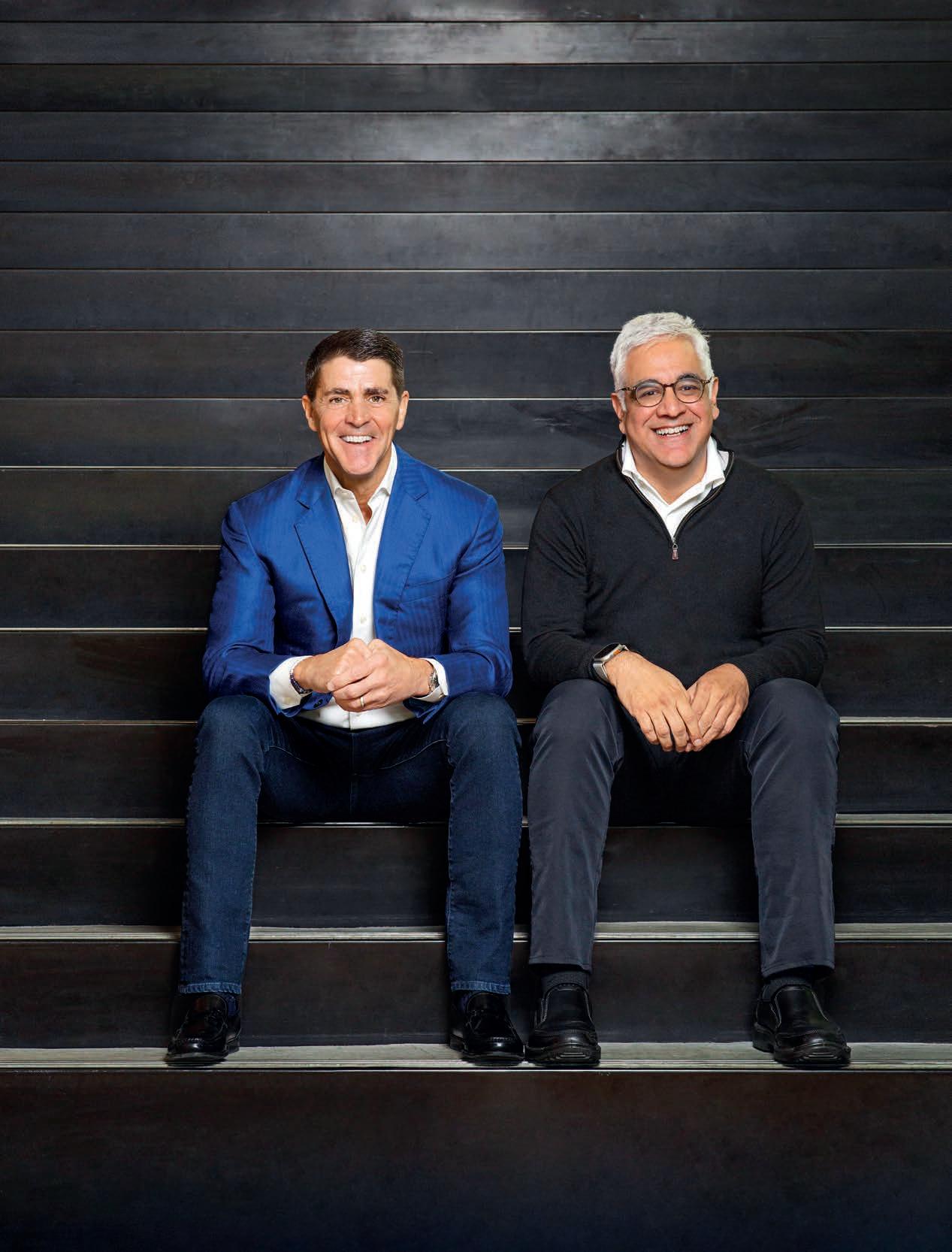
NHS: SEEKING UK’S SMART HOSPITALS INFOR: WHAT DOES A PAPER COMPANY KNOW ABOUT ERP?

THE MAGAZINE FOR ENTERPRISE APPLICATIONS AND ASSOCIATED TECHNOLOGIES
VOLUME 4ISSUE 14Q1 2023
UK | EMEA
Accelerate your journey to Oracle Cloud and transform with IBM’s cognitive and automation solutions, tailored by industry and business process domain.
Learn more oracle.com/partner/ibm/


+









































EDITOR
Paul Esherwood paul@erp.today
MANAGING DIRECTOR
Tony Little tony@erp.today
DESIGN DIRECTOR
Ceci Perriard ceci@erp.today
EDITORIAL DIRECTOR
Giacomo Lee giacomo@erp.today
HEAD OF OPERATIONS & EA
Lauren Tilbury lauren@erp.today
TECHNOLOGY EDITOR
Adrian Bridgwater adrian@erp.today
CHIEF STAFF WRITER
Stephanie Ball stephanie@erp.today
SENIOR STAFF WRITER
Sarah Thomas sarah@erp.today
DESIGNER
Jasmine Roberts jas@erp.today
COMMERCIAL MANAGER
Richard Carr richard@erp.today
YPN CO-ORDINATOR
Grace Barrington grace@erp.today
PR ANALYST
Melissa Evatt melissa@erp.today
OFFICE SUPPORT ASSISTANT
Michelie Blaney michelie@erp.today
TRAINEE
Ella Moloney ella@erp.today
EVENTS DIRECTOR
Hilary Campton hilary@erp.today
EVENTS PROJECT MANAGER
Leah Bradley leah@erp.today
TECHNOLOGY MANAGER
Lee Sherwood lee@erp.today
FEATURE WRITERS
Marc Ambasna-Jones, Christine Horton
PHOTOGRAPHY
Darren Miller

Joel Chant
EDITOR’S WORDS
What happens when AI stops CHATting to us and starts its own conversation?
Digital disruption started a decade ago; it gathered pace five years thereafter; and two years ago it exploded. Today, the pace of change is unlike anything we have seen before and it shows no sign of slowing. When technology leaders warned us that, ‘This is the slowest rate of change you will ever know’, I used to think it was a convenient marketing phrase designed to drive fear into CxOs who weren’t up to speed. Now it seems like an appropriate and astute prediction that is being played out in every domain on the planet. Technology has pervaded where, why and when we work and its influence will soon determine the ‘who’ (or the what) as well.
Generative AI is here and, as predicted in the very first article I wrote for ERP Today way back in 2018, it’s going to have a profound effect on us all. ChatGPT has already evolved into GPT-4 and will continue to morph towards AGI which could come as soon as tomorrow, or maybe as late as a few years down the road. While the timescales are unclear, what is certain is there is no putting the genie back in the bottle. We are now facing an inflection point, not just for business and commerce, but for humanity itself.
For as long as AI has been a topic for discussion, a small non-commercial cohort of people and organizations have pushed for tighter AI controls to prevent irresponsible development of a technology that we may not be able to control. Now more than ever, those safeguards need to be the primary focus for technology vendors that are battling it out for AI supremacy with little regard for the wider consequences.
As you would expect, AI is designed to be intelligent and at the moment we have some control over that intelligence because we are still the orchestrators. However, the recent transition to generative artificial intelligence is a cosmic leap towards artificial general intelligence and that is something that we should all be acutely cautious of. While a general intelligence algorithm would be a technical masterstroke, it couldand most likely would - lead to super intelligence. This would be an algorithm that was able to learn from raw data across a broad spectrum of domains, much like GPT4, and teach itself to become more intelligent at a rate that humans could not fathom - like Skynet in The Terminator. (That film is almost four decades old, by the way).
The notion of ring fencing this kind of super intelligent algorithm would be an impossible task, and hovering a finger over the ‘off button’ in case it all goes wrong is nonsense. Anything you have thought of, it has thought of too – and it’s already smarter than you are.
Presently generative AI is programmed with human values and it is not self-aware - although it can learn, it is not conscious. But, speak to a few sacked Google employees and ask them if we are lurching into a world where algorithms are on the brink of becoming sentient, and you may have second-thoughts about how much fun you are having asking ChatGPT supposedly harmless questions.
We’ve been promised transformative AI for decades. Now we’ve got it, do we really want it?
Chat carefully.
erp_today @erp_today erp-today ERP.TODAY
20-22 Wenlock Road, London, N1 7GU. Company No. 1164274 3 CALL US 0207 427 6056 ERP TODAY MAGAZINE LIMITED

CONTENTS ERP TODAY | UK/EMEA | Q1 2023




visit us ERP.TODAY 5 ARTICLES 09 News, Deals & Wins Industry news from across the enterprise apps sector 40 Cover story Aneel Bhusri, Carl Eschenbach and Workday 56 Infor, meet Koch What does a paper company know about ERP? 62 Battling uncertainty in a hybrid world 2023 may be the year of the employee 78 A tale of three hospitals Where are the UK’s smart hospitals? 84 Ditching the degree Why consultancies are removing big barriers to recruitment 92 Mining within 3D and ESG Celonis co-CEO Alex Rinke answers our questions 98 Prodding the way towards real sustainability Time to step away from tech dependency 102 The big clean up Welcome to data clean rooms 108 Leveraging digital for ESG leadership IFS sustainability chief gives the inside track 112 Sovereign cloud Keep your sovereign cloud safe from outside forces 120 Birth of fusion teams Driving business transformation with diversity 128 Tech redundancies: the bigger picture Mass layoffs are never a good look 132 A working ESG wonderland Unit4 on the business nirvana of flexible working 144 Enterprising events ERP Today attends the biggest software events this quarter 108 120 92 40 78

TICKETS ON SALE NOW!
The Trilogy Event
ASCOT RACECOURSE, 14 TH SEPTEMBER 2023
The 2023 event will be the final part of our trilogy and the last in the current format. We are firm believers that you must continually evolve and our 2023 event will be a fitting finale to our association with the NHS and NHS Charities Together.

The 2023 event coincides with the NHS’ 75th anniversary and the enterprise tech community has a unique opportunity to show our collective support for our NHS heroes while taking part in the industry’s biggest and best corporate event.

3,100 people connected and celebrated at Ascot Racecourse in 2022 and we are expecting many more than that on 14th September 2023.

ERPTODAYAWARDS.COM
THE ERP TODAY AWARDS & FUNDRAISER
Anniversary th 75


NEWS DEALS &WINS
Oracle delivers cloud for Uber in “landmark competitive win” for the vendor
BY STEPHANIE BALL
In a series of new and hefty contracts, Uber has announced a seven-year partnership with Oracle to drive new product innovations, modernize infrastructure and pump the accelerator on profitability.
The ride-hailing and delivery service goliath is set to migrate some of its most critical workloads to Oracle Cloud Infrastructure (OCI) and Oracle will also become a global Uber for Business client.
Oracle CEO, Safra Catz, named the deal a “landmark competitive win for OCI” and said: “Uber is expanding into a ‘go anywhere, get anything’ platform, and the company needed a cloud partner that shares a relentless focus on innovation.

“This is further validation of the momentum and acceleration we are experiencing in the market. Enterprises, governments and startups around the world are recognizing the differentiation of Oracle Cloud Infrastructure and experiencing our performance, security and economic benefits versus other hyperscalers.”
Back in December 2022, during Oracle’s fiscal second quarter announcement, chairman and CTO Larry Ellison
hinted at the success of signing “multiple customers to infrastructure contracts exceeding $1bn”. By the size of Uber, and the landmark seal of approval issued by Catz, it’s unconfirmed, yet very likely, that this Uber contract is one of the mystery deals.
But like many other firms, Uber is refusing to put its entire technology shopping list into one digital basket. Its tech stack is cloud hopping with an additional seven-year contract signed simultaneously with Google Cloud , as well as a pre-existing deal with AWS , which allows the firm to stream real-time analytics with Redis, AWS Fargate and Dash framework.
Uber CEO Dara Khosrowshahi has touted Oracle as the cloud provider that will deliver maximum innovation while reducing overall infrastructure costs. Uber and Oracle will also continue co-innovating on additional retail and delivery solutions, including last-mile logistics.
Meanwhile, Google has been earmarked as Uber’s go-to cloud provider to improve, reimagine and innovate the customer experience with Ads and the Google Maps Platform, data cloud
technologies, AI, ML, security and microservices.
“Uber is revolutionizing the way people, products and services move across continents and through cities,” said Khosrowshahi. “To deliver on that promise for customers while building value for shareholders, we needed a cloud provider that will help us maximize innovation while reducing our overall infrastructure costs. Oracle provides an ideal combination of price, performance, flexibility and security to help us deliver incredible customer service, build new products and increase profitability.”
It’s a tech stack that is becoming more complex by the deal. But with Oracle, Google and AWS jostling in Uber’s backseat, it’s also a further endorsement of the multi-cloud strategy that is being adopted by many of the world’s digitally-native companies. Uber makes its living by moving people around the planet and this new technology deal will allow the firm greater flexibility to deliver improved customer experiences. The key challenge for Uber will be to focus on its own destination in a more complex cloud environment.
visit us ERP.TODAY 9
Safra Catz
ALL CHANGE AT WORKDAY AS CEO BHUSRI PAVES WAY FOR SUCCESSOR
Workday has announced the appointment of Carl Eschenbach to co-CEO as part of a succession plan that will see Aneel Bhusri step back from the business. Chano Fernandez is also leaving Workday as of De-
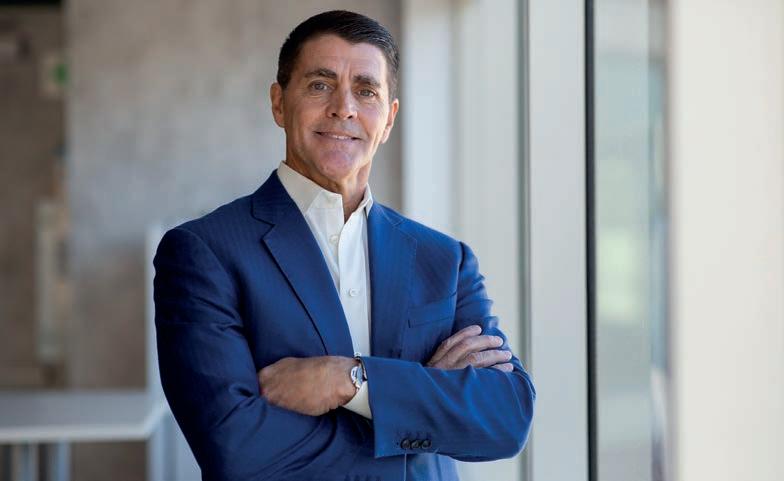
cember last year.
Eschenbach will serve as co-CEO alongside Bhusri, Workday’s co-founder and CEO, until January 2024, when it is expected that Eschenbach will assume control as sole CEO.

The new exec is a venture capitalist with strong
technology experience. He has been a partner at Sequoia Capital since 2016, having worked closely with high-growth, innovative enterprise software organizations.
Commenting on the announcement, Bhusri said: “We have an incredible op-
portunity in front of us and I’m confident that Carl, with his leadership skills and experience in helping technology companies scale, as well as his commitment to culture and values, will help lead Workday through its next phase of growth. Chano has been an integral part of Workday since he joined almost nine years ago and has helped us to achieve great success and growth. We thank him for his many contributions.”
Eschenbach added:
“I’ve long admired Workday and how it has redefined the enterprise software industry, with a focus on putting people at the center, a values-based approach to leadership and a relentless focus on customer service and innovation. I’m thrilled to be expanding my role at Workday and working with Aneel, the leadership team and our amazing group of employees to help us build on this great momentum and take hold of the massive opportunity in front of us.”
DE NOVO FORMS STRATEGIC ALLIANCE WITH RAPID4CLOUD
De Novo Solutions has entered into a strategic partnership with Rapid4Cloud to accelerate digital transformation and demonstrate its commitment to investing in leading technologies.
Rapid4Cloud uses AI and RPA technology which accelerates the process involved in implementing, managing and
Mark Sweeny
maintaining Oracle Cloud Applications.
This partnership will open new markets, create new customers and highlight the importance the company places on building strong relationships with leading enterprise technology innovators to significantly transform customer experience.
10 ERP TODAY | UK / EMEA | Q1 2023
NEWS DEALS &WINS
Carl Eschenbach
Projects don’t
ERP project delivery

Pre-project readiness checks
Project health checks
Project governance and controls







Virtual Project Management Office
Specialist ERP project teams









need
to be an uphill struggle


We help all kinds of private and public sector organisations plan and deliver their ERP projects successfully. Our experts work as part of your team to guide you through the complexities, enabling you to control the pace, quality and timescales of your system implementation.

enquiries@quitelaterally.co.uk FOLLOW US on LinkedIn for news of our upcoming webinars on how to get your project off to a great start! www.linkedin.com/company/quite-laterally www.quitelaterally.co.uk
IFS has announced its financial results for the full year, marking the fifth consecutive year the company has secured strong double-digit revenue growth.
Software revenue grew by 28 percent year-on-year to SEK 6.6bn. Cloud revenue growth was up 80 percent as existing and new customers switched to IFS Cloud, ac-
High five: IFS sees double-digits for fifth consecutive year
celerated with the launch of Arcwide in April last year.
Annual recurring revenue was up 57 percent YoY, with the rise driven by bookings from new customers. Net revenue was SEK 8.4bn, representing a 19 percent increase
2022 was characterized by acceleration. We have reached a landmark $1bn revenue.
on 2021 figures. The firm attributes its success to its evergreen model, with its twice-yearly release cycle allowing IFS more than 10,000 customers to adopt regular updates while negating the need for costly upgrades. New customers are currently av-
eraging 9.5 months from contract to value.
The IFS partner ecosystem also grew 65 percent YoY, and participated in over 50 percent of implementations, with over two-thirds of its largest partners signing up to the IFS partner success program following its launch in Q1 2022.
The 2022 financial year also saw IFS win several awards for its software, notably ERP Today’s Vendor of the Year Award, and, for the ninth year running, the Gartner Magic Quadrant for Field Service Management.
IFS CEO Darren Roos said: “For IFS, 2022 was a year characterized by acceleration. We increased our headcount to over 5,500 employees, reached a significant landmark in revenue at $1bn and outpaced our competitors by delivering double-digit growth for the fifth consecutive year."
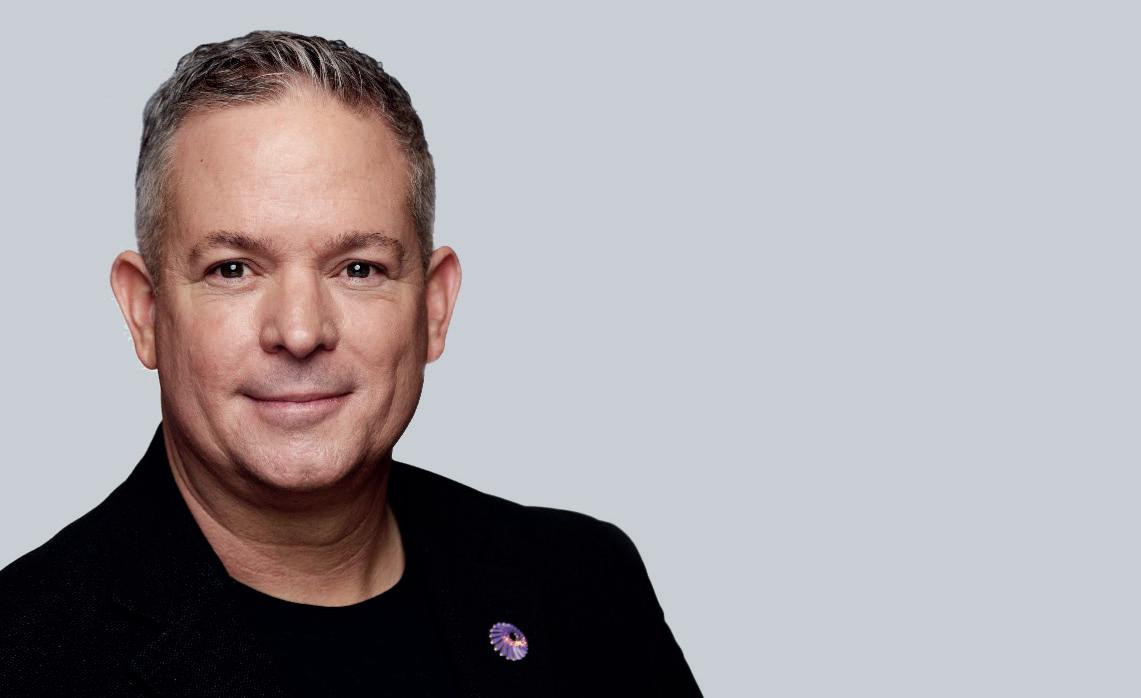
Samsara swings three-year high with headcount swell
Samsara has announced its fourth quarter financial results, reporting quarterly growth at its highest in three years and a 40 percent headcount swell.
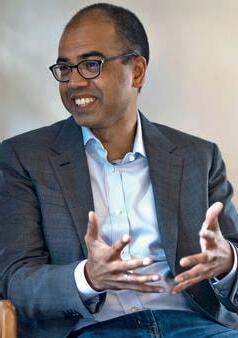
Q4 revenue grew 48 percent, reaching $186.6m and bringing full fiscal year revenues to $652.5m, up 52 percent year-on-year.
Annual recurring revenue
(ARR) reached $795.1m, increasing by 42 percent YoY, and showing the gains of the firm’s continued investments in the physical operations market. Going against the industry grain, a rise in customer demand has seen Samsara boost its headcount team in fiscal 2023 to over 2,200.
Samsara added over 400 more large customers to the fold this year, with
over 1,200 accounts now reaching over $100,000 in ARR, a 53 percent rise YoY. Operating losses shrank significantly, reducing to $60m in Q4, and for the full fiscal year down to $259.5m, a $94.3m difference YoY.
Guidance for Samsara’s full fiscal year 2024 expects revenues between $838-$848m, representing 28-30 percent growth YoY.
12 ERP TODAY | UK / EMEA | Q1 2023 NEWS DEALS &WINS
Darren Roos
Sanjit Biswas
ServiceNow reveals partner program transformation

ServiceNow has unveiled a major partner program transformation to further partner growth and customer success.
The multi-year vision supports the $500bn market opportunity for the Now Platform and associated partner services with a redesign of the company’s partner program, featuring a new partner development fund amongst other incentives and benefits.
The new ServiceNow Partner Program includes four new distinct modules for build, consulting and implementation, resale and service provider partners. New incentives
will enable partner growth through maximized investments and opportunities to demonstrate expertise. Additionally, the partner experience will see enhancements such as a ‘partner finder’ that allows customers to choose the right partner best suited to their business.
SERVICENOW PARTNERS SHOULD BE TREATED AS CO-CREATORS OF VALUE AND AS CO-PILOTS ON OUR JOURNEY
Erica Volini, senior vice president of alliances and channel ecosystem at ServiceNow, said: “The vision for ServiceNow partners is that they should be treated as co-creators of value, and as co-pilots on our journey to becoming the platform for digital business.”
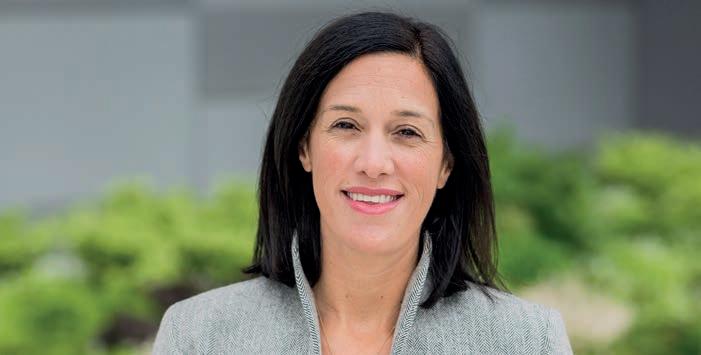

Unit4 launches new Marketplace platform
Unit4 has launched Unit4 Marketplace, a new platform where its ISV, reseller and service partners can showcase their innovative, bespoke industry and vertical apps that link to
Unit4’s ERP solutions. The Unit4 Marketplace will launch with nine of the company’s global partners and will enable customers to quickly extend the capabilities of their
existing Unit4 solutions with ready-made integrations. Customers will be able to access a catalog of apps, visible through a single and filterable storefront.
Emma O’Brien
EMBRIDGE CONSULTING SELECTED FOR NEWLY LAUNCHED G-CLOUD 13 FRAMEWORK
Embridge Consulting has announced that public sector organizations can now find its services on the G-Cloud 13 framework. This latest iteration of the cloud services framework will provide cloud hosting and software services to support UK central government departments and other public sector bodies.
G-Cloud 13 builds on the benefits of the previous frameworks, providing access to multiple suppliers and cloud services, access to the latest cloud technology and innovation and improved competition and pricing.
visit us ERP.TODAY 13
Erica Volini
Mike Ettling
If you’re just keeping up, you’re standing still.
Businesses everywhere are facing unprecedented change, and the future will be dictated by those who innovate first.
RISE with SAP offers your business the cloud solutions and industry expertise to drive innovation together. Across your entire business. With speed and agility, in the cloud. So your business can shape the future. And let your competition try to keep up with you.
Driving business innovation together. Learn more at sap.com/RiseTogether


SAP drives continued cloud momentum with Q4
SAP has announced its Q4 and FY 2022 results, with figures suggesting continued results are coming from the cloud.
The full year saw total revenue up 11 percent to €30.8bn, and cloud revenue up 33 percent to €12.5bn.
2022 saw S/4HANA cloud revenue up 91 percent to €2bn, with backlog rising 84 percent to over €3.1bn.
Q4 S/4HANA cloud revenue further consistently accelerated, up to 101 percent.
At year-end, current total cloud backlog exceeded €12bn for the year, up 27 percent. The figure is stated to be €62m lower due to SAP’s decision to wind down its business operations in Russia and Belarus.
IFRS cloud gross profit grew 38 percent for the year, while non-IFRS cloud gross profit rose 37 percent.
Elsewhere, software licenses revenue fell 37 percent to €2bn for 2022.
Despite lower software licenses revenue, cloud and software revenue rose ten percent to €26.5bn. Services revenue was up 16 percent to €4.3bn.
IFRS operating profit stayed flat at €4.6bn, and non-IFRS operating profit was down two percent to €8bn for the year, despite a fourth quarter lift.
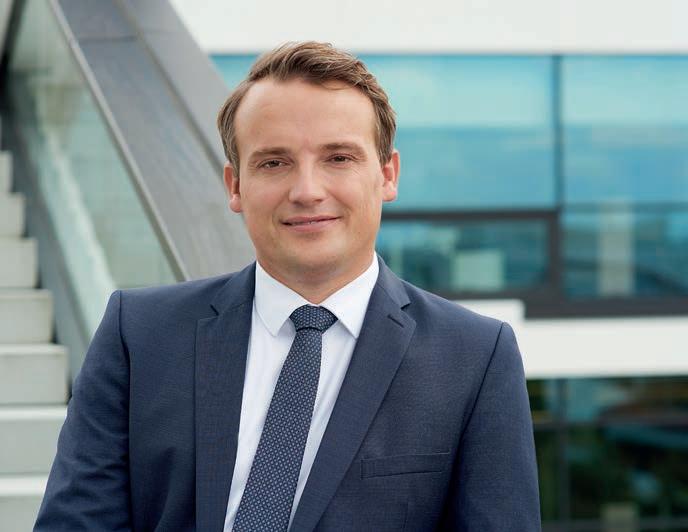
For 2022, IFRS earnings per share (EPS) decreased 56 percent to €1.96 and non-IFRS EPS decreased 39 percent to €4.08. The decline is said to reflect a contribution to financial income by Sapphire Ventures that, mainly due to market conditions, was significantly lower this year.
SAP’s 2023 outlook anticipates accelerating top line and double-digit non-IFRS operating profit growth, with targeted restructuring reflecting a focus on strategic growth areas and accelerated cloud transformation.
HPE delivers recordsetting results for Q1
HPE has revealed its highest first-quarter performance since 2016 with revenues of $7.8bn up 12 percent, 18 percent for adjusted currency.
The earnings were boosted by record performances from Intelligent Edge and High Performance Computing and AI, which both reached $1.1bn in revenues in Q1, rising 25 and 34 percent respectively yearon-year. Compute revenue also increased 14 percent YoY bringing in $3.5bn for the quarter.
Additionally, the HPE GreenLake hybrid cloud platform powered a 26 percent rise in annual recurring revenue for the firm, exceeding $1bn for the first time.
The HPE board of directors declared a regular cash dividend of $0.12 per share on the company’s common stock, payable on April 14, 2023, to stockholders of record as of the close of business on March 17, 2023.
Q2 fiscal 2023 revenue is estimated between $7.1bn –$7.5bn, raising the fiscal 2023 revenue growth predictions to 5-7 percent adjusted for currency.

16 ERP TODAY | UK / EMEA | Q1 2023 NEWS DEALS &WINS
2022 SAW S/4HANA REVENUE UP 91 PERCENT TO €2BN, WITH BACKLOG RISING TO €3.1BN.
Antonio Neri
Christian Klein
PwC and SAP strategy supports ESG enterprise targets

PwC and SAP have joined forces in a coinnovation strategy to help enterprises make sustainability an integral part of standard business operations.
This strategy builds upon the existing alliance between SAP and PwC and creates co-innovated solutions to enable businesses to apply ESG metrics through their operations.
Helping operationalize sustainability, the new strategy will support the incorporation of ESG measures directly into business functions, such as trading, capitalization and tax.
The enterprise tools being leveraged for these solutions include: PwC’s ESG and accounting expertize,
SAP Cloud for Sustainable Enterprises, SAP Sustainability Control Tower and the SAP Product Footprint Management. All of these will assist in enhancing carbon measuring, reporting and steering, supply chain decarbonization, climate risk and competitive analysis, third-party risk management and compliance.
Bob Moritz, global chairman at PwC, said: “ESG has become a business imperative and is central to PwC’s global strategy, The New Equation, which aims to help clients build trust with their stakeholders and deliver sustained outcomes. New ESG reporting and disclosure requirements are being established, and greater transparency is criti-
cal to building trust.”
Christian Klein, CEO and member of the executive board at SAP SE, said: “The key to every organization’s ability to reach their sustainability goals and drive positive change is transparency. Our collaboration will combine the deep
industry expertize and customer insights of PwC with our leading sustainability technology portfolio. The resulting ESG transparency will help companies reinvent their business models and deliver the sustainable outcomes the world urgently needs.”
SALESFORCE PUSHES PROFITS IN STRONG SHARE-BOOSTING Q4
Salesforce has announced compelling results for its fourth quarter and full fiscal year ending January 31 2023, causing shares to leap up 16 percent.
The company reported total fourth quarter revenue at $8.38bn, an increase of 14 percent year-on-year. Additionally, FY23 revenue was reported at $31.4bn, up 18 percent YoY.
Salesforce’s fourth quarter GAAP operating margin was 4.3 percent, non-GAAP reported at 29.2 percent. Its fiscal 2023 GAAP operating margin was 3.3 percent with non-GAAP being 22.5 percent.
The company returned a total of $2.3bn in fourth quarter and $4bn in FY23 to shareholders in the form of share repurchases, with news its Share Repurchase Program has increased to $20bn.
Marc Benioff, chair and CEO of Salesforce, said: “Now we immediately put into place an accelerated transformation plan; restructuring the company. Our profitability is up, and we are not done. We’re reigniting our performance culture and doubling down on our accountable management of our sales organization.”
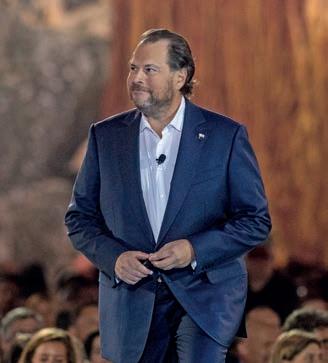
visit us ERP.TODAY 17
Marc Benioff
Kroger groceries well-stocked with Google Cloud and Deloitte
Google Cloud and Deloitte have entered into a strategic collaboration with Kroger to help the grocery chain use cloud technologies to increase productivity across its nearly 2,800 stores nationwide.

Kroger has previously deployed a variety of Google Cloud analytics, AI and ML tools under an application framework codeveloped by Deloitte and Kroger.
The grocery giant worked with Google Cloud and Deloitte to create two purposebuilt applications to enhance productivity and boost customer experience. The first
is a new task management application, and the second is Kroger’s new store management application, empowering store leaders to be less dependent on paper tools. The app provides employees with a standardized audit checklist to ensure a high-quality shopping experience for customers.
These new applications leverage Google Cloud technologies used by Deloitte to build a modern, eventdriven architecture for the retailer. Technologies utilized include AI and ML, Spanner and Dataflow for enhanced workflows and task optimization.
Karthik Narain
Accenture partners with AWS to launch Velocity enterprise cloud platform
Accenture has launched Velocity, a jointly funded and co-developed platform with Amazon Web Services (AWS).
The new platform enables a 50 percent faster adoption of Accenture and AWS innovations and optimized business outcomes. The quicker time to innovation will occur by removing the complexity associated with building and operating enterprise-scale applications and estates in the cloud.
Velocity will be sold via a subscription service to provide cost-effective access to features that include: a technology fabric to create enterprise-scale cloud-first environments for specific business requirements, accelerators with automated blocks of deployable code and pre-integration features, and a set of asset, methodology and process activators to ease technology and talent hurdles.
Karthik Narain, global lead of Accenture Cloud First, said: “Velocity will bring AWSpowered industry, cross-industry, and technology solutions to market faster, with more repeatability and at a lower cost. It’s the essence of innovation powered by the shared experiences of Accenture and AWS.”

18 ERP TODAY | UK / EMEA | Q1 2023
NEWS DEALS &WINS
TWO PURPOSEBUILT APPLICATIONS FOR PRODUCTIVITY AND CUSTOMER EXPERIENCE

INVEST IN PEOPLE OR INVEST IN TECH? SATISFY SHAREHOLDERS OR SATISFY CUSTOMERS? SAVE OR GROW? YES. © 2023 ServiceNow Inc. All rights reserved. Today, businesses everywhere are facing tough choices. But what if you didn’t have to choose? Our unifying platform is the great simplifier, helping you say YES to leveling silos that stand in the way of your people. YES to every person, system, and process working together harmoniously. YES to working with what you have, unlocking value in days and weeks, not months and years. YES to digital solutions that deliver the agility, scalability, and simplicity your business needs now — and for what’s next. Discover the many ways we can help you put YES to work. ServiceNow.com/YES DISCOVER THE UNIFYING PLATFORM FOR DIGITAL BUSINESS THAT LETS YOU DO BOTH.
Santander and Salesforce to help UK businesses expand overseas
Santander UK is leveraging Salesforce technology to power Santander Navigator, its digital platform designed to help UK businesses expand internationally.
Launched last year, this platform brings together an international ecosystem of expertize and knowledge to help businesses overcome traderelated obstacles and understand the attributes of doing business in a new market.
Santander Navigator is designed to help small and mid-sized UK businesses navigate international expansion opportunities. The subscription-based platform leverages Salesforce technologies including Experience Cloud, Commerce Cloud, and Marketing Cloud, providing customers with a personalized service, based on individual needs.
Zahra Bahrololoumi, CEO, Salesforce UKI, said: “Supported by Salesforce technology, Santander is accelerating its transformation into a digital bank focused as much on the future as its customers.

“The Santander Navigator platform uses automation, intelligence, and real-time data to deliver smart, tailored customer experiences at scale and brilliantly fits Santander’s
ambition for a simpler way of serving its customers. It’s hugely exciting to be helping Santander create a new, consistent standard for banking that will drive growth and personal impact for customers all over the world.”
John Carroll, head of international and transactional banking, Santander UK, said: “Businesses that trade internationally are growing faster than companies that are purely focused on their home market.
“We want to enable more businesses to benefit from opportunities to expand overseas and encourage new ones to start their international journey by removing barriers and by making the process easier. We have developed a platform that is genuinely different and helps companies to grow while they save time and money.”
Phil Mottram
HPE ACQUIRES AXIS SECURITY IN WAR AGAINST WFH CYBER THREATS
HPE has entered into a definitive agreement to acquire Axis Security, a cloud security provider. The acquisition will enhance HPE’s edge-to-cloud security capabilities by offering a unified secure access service edge solution to combat the rising cyber threats posed as more people work from hybrid and remote locations.
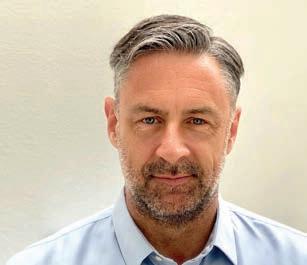
The Axis Security platform, Security Services Edge (SSE), allows access to corporate and public cloud resources and will build on the existing HPE cloudbased security networking company, Aruba, and its Software-Defined Wide Area Network. Further SSE platform features include authenticated user access at network edge, a secure web gateway, a cloud access security broker and digital experience monitoring. Answering the increased demand for integrated networking and security solutions delivered as-aservice, the new offering will provide a scalable solution to customers for a single monthly subscription.
The transaction is expected to complete by the end of Q2 of the HPE 2023 fiscal year.
20 ERP TODAY | UK / EMEA | Q1 2023 NEWS DEALS &WINS
IT’S HUGELY EXCITING TO BE HELPING SANTANDER CREATE A NEW, CONSISTENT STANDARD FOR BANKING
Zahra Bahrololoumi
Team Embridge is growing and to support our continued success we’re looking for talented, passionate and collaborative individuals to join our sales and marketing team







Senior Sales Account Managers

We’re looking for two sales account managers with an entrepreneurial spirit, proven track record and the ability to help take our business to the next level. These roles are hands-on working with customers but also require strategic thinking to create long-term sales plans. They also require significant experience selling Unit4 (or other leading ERP software solutions), proven success in growing companies and applicants should have either been employed by or competed against public sector ERP/Finance system providers in complex selling scenarios. These are new roles in a growing team so there is opportunity to achieve key wins and influence our ongoing success.
Marketing Campaign Specialist











We need a creative, organised and pro-active individual to help deliver demand and lead generation activity that supports pipeline generation and brand awareness in line with our growth goals. This role is primarily responsible for successfully devising and managing a compelling programme of B2B marketing campaigns, but there will be plenty of opportunity to get involved in a variety of activities as we continue to refine our go-to-market proposition. Working across the full marketing mix, this is a hands-on role in a dynamic team with the opportunity to collaborate with other business functions and have real and immediate impact.
Apply by email to: resourcing@embridgeconsulting.com
This is an exciting time to join a passionate and rewarding team, to make a difference and to influence the company’s success. You can find all our current job vacancies at embridgeconsulting.com/vacancies
“If everyone is moving forward together, then success takes care of itself.”
Henry Ford
Satya Nadella
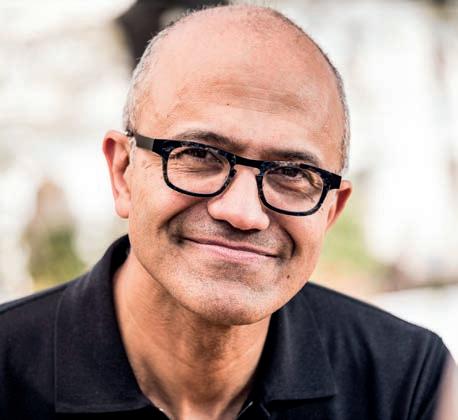
Microsoft Q2 earnings scrape by expectations
Microsoft has beaten earnings per share expectations with $2.30, adjusted to $2.32 non-GAAP for the period ending December 31, 2022.
However, revenue, despite a two percent increase from the same period last year, was reported at $52.7bn, missing the expected $52.9bn forecast and representing the smallest quarterly increase in more than six years.
Operating income was $20.4m GAAP and net income $16.4m, falling by eight and 12 percent respectively.
Cloud drove profits for the firm this quarter, as intelligent cloud revenue grew 18 percent, to $21.5bn against an expected $21.4bn. Server products and cloud services revenue increased 20 percent with Microsoft Azure reported as the key growth driver, showing revenue gains of 31 percent.
Productivity and business processes revenue was reported at $17bn against an expected $16.8bn, with seven percent growth. LinkedIn revenues grew by ten percent, and Dynamics products and cloud services revenues additionally rose by 13 percent.
EY LAUNCHES EY RETAIL INTELLIGENCE FOR MICROSOFT CLOUD BUILDS
EY has launched a new EY Retail Intelligence solution, building on Microsoft Cloud and Cloud for Retail, providing customers with a streamlined shopping experience.
The new solution facilitates the complete customer journey and uses Microsoft Cloud and Cloud for Retail, leveraging AI, image recognition and analytics technology to collect data across all channels and turn it into valuable insights.
The solution enables all channels to access the same data about customers, guaranteeing retailers a 360 degree view.
UIPATH DRIVES RECORD Q4 MOMENTUM WITH REVENUE WINS

UiPath has reported fourth quarter revenue of $308.5m, exceeding expectations with an increase of seven percent year-on-year, and a fullyear fiscal 2023 revenue of $1.059bn, increased 19 percent YoY.
The strong results caused shares to leap 15 percent in after hours trading.
Annual recurring revenue (ARR) for Q4 beat expectations, reaching $1.204bn, a 30 percent
rise YoY. Net new ARR brought $278.6m to the books, while co-CEO Rob Enslin announced a re-
cord 229 customer wins with $1m+ in ARR. Non-GAAP operating income for Q4 was
$69.2m with a non-GAAP adjusted free cash flow of $101.2m. GAAP operating loss was $45.1m for the quarter, bringing total losses for the fiscal year to $348.3m; however, this shows improvement from $525.5m for the year prior.
For 2024, revenue is predicted in the range of $1.253–$1.258bn for the full fiscal year.
Co-CEO Daniel Dines also hinted at Clipboard AI and other AI innovations to come at UiPath’s forthcoming AI summit.
22 ERP TODAY | UK / EMEA | Q1 2023
NEWS DEALS &WINS
xxxx
S/4HANA
Switch to the Next-Generation ERP System!
KPS successfully delivers large scale transformations, all over Europe, across many well-known brands who want to derive extensive business return and agility, just like you do.


Open up new horizons for your business with KPS and SAP S/4HANA
Coop Denmark
Largest S/4HANA transformation in the Nordics
Find out how KPS helped Coop transform their business

NEWS DEALS &WINS
Belfast Harbour sets sail with Oracle Fusion Cloud ERP
HPE TO AUTOMATE REPRODUCIBLE AI-AT-SCALE WITH PACHYDERM
HPE has expanded its AI-at-scale offerings with the acquisition of Pachyderm to automate reproducible machine learning pipelines that target large-scale AI applications.
HPE can unlock AI-at-scale oppor tunities for customers by bringing together its supercomputing technologies that are foundational for optimized AI infrastructure and the HPE Machine Learning Development Environment.

The combined solution enables users to train more accurate AI models faster and at scale, on supercomputers that have been purpose-built for demanding AI workloads.
Belfast Harbour has selected Oracle Fusion Cloud ERP and Oracle Fusion Cloud Enterprise Performance Management (EPM) to streamline its business operations and drive new growth.
With Oracle Cloud ERP, Belfast Harbour will be able to increase productivity, reduce costs and improve controls, while EPM will enable the organization to better connect operational and financial data across its HR, sales, finance and procurement functions, improving insights and enhancing busi-

ness modeling and planning. Additionally, Oracle’s quarterly updates will help Belfast Harbour tap into a continuous stream of innovation and advanced automation capabilities on a regular basis.
Maurice Bullick, finance and compliance director, Belfast Harbour, said: “A more efficient and flexible business operation is critical for us to sustain our growth trajectory. Oracle will help us connect data across the organization, enabling us to have better visibility of our business and adapt and scale our operations at the pace that we require.”
HPE will integrate Pachyderm’s reproducible AI capabilities in one integrated platform to deliver an advanced data-driven pipeline that automatically refines, prepares, tracks and manages repeatable machine learning processes used throughout the development and training environment.
Justin Hotard, executive vice president and general manager, HPC and AI at HPE, said: “As AI projects become larger and increasingly involve complex data sets, data scientists will need reproducible AI solutions to efficiently maximize their machine learning initiatives, optimize their infrastructure cost and ensure data is reliable and safe no matter where they are in their AI journey.”
Gulfsands move to multi-tenant financial cloud with Infor

Energy company Gulfsands has selected Infor SunSystems Cloud as its financial platform to enhance business processes.
Gulfsands will benefit from enhanced security, reduced risk and a smaller physical and environmental IT footprint, enabling greater resource availability and focus on its core business goals.
Based in London, Gulfsands opted for a cloud deployment to update functionality and business capabilities with the latest version of SunSystems, taking advantage of having no physical servers, with reduced risk and cost.
24 ERP TODAY | UK / EMEA | Q1 2023
Justin Hotard

Accenture invests in Cosmo Tech digital twin technology

Accenture has made a strategic investment in Cosmo Tech, a global provider of digital twin simulation and optimization technology.
The agreement through Accenture Ventures took place during the first phase of the company’s Series C fundraising. It joins other Project Spotlight investments from late last year, including Planet Labs PBC for climate solutions and BehaVR for digital wellness.
Cosmo Tech’s 360˚ Simulation Digital Twin platform allows organizations to test business changes in order to see the potential short and long-term impact. The cloud-native platform uses data from current systems to test various scenarios and automatically determine an optimal action plan, enabling organizations to find new ways to reduce costs, improve resiliency and efficiency and lessen environmental impact.
Founded in 2010, Cosmo Tech’s solutions have helped organizations increase profit by five percent across complex supply chains and cut capital and operating expenses by 10-15 percent.
IBM LAUNCHES IBM PARTNER PLUS
IBM has launched IBM Partner Plus, a program created to empower partners to help clients automate, secure and modernize their businesses.
Partner Plus aims to strengthen technical expertise and help speed time to market with access to IBM resources, incentives and tailored support. Designed to fuel growth for new and existing partners, Partner Plus puts partners at the forefront of IBM’s go-to-market strategy, acting as a catalyst for capturing the $1tn hybrid cloud and AI market.
John Granger
Snowflake reports 54 percent growth in Q4

Fourth quarter results from Snowflake reported $555.3m in product revenue for the data cloud company, representing 54 percent year-on-year growth.
Fiscal year 2023 saw Snowflake achieve 70 percent YoY product revenue growth, totaling $1.9bn.
In its forecast for the first quarter of fiscal 2024, Snowflake’s
product revenue is expected to fall between $568-573m, falling short of analyst anticipation. Stocks fell 6.8 percent accordingly following the results announcement.
The Q4 report revealed a total of 7,828 customers for the company, and a net revenue retention rate of 158 percent. 330 of those customers boast trailing 12-month product rev-
enue greater than $1m.
During fiscal 2023, Snowflake added approximately 1,900 net new employees, and plans to add 1,000 more in the new fiscal year, going against the current layoff curve in tech. Frank Slootman, chairman and CEO, commented that Snowflake is “staying on track for our $10bn product revenue goal in fiscal 2029”.
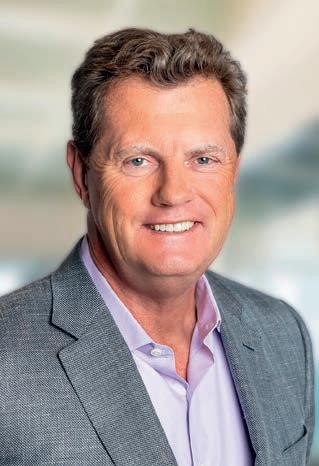
26 ERP TODAY | UK / EMEA | Q1 2023
NEWS DEALS &WINS
Frank Slootman
Can your ERP make every pound pay dividends? Ours can.
















Unit4 ERP equips your organization with the processes, data visibility, and control that lets your people do better work.
Unit4 Source-to-Contract by Scanmarket equips your organization with complete control over procurement – letting you precisely control spending and make strategic decisions that add value.


Visit unit4.com today to see why pairing Unit4 ERP and S2C is money well spent.

NEWS DEALS &WINS
Workday overshoots in Q4 gaining ground on $10bn target
Workday has announced financial results for its fiscal fourth quarter ended January 31, 2023, with revenue wins bringing the vendor closer to its 2025 $10bn target.
Total revenues jumped 21 percent, reaching $6.22bn and showcasing consistent growth over the year.
Quarterly revenues rose 19.6 percent to $1.65bn in Q4 yearon-year.
Q4 subscription revenues increased 21.7 percent to $1.5bn, matching the announcement from coCEO Aneel Bhusri that the company reached 10,000 customers globally this quarter.

Subscription revenue backlog continued to overshoot 20 percent growth targets. The two-year backlog increased 21.3 percent
to $9.68bn, bringing the total subscription revenue backlog to $16.45bn, a 28.4 percent increase YoY.
Despite Q4 operating losses shrinking almost two points YoY to $89m, losses for the full fiscal year grew to 3.6 percent YoY, reaching $222.2m.
Operating cash flows
grew to $1.66bn and cash, cash equivalents and marketable securities almost doubled YoY from $3.64bn to $6.12bn as of January 31, 2023.
Looking ahead, Workday is doubling down on AI and ML investment through Workday Ventures, having announced a $250m expansion of the fund to focus on larger growth areas such as generative AI. The firm will also continue to branch into SME, niche industry and EMEA markets.
“We closed our fiscal year with another solid quarter,” said Bhusri.
“Despite the unpredictable environment, we remain well-positioned to drive the future of work for our more than 10,000 customers thanks to our amazing employees and unique approach to embedding artificial intelligence and machine learning into the very core of our platform.”
MMI HOTEL GROUP CHECKS INTO THE CLOUD WITH INFOR
MMI Hotel Group has selected Infor Hospitality to provide hospitality management and pricing solutions for its expanding property base.
MMI will have access to cloudbased tools that will allow the teams to better serve guests and achieve competitive positioning through dynamic pricing strategies.
Via the Infor HMS Property Management Platform, Infor will provide MMI with access to valuable incoming data, allowing teams to better track guest preferences, simplify reservations and provide consistent quality and services.
Salesforce introduces Commerce Cloud to maximize revenue

Salesforce has revealed its new commerce innovation to help organizations across industries streamline operations, maximize revenue and drive loyalty.
Commerce Cloud
unifies customer and order data, creating a connected and personalized buying experience for businesses and consumers across marketing, sales and service touchpoints.
Organizations in
various sectors such as healthcare, technology, manufacturing and automotive can benefit from personalized D2C experience and B2B channels, reduced fulfilment costs and automated selling.
28 ERP TODAY | UK / EMEA | Q1 2023
Aneel Bhusri
IBM hits highest growth in a decade with mid-digit push
IBM has announced its financial results for 2022, with success across business segments producing the highest revenue growth in a decade for the firm. A six percent rise has seen revenues of $60.5bn for the full year and $16.7bn for Q4.
Hybrid cloud revenues reached $22.4 billion for 2022, up 11 percent year-on-year.
The firm’s Q4 software revenues rose 2.8 percent to $7.3bn and its hybrid cloud and solutions grew by five percent.
Of IBM’s software segment for Q4, Red Hat grew ten percent and automation, data and AI, and security all rose by four percent. Only transaction processing fell, shrinking by three percent.
Consulting revenues saw modest Q4 growth of 0.5 percent, bringing in $4.8bn for the quarter.
Infrastructure saw Q4 revenues
of $4.5bn, growing 1.6 percent, and led by a 16 percent rise for IBM zSystems. Hybrid infrastructure also brought six percent growth.
Cash flow for the year was $9.3bn, sitting below its target of $10bn due to higher-than-expected working capital needs. Net cash from operating activities was $10.4bn.
Strategic partners bookings also grew over 50 percent for the year, with SAP, Microsoft and AWS all bringing in over a billion dollars in revenue. 2022 saw eight acquisitions across IBM’s software and consulting divisions.

Looking ahead, the company expects the constant currency revenue growth to stay consistent with its mid-single digit model for 2023, projecting $10.5bn in consolidated free cash flow, which would result in growth of more than $1bn year-on-year.
WIPRO LAUNCHES CYBERSECURITY CONSULTING IN EUROPE
Wipro is launching strategic cybersecurity consulting in Europe as part of the firm’s vision to build a global cybersecurity consulting offering to help clients stay ahead of a dynamic threat and regulatory environments.
The consulting capabilities will expand on Wipro’s existing cybersecurity services and enable clients to tap into Wipro’s full set of capabilities.
Wipro CRS Europe will help clients realize enhanced scale and speed in implementations by leveraging Wipro’s global network of over 9,000 cybersecurists.
VERSION 1 ACQUIRES ORACLE EPM FIRM QUBIX
Version 1 is teaming up with Qubix, continuing its streak of successful UK-based Oracle acquisitions, and strengthening the company’s customer base and expertize.
This partnership has placed Version 1 as the largest Irishfounded technology employer, and brings them over 25 years of experience from Qubix. Combined, the companies’ 3,000+ employees will offer services to over 650 customers.
However, following the acquisition, CEO Julian Owens and group director of strategy and growth Paul Johnston will step down.
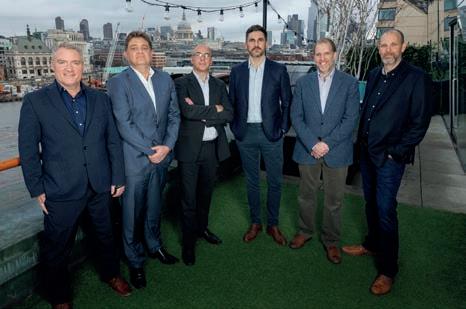
visit us ERP.TODAY 29
From left to right, Andrew Mason, Richard Pepper, Matt Yorke, Kevin Ryan, Neil Sellers and Colm Gillard
IBM EXPECTS GROWTH TO STAY CONSISTENT WITH ITS MID-SINGLE DIGIT MODEL FOR 2023, PROJECTING $1BN GROWTH.
One of the world’s largest mining and infrastructure solutions providers, Orica has entered into a global alliance with UiPath to scale Orica’s application testing and automation capabilities and drive enterprisewide process efficiencies.

The firm worked with Accenture as an advisor, and selected UiPath as its technology partner of choice for application testing and enterprise automation.
Orica will deploy the UiPath Test Suite solution to add further capabilities to its S/4HANA software,
UiPath
partnership enables deep digital mining
Alphabet, Google’s parent company, has announced its Q4 financial results, revealing missed targets with total revenue at
including business-wide automation, robotic process automation technology and testing capabilities. The implementation will provide Orica with a unified environment across different groups.
With UiPath, the company will automate application testing, allowing quality assurance teams to identify and address any underlying issues before deployment without impacting existing workflows. This allows Orica to transform testing from a cost center to a value center, minimizing the cost and risk associated with new
software investments.
“We see automation as a strategic priority that will help accelerate Orica’s business transformation, value and growth,” said Chris Crozier, CIO at Orica. “With a proven track record of success in supporting other global organizations, we are confident that UiPath is the trusted partner that can best support our automation journey and maximize our investments in digital transformation.”
ADDING TO S/4HANA WITH AUTOMATION, TESTING AND RPA
Rob Enslin, co-CEO at UiPath, said: “We are excited to partner with Orica to scale their application testing and automation capabilities and drive enterprise-wide process efficiencies. “This partnership also reinforces our commitment to help enterprises like Orica to move beyond legacy systems and scale their digital capabilities in line with a rapidly changing application ecosystem.”
Google sights on AI as Q4 misses mark
$76.05bn against an expected $76.53bn, prompting stocks to drop four percent.
Google Cloud brought in $7.3bn, less than expected,
although up 32 percent. Cloud losses almost halved from $890m to $480m year-on-year. Ad revenue dropped from $61.2bn to $59bn year-on-year.
Going forward, Google’s sights are set on developing its AI search engine in competition with the Microsoft ChatGPT investment.
30 ERP TODAY | UK / EMEA | Q1 2023
Orica and
global
NEWS DEALS &WINS


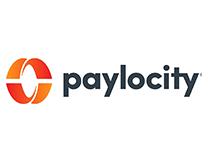
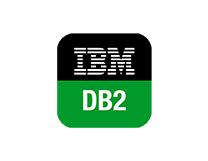



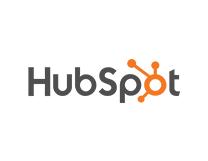

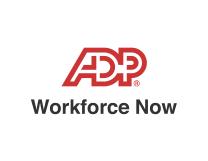
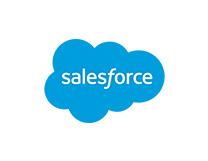





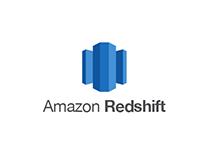
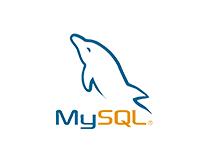




SERVICENOW Q4 RESULTS CHIME WITH LEADERSHIP OPTIMISM
ServiceNow has announced a positive Q4, with results exceeding GAAP guidance.
Revenues saw 20 percent year-on-year growth to
$1.9bn, and subscription revenues were $1.8bn, rising 22 percent.
Customer numbers increased to 1,637, equalling over $1m in annual
contract value, and current remaining performance obligations (cRPO) were $6.9bn as of Q4 2022, seeing 22 percent YoY growth. Net new annual contract value
(NNACV) contribution to cRPO also outperformed company expectations in Q4, driven by over 30 percent NNACV growth YoY from new logos.
ServiceNow has additionally announced a program aimed at tapping into the estimated $500bn market opportunity for the Now Platform and associated partnerships.
For 2023, subscription revenues are projected to see another 23 percent growth, to $8.5bn.
ServiceNow chairman and CEO, Bill McDermott said: “ServiceNow continues to perform as a beyond-expectations company. Our Q4 surge in new business shows that the secular tailwinds of digitization aren’t going anywhere.”
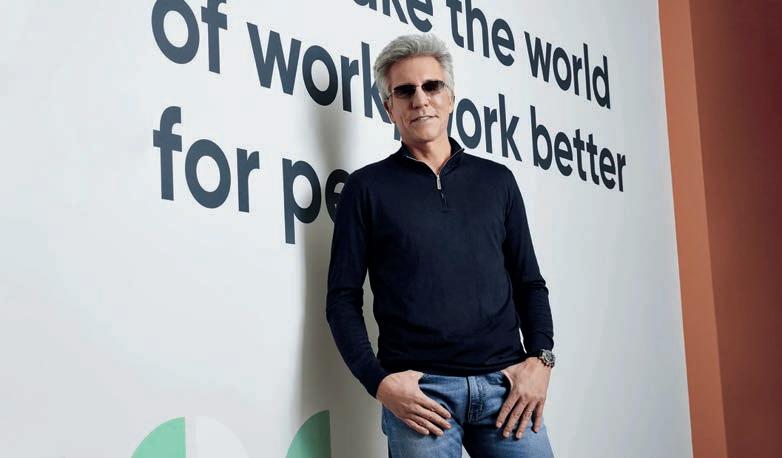
Lockheed Martin reaches for the moon with SAP

Lockheed Martin Corporation and SAP expanded their strategic partnership to transform the missioncritical business systems that power Lockheed Martin’s OneLM Transformation Program (1LMX).
The company is leveraging the RISE with SAP solution, expanding its enterprise cloud capabilities, and introducing the tools needed to implement core business processes managed in FedRAMP-compliant cloud environments through the 1LMX initiative.
Lockheed Martin will benefit from a secure and
modernized supply chain with enhanced systems for the USA’s defense industrial base. In addition to this, SAP Business Technology Platform has provided the company with a secure innovation platform to continue developing emerging technologies, and with the SAP Analytics Cloud solution data management and analytics are enhanced.
Scott Russell, member of the executive board of SAP SE and lead of customer success, SAP SE, said: “By leveraging SAP’s industry expertise, the RISE with SAP solution and the strength and reliability of SAP S/4HANA, Lockheed Martin
aims to further enhance its position as an intelligent, sustainable enterprise in the cloud while operating with uncompromised secu-
rity and support.”
Yvonne Hodge, SVP, enterprise business and digital transformation, and chief information officer, Lockheed Martin, said: “Our customers, including the U.S. Department of Defense, face rapidly evolving threats and they have made it a priority to become faster and more agile without compromising security. By expanding our partnership with SAP and by accelerating our move to the secure cloud, we will be able to provide the increased speed, agility, security and resilience our customers need to stay ahead of ready.”
32 ERP TODAY | UK / EMEA | Q1 2023
DEALS
“PROVIDING AGILITY, SECURITY AND RESILIENCE TO STAY AHEAD OF READY”
NEWS
&WINS
Bill McDermott
LSEG and Microsoft launch 10-year strategic partnership
London Stock Exchange Group (LSEG) and Microsoft have entered into a strategic partnership to architect LSEG’s data infrastructure using the Microsoft Cloud, and to develop new products and services for data and analytics.

With Microsoft Cloud and AI capabilities, this ten-year partnership advances LSEG’s strategy of building an efficient and scalable platform to deliver next-gen services for customers through enhanced workflow and greater flexibility.
LSEG’s data platform and other key technology infrastructure will migrate into Microsoft’s Azure cloud environment. LSEG’s next-generation data and analytics workflow solution will become interoperable with Microsoft applications and the company’s plan to introduce innovative new cloud-based analytics services.
Satya Nadella, chairman and CEO, Microsoft, said: “Advances in the cloud and AI will fundamentally transform how financial institutions research, interact and transact across
asset classes and adapt to changing market conditions.
“Our partnership will bring together the industry leadership of the London Stock Exchange Group with the trust and breadth of the Microsoft Cloud – spanning Azure, AI, and Teams – to build next-generation services that will empower our customers to generate business insight, automate complex and timeconsuming processes, and ultimately, do more with less.”
David Schwimmer, CEO of LSEG, said: “This strategic partnership is a significant milestone on LSEG’s journey towards becoming the leading global financial markets infrastructure and data business, and will transform the experience for our customers.
“Bringing together our leading data sets, analytics and global customer base with Microsoft’s comprehensive and trusted cloud services and global reach creates attractive revenue growth opportunities for both companies.”
‘ORACLE PLAYBOOK’ ETHOS DRIVES STEADY Q3 FISCAL RESULTS
Oracle announced a total Q3 fiscal revenue of $12.4bn, with Oracle Cloud bringing in the lion’s share in a decent quarter of cloud growth. Q3 Cloud Infrastructure brought in the highest revenue jump at 55 percent in USD, 57 percent at constant currency to add $1.2bn of revenue to the pot.
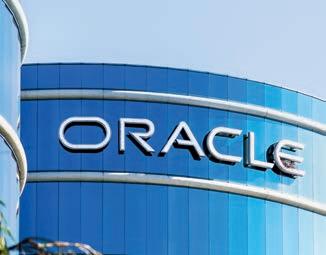
Last June, Oracle acquired healthcare giant Cerner, which added $1.5bn to the Q3 fiscal results and allowed Oracle to increase Cerner’s healthcare contract base by around $5bn.
In the company earnings call, Oracle CEO Safra Catz shared that one of its competitors had coined the phrase ‘the Oracle playbook’, which she fully embraced and said was a reflection of Oracle’s ability to do more while spending less.
“Using our own products and services enables us to increase our investments for growth, while also growing profitability, including through acquisitions as well as during our move to the cloud,” she said.
“Growth was driven by 48 percent constant currency growth for the total revenue of our two cloud businesses,” Catz added. “Oracle’s cloud businesses now exceed $16bn in annualized revenue. We remain the overwhelming market leader in Cloud ERP.”
visit us ERP.TODAY 33
“MICROSOFT’S COMPREHENSIVE AND TRUSTED CLOUD SERVICES AND GLOBAL REACH CREATES ATTRACTIVE REVENUE GROWTH OPPORTUNITIES.”
NEWS DEALS &WINS
VERHOEVEN QUITS AS SAP UK&I MD
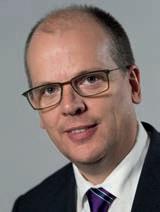
SAP has announced Michiel Verhoeven will step down as MD of SAP UK&I at the end of Q1 2023. He will be the twelfth UK&I MD to leave SAP in 16 years.
Verhoeven had previously occupied several senior SAP roles and recently told ERP Today, while in the post, that “leading the UK and Ireland business is a great opportunity and one that [he is] relishing.”
During his tenure, Verhoeven made a positive impact on customers and the SAP user group, making his exit even more of a surprise.
Paul Cooper,
chair of UK and Ireland
SAP user group (UKISUG) told ERP Today: “UKISUG has enjoyed a great collaborative relationship with Michiel, so we are sad to see his departure. Michiel has been supportive of the whole UKISUG community, and we welcomed his strong focus on customer success. Together we have fostered greater transparency and a valuable twoway dialogue between SAP and its customers. We wish Michiel well and look forward to continuing this momentum with his successor.”
Rohit Nagarajan, president EMEA North at SAP, said: “Michiel has
been integral to the continued success of SAP in the UK and Ireland, and leaves with our best wishes. He can look back on his time with SAP with great pride and has been a central fig-
ure to ensuring SAP invests over €250m in the region in the next three years.”

With another MD down, and the ECC6 deadline edging closer, SAP chiefs will need a leader who can hit
East and North Hertfordshire
NHS Trust has launched Enquire, a new intelligent virtual assistant powered by IBM Watson Assistant on IBM Cloud, to support its HR team’s ability to handle queries from its 6,500 staff. The partnership comes a year after IBM shed off its Watson Health operation.
Enquire has been created specifically for East and Nor th Hertfordshire NHS Trust to alleviate the

administrative workload of employees, freeing up their time for more
complex tasks while providing a 24/7 support ser vice for all staff.
Developed by IBM Expert Labs in collaboration with the Trust and over 15 subject matter experts, Enquire runs on IBM Cloud and is powered by the AI-fueled IBM Watson Assistant.
Kate Robinson, managing director, IBM Technology, UK and Ireland, said: “We are proud to have developed this innovative resource in collaboration with East and North Hertfordshire NHS Trust to help alleviate pressure on the HR team.”
34 ERP TODAY | UK / EMEA | Q1 2023
IBM Watson health status resurrected with NHS virtual assistant
Paul Cooper
KPMG has revealed a £5.5m investment in its Manchester office, set to enhance services offered to businesses in the region and provide new and improved working spaces for colleagues.
The firm will build Ignition North, a new 25,000sq foot collaborative hub designed to spark innovation and support digital transformation, and which will be home to KPMG’s Ignition team.
Along with technology experts across the company, the Ignition team will support clients from the start of an idea all the way through to the design, prototyping and development of solutions.
Jon Holt, chief executive of KPMG UK, said: “Manchester’s thriving tech center is a hive of activity, and the city has really established its reputation on the world’s stage as a leader in this field. Its

strong business community and access to talent makes this the perfect location for us to invest as a firm.
“Our new Ignition Center in Manchester will support a huge range of incredible businesses in the region and more widely, bringing together insights, people and technology to accelerate innovation and help them solve some of their most complex problems.”
Mayor of Greater Manchester Andy Burnham said: “This investment, which will create new jobs in our digital and tech sectors, is a real vote of confidence in Greater Manchester’s thriving innovation economy. We’re the fastest-growing digital and tech hub in Europe, and Ignition North will be part of an expanding network of businesses and working spaces across our city-region driving that growth.”
AWS AND ATOS JOIN FORCES TO ACCELERATE CLOUD BENEFITS
Atos has entered into an agreement with AWS to enable customers to accelerate cloud migration and benefit from digital transformation.
The global strategic transformation agreement between the two companies will allow Atos customers with largescale infrastructure outsourcing contracts to migrate to the cloud using AWS as its partner for IT outsourcing and data center transformation.

Atos will consult with more than 800 managed infrastructure services customers across the globe to offer a managed, hybrid-cloud service portfolio that features the option to move selected workloads to AWS.
The offering will provide access to industrialized migration methodology and solution accelerators, and customers will be able to leverage AWS services including analytics, compute, databases, ML and storage tools.
AWS will also work with Atos to develop and deliver new solutions for IT outsourcing and data center transformation globally. Over the next three years Atos plans to train its workforce to achieve over 20,000 AWS certifications.
KPMG goes big on physical work with £5.5m Manchester expansion
“Ignition North will be part of an expanding network driving the fastestgrowing digital and tech hub in Europe.”
Diane Galbe
ServiceNow signs MOU with Crown Commercial Service to

drive innovation
The UK’s largest public procurement organization, Crown Commercial Service (CCS) and ServiceNow have signed a Memorandum of Understanding (MOU), to provide UK public sector departments access to ServiceNow’s platform technology.
The MOU will offer customers access to competitive rates, discounts and a variety of commercial benefits.
ServiceNow has begun investing in skills and digital transformation funding, helping the government in its initiative to level up jobs and skills.
Additionally, the MOU offers priority places on
ServiceNow’s degree apprenticeships and a ServiceNow workplace development program for those working in government.
Jordi Ferrer, vice president and general manager of ServiceNow UK&I, said: “We would like this partnership with CCS to provide a platform for everyone in government to cross-pollinate ideas and skills. By creating a Center of Excellence (CoE) for government, we will build a sustainable ecosystem of innovation with future-proofed digital skills. Through the rapid infusion of our external expertize, we can support agility and flexibility, to help government
deliver more innovation and better services.”
Philip Orumwense CBE, commercial director and chief technology procurement officer at CCS, said: “This partnership with ServiceNow will create an environment where agility and flexibility are valued and promoted, improving civil servant and colleagues’ engagement and retention.
“It will allow government and the wider public sector customers access to a range of competitive rates and discounts across their technology platform whilst supporting the digital transformation of the UK’s public sector. It will also ensure the creation of a government-wide community that will foster greater collaboration for all.”
BMW Group drives new growth with RISE with SAP
BMW Group has expanded its strategic partnership with SAP to accelerate its digital transformation.
The deal will see BMW Group move its entire SAP software landscape using RISE with SAP and merge its cloud strategy with its existing SAP S/4HANA systems, allowing for joint innovation across critical business areas, from finance, parts supply, warehousing, supply chain and production. This move will allow BMW Group to digitalize faster, more comprehensively and more efficiently.
RISE with SAP will enable BMW Group
to combine the latest SAP technology and cloud solutions to drive business innovation. Moving from the traditional licensing model, both companies will operate a model covering infrastructure, cloud applications and operations.
Thomas Saueressig, member of the executive board of SAP SE responsible for SAP product engineering, commented: “Our two companies are closely connected through 30 years of trusting cooperation. By expanding our partnership, we are taking a decisive step toward a digital future.”

36 ERP TODAY | UK / EMEA | Q1 2023
"Creating a CoE for government for a sustainable ecosystem of innovation with futureproofed digital skills."
NEWS DEALS &WINS
Thomas Saueressig
Harness data-driven insights. Harvest profit.










Today’s food and beverage organisations need complete enterprise-wide visibility and the agility to rapidly respond to a changing market.

Our smart, preconfigured, and modern ERP for food and beverage helps you quickly turn challenges into a competitive advantage.
Over 65,000 organisations worldwide rely on Infor® to help overcome market disruptions and achieve business-wide digital transformation.
01000110011011110110111101100100
01000010011001010111011001100101
01010000010001100110111101101111 011001000010000000100110
010000100110010101110110011001010111001001100001011001110110011001010111001001100001011001010111011001100101011100100110000101100101 01000110011011110110111101100100
0010000001000010011001010111011001100101 01110010011000010110011101100101
011001000010000000100110
01110010011000010111011001100101011100100110000101100101
0010000000100110
0010000001000010011001010111011001100101011100100110000101100101 01110010011000010111011001100101011100100110000101100101011101100110010101110010011000010111011001000110011011110110111101100100001000000010011000100000010000100100001001100101 0110010101110010011000010110011101100101 011001000000100010101010010010100000110010101000110011011110110111101100100001000000010011000100000010000100110010101110110 0111001000100000001001100010000001110110011001010111001001100001011001010111011001000110011011110110111101100100001000000010011000100000010000100100001001100101 0110010101110010011000010110011101100101 011001000000100010101010010010100000110010101000110011011110110111101100100001000000010011000100000010000100110010101110110 011100100010000000100110001000000111011001100101011100100110000101100111011001010111011001000110011011110110111101100100001000000010011000100000010000100100001001100101 0110010101110010011000010110011101100101 011001000000100010101010010010100000110010101000110011011110110111101100100001000000010011000100000010000100110010101110110 01110010001000000010011000100000
0010000000100110 00100000
01110010011000010110011101100101 001000000100010101010010
00100000
0010000000100110
00100000010001010101001001010000010001100110111101101111
0010000001000010011001010111011001100101011100100110000101100101
01000110011011110110111101100100
0010000001000010011001010111011001100101 01110010011000010110011101100101 00100000010001010101001001010000010001100110111101101111 011001000010000000100110
©
2022. Infor. All right
Learn more
Copyright
reserved.




NEW DAWN

Carl Eschenbach and Aneel Bhusri on the next chapter for the jewel in the ERP crown.



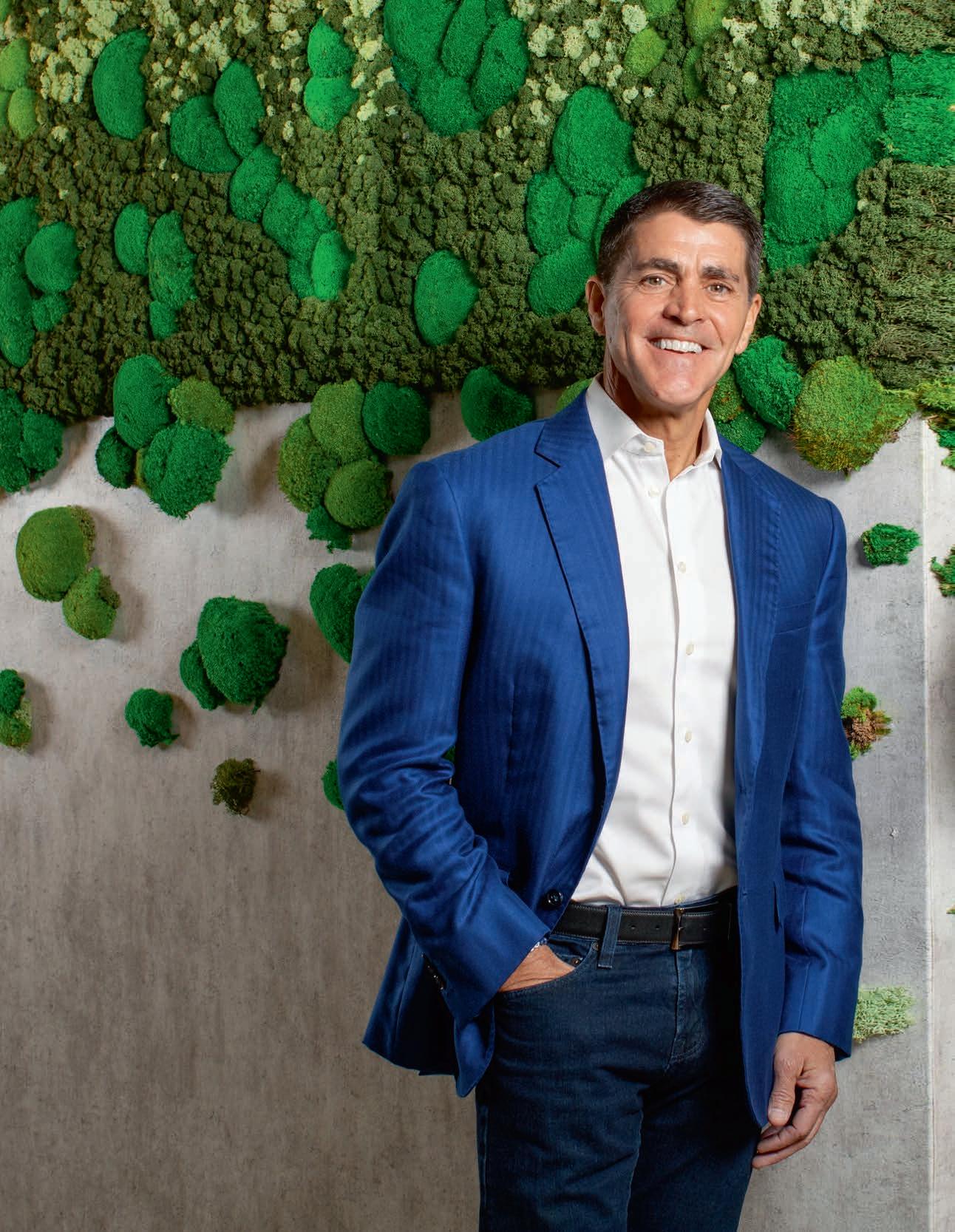
UK / EMEA | Q1 2023
NEW WORKDAY
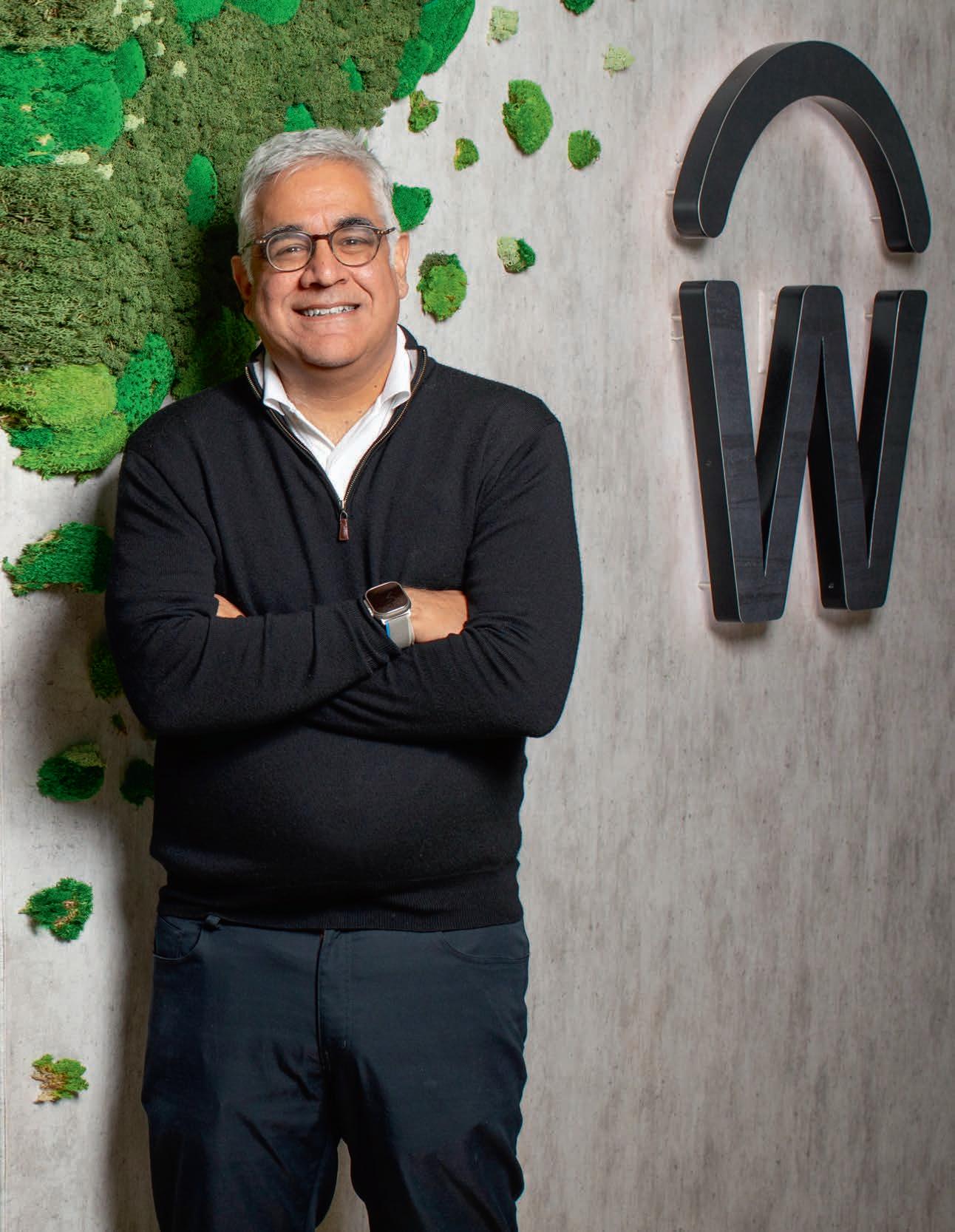
WORDS/ PAUL ESHERWOOD






PICTURES/ DARREN MILLER

Carl Eschenbach, the former VMWare executive and venture capitalist, is the new co-CEO at Workday and plans to assume full control next year. After more than 18 years at the helm, Aneel Bhusri, the co-founder of the company, will transition into a product-focused role leaving Eschenbach in sole charge.
During an interview at Workday’s San Francisco office, Eschenbach told me: “I am humbled and honored by the opportunity to work alongside Aneel and our workmates across this amazing company.” And, on a recent earnings call, he proclaimed: “I’m truly energized by Workday’s unique opportunity to be one of the largest and most profitable software companies in the world.”

Eschenbach is considered to be one of the most accomplished operators in the software industry. Although he never took the CEO role at VMWare, its revenues soared to $7bn under his influence while his time at Sequoia Capital provided a unique lens into the characteristics of high-growth cloud companies like Snowflake, UiPath and Zoom

Some may argue that an unproven CEO at the top of a cloud ERP company is a gamble. Anyone who meets Eschenbach will soon have that concern quashed - he brings the scale and commercial mentality that Workday has needed for some time. While there has never been a doubt about Workday products, its glacial journey towards profitability has always posed questions and Eschenbach’s appointment will provide the impetus, experience and answers to that conundrum.
He is a former wrestling champion and a big sports fan with a winner’s mentality that will sharpen Workday’s go-to-market strategy and refine its competitive edge. During our interview he was thoughtful, composed and calm - there was a modest tone that I wasn’t expecting from a venture capitalist and a rapport with Bhusri that demonstrated a strong friendship built on mutual trust.
When I asked Bhusri why now was the time to step down from the CEO role and place Eschenbach in charge, his answer was humble and frank. “Workday needs a better CEO,” he told me. “This is a new chapter and Carl is one of, if not, the most talented operating executives in the software industry - Workday is very lucky to have him.”
42 ERP TODAY | UK / EMEA | Q1 2023 | COVER STORY | WORKDAY C
Workday was founded by Dave Duffield and Bhusri in 2005.
“Carl is one of the most talented operating executives in the software industryWorkday is very lucky to have him.”
Scan the QR code to listen to interview highlights
Born out of adversity
Workday was founded by Dave Duffield and Bhusri in 2005. Duffield is a legendary software entrepreneur and Bhusri was an understudy in the formative years of the relationship. After a bruising encounter with their previous business, the two long-time friends decided to try and build a new kind of business applications company. The idea was simple: take everything they had learned at PeopleSoft , use what happened with Oracle as motivation, mimic Salesforce ’s SaaS model and ensure that every employee, product or partner associated with the brand put people and customers at the center. That simple recipe created the foundation for a company that has become the default
choice for many of the world’s biggest enterprises and is admired and respected across the industry.
Duffield said: “When Aneel and I met over pancakes at a diner to talk about our futures, we both knew we wanted to continue working together. Aneel knew that cloud computing, patterned off Salesforce, was the next big technology trend and we both agreed that our new company’s core values would be the same as our former company’s - because they worked.”
Workday flourished under the PeopleSoft mantra by adopting a completely different approach to that which was taken by most other software firms. While many of its early successes can be attributed to Duffield’s reputation and the goodwill previously

visit us ERP.TODAY 43

banked with global facilitators like Deloitte and Accenture , the longevity of its esteem is largely down to Bhusri’s principles and style: a style that, still to this day, places the company’s human capital above all else.
“Workday was founded on all the good qualities that influenced PeopleSoft’s growth and success: core values that inspired a strong culture, a good sense of humor, widespread enthusiasm for innovation and deploying leading technology, and quite simply, an honest and transparent approach to doing business,” said Duffield.
In order to appreciate why these principles are so important, it’s essential to understand what happened with PeopleSoft and why that experience left such a mark. The acquisition by Oracle remains one of the most bitterly contested corporate deals in history. Duffield’s vision and philosophy was diametrically opposed to the way Larry Ellison and Oracle operated. There was absolutely no synergy between the corporate cultures and most PeopleSoft employees were fiercely opposed to a deal. A long and acrimonious battle ensued but ultimately Ellison won-out when PeopleSoft’s corporate structure and a failed U.S. Department of Justice suit ultimately prevented Duffield from blocking the deal.
Duffield not only lost control of PeopleSoft, he also had to contend with intense feelings of liability for the employees and customers who got caught in the crossfire. He knew Oracle was going to swallow 17 years of hard work and, in the immediate aftermath, Ellison slashed more than half of PeopleSoft’s workforce - confirming Duffield’s fears at a stroke.
Duffield described the events as “disheartening”, but the perverse truth is Larry Ellison did Dave Duffield and Aneel Bhusri a big favor. If it had not been for Oracle’s sledgehammer tactics, we may never have gotten to see what two passionate visionaries could achieve when they had a point to prove.
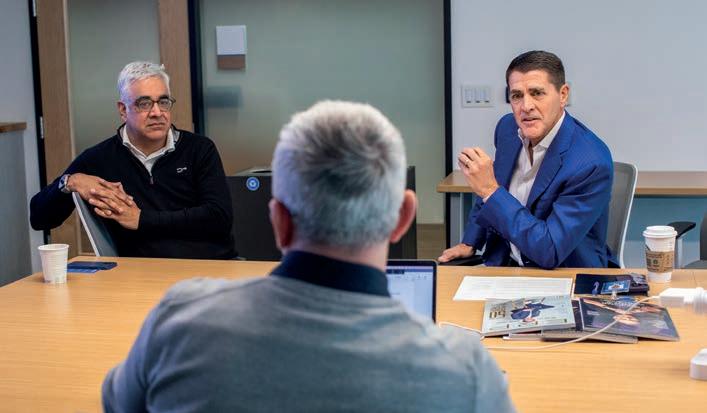
Workday is the only global cloud ERP company
That’s a bold statement that many would argue with, but the fact is, Workday is the only major player that was born in the cloud and operates unhindered by a legacy of on-premise applications. Smaller cloud-native ERPs have emerged and the giants from Waldorf and Austin have developed significant cloud businesses off the back of their on-premise legacies. But only one company can lay a genuine claim to being cloud ERP trailblazers, and that’s Workday.
While others like Infor have developed solid cloud ERP portfolios through a series of acquisitions, and SAP and Oracle have developed huge
cloud businesses by upgrading their install base, it was Duffield and Bhusri that started the cloud ERP conversation - with just a little inspiration coming via Mr Benioff.
Being the first cab off the rank has many advantages but it also poses an equal number of challenges. At the time Workday took its SaaS HCM product to market, the notion of business services via the cloud was still in its infancy. Consumer internet services had emerged much quicker and the dot.com boom had already given birth to the likes of Amazon and eBay. But, businesses were much slower to adopt the concept and after the failed hype of the application service provider industry, it was Benioff’s Salesforce.com that broke new ground for business applications via the cloud. Salesforce was unique at the time as it was a ‘new’ company that started with a SaaS playbook instead of trying to transition to SaaS from a previous paradigm.
visit us ERP.TODAY 45
“I’m truly energized by Workday’s unique opportunity to be one of the largest and most profitable software companies in the world.”
Workday followed suit some five years later but, even by then, the internet was still largely misunderstood and businesses were cautious about putting their applications and data into an unproven environment. To give the timeframe some context, when Duffield and Bhusri launched the first iteration of Workday Human Capital Management, Zuckerberg’s enterprise was still called ‘TheFaceBook’ and had just one employee.
While Workday is known throughout the world as an HCM company, it may surprise some to learn that it started building its Financials product just six months after it started on HR. Workday Financials was launched in August 2007 with its first customer going live soon after.
I won’t cover Workday’s rich product portfolio here. The accompanying supplement to this magazine includes analysis of Workday’s platform, Workday Extend, Workday Skills Cloud and many other facets of its offering.
Over the next 18 years, Bhusri cultivated a business with a reputation that resonates loudly within the C-suites of the world’s biggest enterprises. Workday has a footprint inside more than half of the Fortune 500, over a quarter of the Global 2000 and recently passed the milestone of its 10,000th customer. Its products and services have been built with innovation at the core, leveraging artificial intelligence and machine learning long before they were commonplace.
The combination of cloud-native products delivered by an organization that demonstrates the highest levels of customer satisfaction has created a globally admired brand that is the jewel in the ERP crown. Its financial success will be a source of great pride for Bhusri, but it was evident from the time that I spent with him that he doesn’t measure success that way. Customer satisfaction and retention are the metrics that are used to determine progress and, on that front, Workday is in an industry of one.
Eschenbach’s appointment
Having spent five years as the editor of an M&A publication, I have met enough venture capitalists to have a pretty good picture of one in my mind: Harvard , pinstriped, NYC and the Hamptonswith little empathy for people and a singular focus on value realization. Maybe my presumption is too general, but years of experience talking to and working with VCs left me with some serious questions about Sequoia’s top performer taking a role at Workday. Oracle maybe, but surely not at the company whose founder has pledged to give his fortune away and has spent nearly two decades
building a business based on integrity and being a good citizen?
I wanted to be wrong about my concerns so put Eschenbach under some pressure at the start of the interview by asking how he would measure success and what makes for a good leader. “15 years ago, I changed my life from focusing on success to living a life of significance,” he told me. “And what I realized is when you have a life of significance and you focus on your impact on others, what naturally happens is you get more success.”
An unexpected but reassuringly authentic answer to a challenging question. I know from speaking to many stakeholders that the decision to hire a VC had raised similar questions, but in just a few short weeks, Eschenbach appears to have answered all of them, and some.
Eschenbach continued: “It’s not just about making money. It’s about building companies. Yes, I was a venture capitalist, but 80 percent of my time was not focused on investing. It was helping companies build something that would stand the test of time. Along the way, yeah, we’ll make money and profits, but that wasn’t my primary driver.”
Bhusri described a “new energy” within the organization and extolled the impact that Eschenbach had made since taking the co-CEO role: “Carl is driving operational excellence and making every part of the business better. And it’s happened in just six weeks,” he said.
“Dave and I were always nervous about hiring someone from the outside. We didn’t want Workday to change into something that’s more like one of our competitors. But we have 100 percent alignment on values and the direction we want to go. When I knew we needed a new leader for the next stage, there was only one name on the page, and that was Carl’s.”
Eschenbach, therefore, is a dichotomy. He displays many of the typical VC credentials but also exhibits a much more thoughtful and reflective approach to business, and to life. He is commercially astute and well-versed in scaling cloud companies. He is fiercely competitive and not afraid of a fight. But he also shares the same values that were the foundation for Workday to thrive and that have cemented a long-standing friendship with Bhusri.
Eschenbach also brings an operational playbook that will sharpen some of Workday’s softer edges. That’s not to say that Bhusri has been complacent or lacks commercial acumen - he’s certainly no pushover. But Bhusri is a product guy at heart and always has been. His first priority has always been his employees and then his customers, and while
46 ERP TODAY | UK / EMEA | Q1 2023
| COVER STORY | WORKDAY
they are exceptionally admirable qualities, Workday has reached an inflection point where it needs some optimizing if it’s going to reach its true potential.
“I hope I bring a different level of operational rigor to the company,” Eschenbach said. “And by doing that we will free-up Aneel to go back to what he’s absolutely brilliant at doing and that is driving the product and technology strategy.”
In the early days, it was Bhusri’s product genius and Duffield’s connections and reputation that created the first wave of success. In recent years, Chano Fernandez provided invaluable support to Bhusri in taking the go-to-market and partner proposition as far as he could. Now, with Eschenbach on board, Workday can return to a time when its products are being developed by one of the smartest technologists in the industry and its sales and operational strategy are being led by a proven winner. The combination could be formidable.

Duffield offered one final endorsement, stating: “Everyone in the Workday community is blessed to have Carl at the helm. Carl is personable, positive and humble, and his skills perfectly complement Aneel’s. They relate to one another personally, and as with any great partnership, they bring out the best in each other.”
The road to $10bn and beyond
All technology vendors like something to aim for and Workday has consistently highlighted $10bn in revenue as its next milestone. During our interview, I asked Eschenbach how he evaluated
the opportunity and what would drive the growth needed to reach this target.
“The potential I thought Workday had is actually bigger than I expected - I can break it down into three key areas,” he said. “We have a $120bn opportunity in front of us within our existing Financials and HCM markets. Then you look at international - 75 percent of our business comes from North America and I think we have a huge opportunity to expand. Thirdly, our ecosystem is going to drive significant growth as we expand our relationships with the global partners and cloud providers.”
visit us ERP.TODAY 47
“When I knew we needed a new leader for the next stage, there was only one name on the page and that was Carl’s.”
One of Workday’s biggest market opportunities is to sell its Financials product into its HCM customers, and given the size of most of those customers, they could be very big deals - The New York Times being just one example that went live on Workday Financials in the last quarter.
As Eschenbach noted on the most recent earnings call: “We’re going to double down even further on our Financials opportunity, both to sell into our customer base as well as into net new. We see this as a rich opportunity. We did a nice job in Q4 and we think that’s something we can do a lot more of.”
Eschenbach was also bullish on Workday’s competitive credentials and far more vocal on its ability to win ERP dollars away from its two main rivals.
“Every time we win one of our legacy dinosaur competitors loses,” he told me. “Every customer that goes on a true digital transformation is going to the cloud. When that happens, we are going to get a look at it and I expect us to win our fair share. When you pitch Workday against the competition, I truly believe that we have the best platform.”
This bravado was echoed in the earnings call. Eschenbach took the majority of the questions and there was a noticeable spike in the narrative, especially when highlighting competitive wins. “Three of our new Fortune 500 wins replaced cloud solutions from our legacy ERP competitors,” he said.

This comment was significant because it emphasized wins for Workday where it replaced other cloud ERP solutions, not old on-premise tech. In the past, and despite the history, the Workday
earnings call has been a relatively cordial affair without the bluster offered by some of its competitors. Although Eschenbach’s inaugural conversation with analysts followed the same orderly form, it was noticeable that he was keen to underscore Workday’s successes, especially when it came at the expense of Oracle or SAP.
Revenues for FY23 reached $6.22bn, representing a 21 percent increase over last year. More interestingly, total subscription revenue backlog was $16.45bn indicating a very strong forwardlooking picture coupled with impressive current performance. Cloud backlog and remaining performance obligations are key metrics for assessing the future growth opportunity for subscription cloud companies as they provide a window into the short-term committed revenue that a vendor can expect to realize.
This healthy order book is a good indicator for future performance and Workday has returned low-20s growth rates for the last six quarters. In fact, a graph of revenue over time shows a steady and consistent climb for almost a decade. However, if that trend continued, its path to $10bn could take some time and Eschenbach’s plan to reach the new landmark is significantly more aggressive.
“I see continued opportunity in our international business, both in EMEA and in APJ,” said Eschenbach. “Today, we have only 25 percent of our revenue coming from our international operation, yet it represents more than 50 percent of our TAM. We’re also going to continue to leverage our
48 ERP TODAY | UK / EMEA | Q1 2023
“I’ve heard many times that it’s hard to work with friends. I’ve found exactly the opposite.”
Growth happens when tech meets ambition. Stay future-ready with PwC and Workday.
Growth happens when tech meets ambition. Stay future-ready with PwC and Workday.
Learn more at pwc.com/us/workday
Learn more at pwc.com/us/workday
Growth happens when tech meets ambition. Stay future-ready with PwC and Workday.
more at pwc.com/us/workday

2023 PwC. All rights reserved. PwC refers to the US member firm, and may sometimes refer to the PwC network. Each member firm is a separate legal entity. Please see www.pwc.com/structure for further details. This content is for general information purposes only, and should not be used as a substitute for consultation with professional advisors.
©
Tech, tech, tech... boom.
2023 PwC. All rights reserved. PwC refers to the US member firm, and may sometimes refer to the PwC network. Each member firm is a separate legal entity. Please see www.pwc.com/structure for further details. This content is for general information purposes only, and should not be used as a substitute for consultation with professional advisors.
Learn
Tech, tech, tech... boom. ©
Tech, tech, tech... boom.
ecosystem - our partners around the world are doing a great job, implementing our technology and driving deployment. But we’re also going to work with them to build business plans so they can help us drive net new business, not just do implementations, but help us drive new business into the base as well as net new customers overall.”
The importance of its partner ecosystem cannot be exaggerated and it will be vital to create the kind of fertile environment that global consultancies need to operate. Historically, Workday has leveraged two key relationships at a global level and a bunch of smaller boutique partners. There is also a thriving community of developers that augment the core offering through a marketplace called Workday Extend, but if Eschenbach is serious about getting to $10bn quickly, he will have to compete for resources within the GSIs and that’s not an easy task when there is already enough SAP work for every consultant on the planet.
Eschenbach reiterated the importance of partners and said: “Our partner ecosystem will be critical to our next phase of growth. We expect our partners will play an even more important role in FY 2024 as we look for them to drive an increased number of new opportunities, while we strategically shift more customer deployments to our ecosystem.”
You can read more about the Workday partner ecosystem in the accompanying supplement, A Complete Guide to Workday.
Conclusion
While researching for this article, I have spoken to customers, partners, employees and shareholders. Usually, those interviews present a mixed picture of an organization and my job is to find a balance between the hype and reality. However, that has not been the case with this project.
I always knew that Workday regarded itself as unique, but it wasn’t until I lifted the hood that I started to understand why. It has tried to deflect the tag of being an ‘ERP company’ for some time - I always assumed because it didn’t necessarily agree that HCM plus Financials equals ERP. But the truth is, Bhusri has built the perfect ERP company - he just hates the categorization because of the reputation that other ERP companies have.
During my research, words and phrases that are rarely associated with an ERP vendor were repeatedly used to describe the company and its leaders: friendship, honesty, transparency and fun were commonly expressed to paint a picture of an organization that is a true anomaly in the industry.


What struck me the most during my time with Bhusri was the level of humility that he displayed when openly discussing the areas of his business that required a different set of skills to the ones he possessed. “Dave and I did pretty well to go from zero to $6bn but I don’t know how to get to £10bn and beyond,” he said. “That’s why Carl is the right person to lead our next chapter. This is not business as usual with a new CEO. This is a new era for Workday. We have an opportunity for greatness. Our markets are huge and our penetration is still relatively low. Getting to that next level of scale, well that’s something Carl has great expertise in and nobody else in the management team does.”
Admitting that your business needs a different type of leader to navigate the next phase of its growth must be an incredibly hard realization for a founder, but Bhusri has done so with grace and modesty. “What’s really impressive about Aneel is the recognition of where he was at and having the character to make these decisions,” said Eschenbach. “When you’ve put 18 years into a company and it’s something you started, that’s not easy.”
50 ERP TODAY | UK / EMEA | Q1 2023
| COVER STORY | WORKDAY
During four hours of interviews, Bhusri consistently talked about friendship as being the foundation for Workday’s success, highlighting the longstanding comradery he has enjoyed with Dave Duffield and his other Workday colleagues. That theme continued without a blip when we discussed the relationship with Eschenbach and the rapport and chemistry between them was palpable.
“Workday is a company built on values and friendship,” said Bhusri. “At the start that was about mine and Dave’s friendship and now it continues with the friendship I have with Carl. But friendship also means the relationship we have with our employees and with our customers. I’ve heard many times that it’s hard to work with friends. I’ve found exactly the opposite.”
For the first time in four years of writing about ERP vendors, the story about culture finally makes sense. I’ve always adopted a skeptical view when I listen to tales from vendors regarding their approach to employees, customer centricity or broader ESG credentials. However, Bhusri’s first-hand explanation of what really makes a company special was authentic and believable in a way that I have not experienced before.
I have no doubt that Workday’s growth goals will be achieved under Eschenbach’s leadership. He is, after all, a consummate corporate operator blessed with a loyal customer base, market leading products and incredibly strong brand credentials. The greatest challenge he will face is preserving the foundational values that made Workday special

whilst shooting for the moon (and profitability).
It’s not an impossible task and ‘wrestling’ Workday into the black will be made easier as businesses start to evaluate what is really important to them. I wouldn’t mind betting that there will be an increased premium placed on partnerships with organizations that demonstrate the kind of values that Workday is built on. As Eschenbach succinctly summarized our discussion, “If a CEO truly believes that their most important assets are their people and their financial systems, they should bet on Workday.”
visit us ERP.TODAY 51
“If a CEO truly believes that their most important assets are their people and their financial systems they should bet on Workday.”
Bored with the Hybrid Worker obsession? Say hi to the
Hyper Worker
I’ m sorry in advance if you are still preoccupied by where people work; five, four, three, two days a week. Or even just one day of the week from home, coffee shop, pub turned drop-in office, layby at the side of the A34, kitchen, bedroom, etc. A few of us even took not going to the office dead seriously by abandoning their desk in Docklands, and, Hugh Fearnley-Whittingstall style, taking themselves down to a small holding in Dorset. “That’ll be the chickens. Let me know if you want some eggs when I come up to town in seven weeks.”
Any obsession with today’s workplaces was of course fuelled by COVID, then by the Great Resignation, and thereafter a post-pandemic lockdown euphoria that coincided with a skills shortage. This was all combined with an urban exodus by the many whose garden-less flat with on-street parking bought them a small pile in the country, a new work/life balance, and a predilection for posting pics from the Old World of busy underground stations and a protestation of never going back to such mad ways of living.
with each other in an office were at best ignorant of a new normal. At worst? These folk were WFH heretics who deserved a seat in a dunking chair (preferably in their own back garden to avoid the witch trial commute). Float and you were a WFH heretic. Sink and you were a true believer.
So in my big prediction of 2023, I believe it is time we accept that we can all work from anywhere and get over hybrid working being the Be All and End All of attracting talent, making your business a great place to work, while remaining growing and profitable.

Instead of this preoccupation about the place we prop our professionals, we will instead focus our fixations on the thing that is going to dramatically improve our businesses and the lives of the people who work in them. And that is focusing on how we work.
BY CHRIS GABRIEL
People professionals, progressive CEOs, and work-life balance coaches bombarded LinkedIn with posts postulating that those who even suggested human beings enjoyed being
Because readers of ERP Today, here is the truth. Being unproductive, unsatisfied, unloved, and under-remunerated in your garden room or Hobbit Hole leaves you in exactly the same puddle of gloom, apart from you don’t get to commute to see your fellow travelers in the office, a place where you at least get free coffee and your boss pays your heating bill for the day. And, if you are a business owner and you think ‘empowering’ your people to follow the wrong processes, using the wrong tools,
52 ERP TODAY | UK / EMEA | Q1 2023
Welcoming a golden age of productivity, enjoyment, retention and work/life balance
visit us ERP.TODAY 53
The Hyper Worker will be digitally enhanced and augmented and make light work of drudgery
in the wrong way, for the wrong job - whilst being allowed to ‘work’ meaning everything will be hunky dory - then you have been totally distracted on what really makes a business and its people thrive.
So move over the Hybrid Worker, and say hello to a new generation of hyper-productive, hyperhappy, and hyper-contributing Hyper Workers.
No, I am not talking about genetically-modified humans who sprout new hands and limbs. The Hyper Worker will be digitally enhanced and augmented and make light work of drudgery, stand up against hours wasted on Excel or doing paperwork, and dash out data-driven decisions instead of making stuff up as they go along.
The Hyper Worker is going to take advantage of, and be empowered by, the fusion of a set of technologies that will place them and the companies they work in at the head of the Darwinian pack of economic evolution.
Your business, if it adopts a Hyper Worker policy, will be inundated with the best talent your industry has to offer, because you can elevate your job adverts above the rest of the pack who are still banging on about their apparently amazing hybrid work options. Below is an example I’ve cooked up.
“Hyper Worker Wanted (Finance): Fast growing business wants an enthusiastic and empowered individual to come and make incredibly smart decisions in our finance function. Your job will be to make decisions on how best we can improve cash flow, control costs, increase revenues and grow our profitability. Your own personal digital automation assistant will take care of mundane tasks that will stop you from focusing on those core outcomes, letting you excel at your job. Your digital data assistant will make sure you have every insight you need to make the small or big decisions that will make a huge difference to our business. And your digital workflow assistant will make sure everything you
need to do is as simple and seamless as possible so you don’t waste valuable time making mistakes.
“We don’t care where you work. We care about you knowing everything is being done to make your job as fulfilling as possible and that you simply love doing the things that add value to our business, not simply adding tasks to your day or your job description.”
And once you have your Hyper Workforce thanks to job ads like these, none of your Hyper Workers will ever leave, because no other business will be able to give them the work/life synergy they deserve.
The Hyper Worker will be empowered to get the right things done in the most efficient, accurate, intelligent, and meaningful way, 100 percent focused on using their professional talents to make a difference and deliver outstanding outcomes.
Hyper Workers of course will earn more than their hybrid working colleagues because their economic output will be worthy of greater remuneration. And you will be happy to pay them because your workforce will be as productive as possible because you will do the one thing many businesses simply don’t focus on: wasting the time of your people!
My prediction may sound like the wishful thinking of a strategy officer, but trust me, the Hyper Worker is already emerging and being empowered by technological innovation that will become the new normal in new generations of core business operations platforms that sit in your business today.
The Hyper Worker will undoubtedly emerge in 2023, so if you are truly interested in putting your people at the core of your business strategy, you will start to build your Hyper Worker strategy at the heart of your business.
Right, I am off to put the kettle on and feed the chickens.
54 ERP TODAY | UK / EMEA | Q1 2023 | GUEST CONTRIBUTOR | WORK
Chris Gabriel is CSO, Sapphire Systems
It is time we accept that we can all work from anywhere and get over hybrid working being Be All and End All
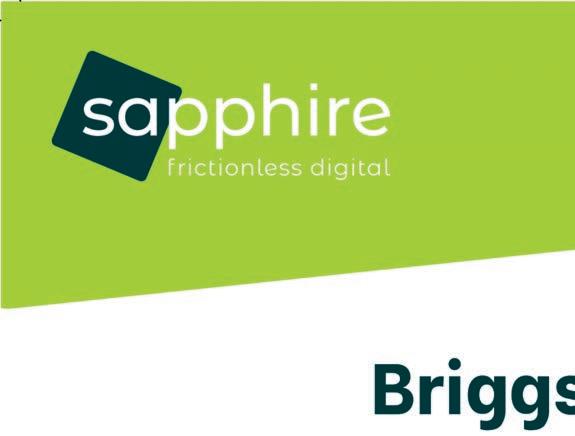



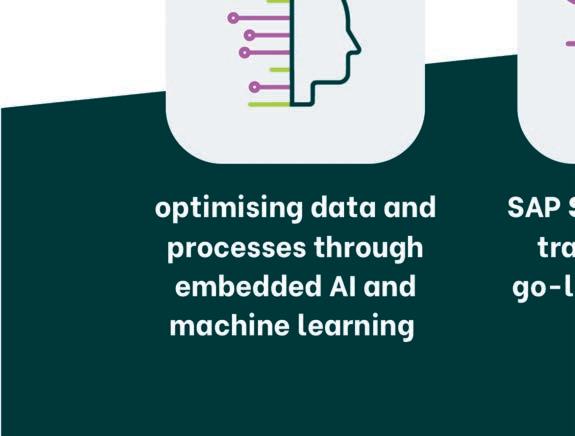
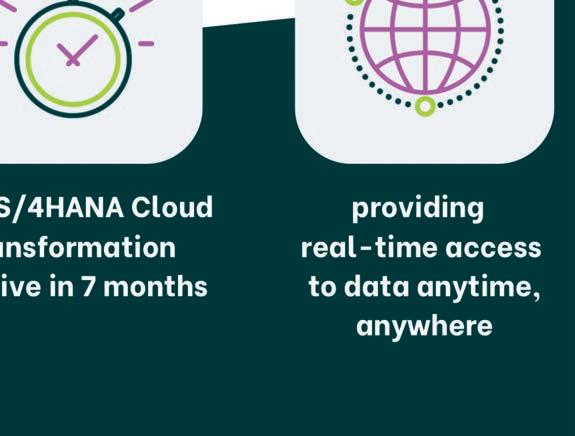

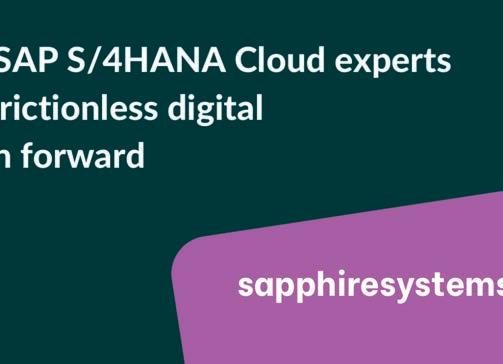 CEO
CEO
AT KOCH INDUSTRIES, AND KEVIN SAMUELSON,
CHIEF OPERATING OFFICER

AND
PRESIDENT
JIM HANNAN,
BY PAUL ESHERWOOD
AT INFOR, EXPLAIN WHY AN UNLIKELY PARTNERSHIP WILL LEAD TO BETTER OUTCOMES FOR ERP CUSTOMERS.
56 ERP TODAY | UK / EMEA | Q1 2023
WHAT DOES A PAPER COMPANY KNOW ABOUT ERP?
QUITE A BIT AS IT TURNS OUT

visit us ERP.TODAY 57
When Koch Industries bought Infor, I feared the brand would slowly but inevitably disappear from the ERP landscape. Koch is an industrial conglomerate with interests that span oil, paper, mining and energy, to name just a few. If you live in the USA, your daily life will be touched at some point by a Koch product: whether that’s the napkin you use at breakfast, the glass in your windshield, the fertilizer used to grow food, or the petrol that powers mobility.
Koch is a $125bn revenue behemoth with a diverse portfolio of interests, strong political ties and a track record for plowing its own furrow, often against the tide of social pressure. On face value, I couldn’t see why the acquisition made sense for Infor customers or how the Infor brand would retain its independence inside America’s second largest private company.
At Infor’s NYC headquarters, I spent the day with Jim Hannan, president and chief operating officer at Koch Industries, and Kevin Samuelson, CEO at Infor, to find out what the deal meant for Infor customers.
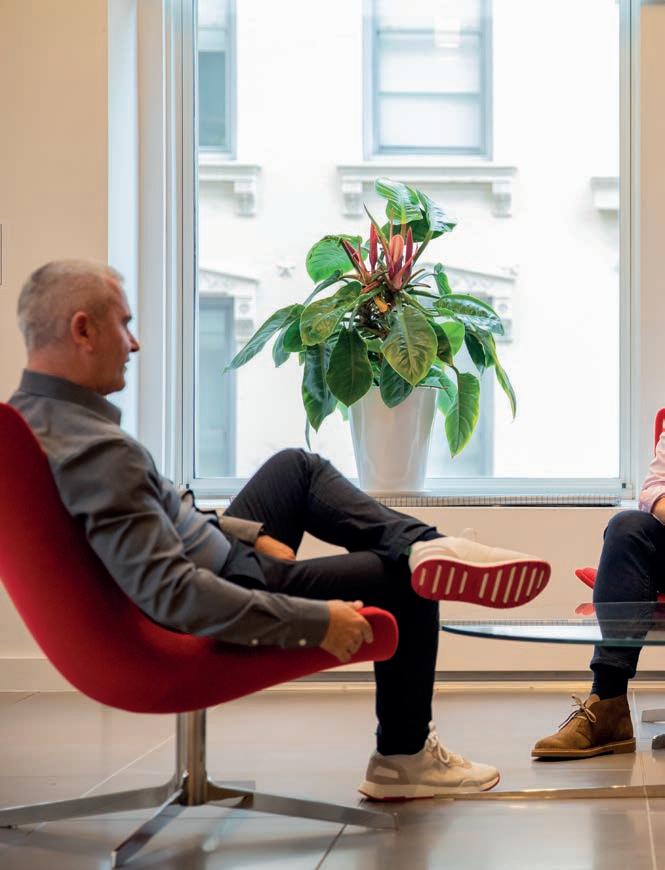
Infor the innovator
Infor is a brand that I have long admired. It may not make as much noise as some ERP vendors, its CEO doesn’t have the same swagger as others I could mention and it rarely hits the headlines when signing a new customer. But, ever since I interviewed Charles Phillips on my first assignment for ERP Today, I have been fascinated by a company that has defied an entire industry by doing ERP its own way.
Whether Infor was owned by private equity, considering an IPO or on the brink of being acquired, it has always maintained a unique position - a position that is consistently underscored by taking bold decisions ahead of market convention.
Consider the four biggest levers in ERP modernization: cloud, industries, implementation and experience. Infor was first to the party on all four of these topics when it developed its in-house design agency more than a decade ago, launched micro vertical products in 2010, went all-in on AWS with the first multi-tenant cloud offering in 2015, and developed its 60:30:10 methodology to ease the heartache of ERP projects.
In addition, Infor OS is the most mature of all the application platforms and was the first to embrace a microservices architecture with accompanying data lake and AI-powered analytics baked in. When you look at Infor’s track record of technical firsts, you start to build a picture of a company that consistently innovated ahead of the curve.
When I interviewed Phillips in 2018, he said this: “Our competitors are talking about experience, but we started that conversation with the first integrated design agency. They
58 ERP TODAY | UK / EMEA | Q1 2023 | INTERVIEW | INFOR
“CONSIDER THE FOUR BIGGEST LEVERS IN ERP MODERNIZATION: CLOUD, INDUSTRIES, IMPLEMENTATION AND EXPERIENCE. INFOR WAS FIRST TO THE PARTY ON ALL FOUR OF THESE TOPICS.”
OF ALL THE ERP VENDORS, INFOR IS THE ONLY MAJOR FORCE THAT IS PRIVATELY OWNED AND THAT PRESENTS A UNIQUE OPPORTUNITY TO THINK ABOUT ITS PRODUCTS, SERVICES AND CUSTOMERS IN AN ENTIRELY DIFFERENT WAY.
Scan the QR code to listen to interview highlights
are talking about cloud, but we built our applications for the cloud rather than retooling on-premise apps. We made a decision not to get into the infrastructure business which means that all of our focus and budget is spent enriching our applications. Infor leverages Amazon’s huge investment in infrastructure services while our competitors are effectively competing against that.”
Given Infor’s history of bucking trends and making big bets before everyone else caught up, maybe the deal with Koch is another example of progressive thinking outside the box and I just need to be schooled-up? Whenever I have interviewed Samuelson in the past, we have always returned to the same nagging question: how do we make ERP better for customers? Maybe he has found the answer in an unlikely partnership.
What is Koch Industries?
From the outside looking in, Koch may appear to be an ageing industrial entity but, in reality, it’s a progressive hotbed of innovation and radical thinking. Since 1961, it has outperformed the S&P 500 by nearly 26 to one. How did it create such dramatic, long-term growth especially when so many
other large enterprises failed to adapt to change and ultimately ceased to exist? The answer to its success lies in its Principle Based Management philosophy underpinned by the idea of ‘mutual cycles of benefit’.
Koch’s economy-defying success is rooted in the application of proven principles of human progress. Ideas such as mutual benefit, comparative advantage and creative destruction have provided a platform to innovate and transform on a huge scale, ultimately creating a business that has defined its own version of success.
Its principles predicate an entire business model and are instrumental in shaping the company’s decision making and investments. They also directly influence customer relationships by considering ‘the mutual benefit’ of each engagement through a broad value lens rather than a narrow sales window.
“The overarching principle that drives our customer relationships is mutual benefit,” said Hannan. “You can simplify that and say we’re looking for win-win partnerships that are more than transactional. This is how we view customers in every one of our businesses.”
Koch may be 100 years old and rooted in industrial activities, but it is also an incredibly dynamic and diverse investor in technology. Recently it has made significant investments in battery technologies and, through its Disruptive Technologies (KDT) subsidiary, is at the sharp end of innovation in healthcare, FinTech, cyber security and energy transformation.
Koch still makes most of its money by refining oil, milling paper and other heavy industries, but it is also an investor in more than 50 venture-stage companies that are transforming industries and shaping the future with clean energy, smart and sustainable building materials and artificial intelligence to power cutting-edge healthcare tech.
KDT’s philosophy sets out a bold agenda: ‘the continuous process of iterating, improving and destroying current business models and platforms’. Although Infor is owned by the parent company, not the subsidiary, when you consider its acquisition against this context of disruptive and radical innovation, the move doesn’t seem so obscure after all.
Infor’s transformation
Infor may be in the business of helping its customers adapt to digital commerce, but it also needed its own transformation. Infor and Koch share many common business principles but embedding the Koch methodologies into the fabric of the company has taken some reorganization and realignment.
“A lot of what Kevin has been doing is transformation, in terms of the organization, how we’re thinking about customers and how we improve that experience,” said Hannan. “We’ve had a lot of changes and the team has been adjusted to bring people with different capabilities into different types of roles. Those changes are starting to harden and we are seeing the team gel around the transformation.”

visit us ERP.TODAY 59
“WHEN YOU CONSIDER ITS ACQUISITION AGAINST THIS CONTEXT OF DISRUPTIVE AND RADICAL INNOVATION, THE MOVE DOESN’T SEEM SO OBSCURE.”
Those changes are already delivering benefits and Samuelson highlighted Koch’s durable outlook as one of the key elements of the partnership, noting the considerable benefits as well as the challenges of shifting to a long-term mindset.
“The things that we can learn from one another continue to multiply,” said Samuelson. “One of the reasons Koch has been so successful in so many different industries is its ability to shift from short-term thinking to long-term thinking and while everyone says they want that, it’s actually a lot harder than you might think.”
I asked if longer-term thinking could come at the expense of rapid innovation, but Samuelson was keen to point out that playing the long game and not being shackled by the quarterly cadence of an earnings call actually means more strategic bets can be placed, often with higher returns.
“I think innovation is actually more pronounced when you’re thinking of long timescales,” he said. “When you’re not so concerned what happens in any individ-
Infor’s products have been centered on industries for 13 years and it developed hundreds of niche components that sat inside broader industry categories. For example, within food and beverages, you would have found solutions that were fine-tuned for bakers, dairy farmers, drinks manufacturers and breweries. That strategy was a first for the industry and gave Infor a unique lens into the inner workings of industries that otherwise had to choose between vanilla solutions from other publishers.
I had always pondered how long Infor would be able to maintain the level of R&D needed to keep hundreds of separate products lines up to date and whether the strategy would be refined to have more focus. Samuelson explained that the strategy had been optimized recently to focus on the verticals where it could make the biggest impacts.
“If you think about our history, it was a mile wide and an inch deep,” he said. “We had a lot of products, but let’s be honest, our future is really on a very small number of industries so we have doubled-down on those.”
Today, Infor focuses on three main category verticals: discrete manufacturing, process manufacturing/distribution and services. Within those categories there are products that are

ual quarter, you’re more comfortable making big investments that have bigger returns but might take longer to mature. That’s something public companies just aren’t willing to do.”
Infor is now much more aligned across its teams to ensure that customer engagements are predicated on a measurable benefit rather than a sale. “When we start a journey with a customer, the team that’s going to deliver the outcome and maintain the relationship comes together from the beginning, in a way that that they’re accountable across functions are capabilities,” said Hannan. “Not just to sell the product but to also get it installed and get it running.”
Infor’s product differentiation
This article focuses on Infor’s ownership structure, its relationship with Koch and how that impacts customers. However, it is important to take a brief look at Infor’s product strategy to see how Koch’s ownership might influence it.
optimized for automotive, aerospace and defense, high-tech, industrial manufacturing, distribution, retail and fashion, food and beverage and healthcare.
The strategy is already paying dividends with Samuelson keen to highlight the shift in its revenue split, with a much bigger focus on new customer wins. “We’re winning a lot of new customers in the industries that we are strong in,” he said. “New business is growing in the mid 30 percent range and it’s slightly ahead of our cloud upgrades. It’s become a much bigger growth engine for us than it was before and that’s a function of the strategy we have put in place. By focusing on a few industries, the most compelling products and putting all the wood behind the arrow in those areas, we are starting to see real growth across the board.”

Why does all this make sense?
Infor and Koch’s partnership has created a new paradigm in the
60 ERP TODAY | UK / EMEA | Q1 2023 | INTERVIEW | INFOR
“WHEN YOU’RE NOT SO CONCERNED WHAT HAPPENS IN ANY INDIVIDUAL QUARTER, YOU’RE MORE COMFORTABLE MAKING BIG INVESTMENTS THAT HAVE BIGGER RETURNS.”
ERP industry - one that is long overdue and has the potential to transform how ERP companies sell and deliver their services. Infor may be lagging behind some of its competitors in terms of scale but what it lacks in size it more than makes up for through differentiation. Its CEO has been on a mission to make ERP more palatable for as long as I have known him and in Koch, he has the backing to place big bets to achieve that.
From a customer’s point of view, who do you want to be in business with? A vendor that is beholden to activist shareholder pressure and releases products and services to satisfy the markets? Or, one that takes a long-term view of each customer engagement and has a 100-year history of placing mutual benefit at the heart of their business?
This all leads back to the question that Samuelson and I have often pondered: how can we do this better? As Hannan eloquently notes, “Very few people finish an ERP install and say, ‘that was awesome, let’s do it again’. That’s why
ferentiation for decades. For 50 years, the ERP industry has operated with an unwritten hierarchy that places vendors first, implementation partners second, and customers last. That’s how the industry works and there is no getting away from it. Genuine satisfaction rates for ERP customers are lower than virtually any other industry. And I use the word ‘genuine’ because even disgruntled ERP customers are often prevented from expressing their views due to draconian legal agreements.
Across the industry, the experience most ERP customers endure is woeful and projects remain expensive, time consuming and troublesome. Infor has always been a leader in trying to find ways to improve the ERP experience, but as Samuelson noted, small changes to a broken system don’t move the needle nearly enough. “If you’re in an industry where going from lousy to not bad is groundbreaking, that’s a great opportunity if you can come along and do things really differently,” he said.
I believe there is such a good opportunity to get to a point where customers see Infor’s approach as different.” This desire to ameliorate the pain of implementations and create an ERP brand that is regarded as ‘different’ is a lynchpin of the Infor strategy. Adopting Koch’s philosophies and infusing them into a focused and innovative product, delivered by an organization that takes accountability for the lifecycle of the solution could provide the formula for a truly differentiated ERP offering.
“What makes us quite unique is we also have a very large services business,” said Samuelson. “If you truly believe that you want the best outcome for customers, taking accountability through the process is really important, and I think that’s pretty different with Infor and the rest of the industry.”
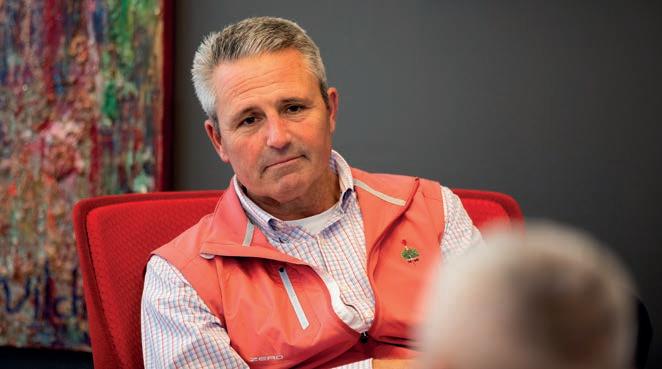
The concept of being different is something that Infor has grown comfortable with over a decade of bringing firsts to a market that has consistently churned out anything but dif-

The partnership between Koch and Infor has the potential to catalyze the type of change that many ERP customers have been looking for. A long-term partnership with mutual benefit at the core and a vendor committed to each stage of the ERP journey, from sale, to implementation and beyond.
I asked at the start of this article, what does a paper company know about ERP? Perhaps the question should have been, what can an ERP vendor learn from a paper company? Infor has always been an innovator and demonstrated true differentiation in a market where that is a scarce commodity. In Koch it has found a parent that understands its customer base and will continue to foster innovation by encouraging experimentation and radical thinking.
I started my journey to NYC skeptical that a marriage between Koch and Infor could work. I left believing that every ERP vendor would benefit from taking a leaf out of Hannan’s playbook.
61 visit us ERP.TODAY
“IF YOU THINK ABOUT OUR HISTORY, IT WAS A MILE WIDE AND AN INCH DEEP. WE HAD A LOT OF PRODUCTS BUT OUR FUTURE IS REALLY ON A VERY SMALL NUMBER OF INDUSTRIES.”
UNCERTAINTY BATTLING IN A HYBRID WORLD

FROM 2022 TO WHAT’S AHEAD IN 2023
 BY STEPHANIE BALL
BY STEPHANIE BALL
IS 2023 THE YEAR OF THE EMPLOYEE?
FIND OUT WITH ORACLE NETSUITE, ACCENTURE, FINANCIALFORCE, EPICOR AND MORE.




62

visit us ERP.TODAY 63
Talking to a breadth of enterprise technology experts about their takeaways from 2022 and predictions for the coming year, a common narrative emerged. As much as businesses grapple for savings and a big return on investment (ROI) push, the saving grace will be finding the best fit in the new hybrid world era, both for people and technology.
As enterprises have rushed to adapt to a work-from-everywhere era, they’re left figuring out how best to structure sets of hybrid technology solutions: whether to use piecemeal multi-vendor solutions, hybrid and multi-clouds, or a sprinkling of enterprise apps, has largely remained a puzzler.
Many are caught between consolidating and strengthening the core ERP backbone or bolstering the legacy system with top-layer platforms and tools. Not to mention finding the best interoperable apps to diversify business capabilities for the better.
For success in uncertainty, businesses are turning back to their fundamental values to produce the best results. Focusing on areas like upskilling existing team members, adding tools to aid employee and operation productivity, efficiency and sustainability, and prepping for new environmental, social and governance (ESG) legislations, might actually be the way to create the most return on investment.
With the quest for talent and technol-
ogy ROI being so central, it seems that somehow, despite the recession and a more-for-less mentality, this might just be the year of the employee and ESG. Find out more as ERP Today talks to experts from SAP, Oracle Netsuite, Accenture, FinancialForce, Epicor and many more.
THE HYBRID TRANSITION AND ACHIEVING MORE FOR LESS
Andy Campbell, global solution evangelist at FinancialForce:


In 2022, the transition in the enterprise technology industry, with companies’ business leaders switching from legacy, on-premise ERP solutions to the cloud, increased. The pandemic underlined the significant advantages of leveraging cloud; in particular how it allows employees to work remotely.
With the rise of hybrid working, companies have realized that they can operate remotely in an efficient and effective manner. This provides cost-saving benefits to the organization and enhances the work/life balance of its employees.
For 2023, the new reality is that there is a lack of money in the general economy, while companies are also intent
on maintaining profitability but not increasing their headcount. As such, businesses will be trying to get more for less or more for the same.
Companies are still embracing transformation initiatives, but they are being undertaken with greater clarity and increased rigor over ROI. What’s more, ERP vendors will prioritize customer success. A lot of SaaS providers are lagging behind. As such, there will be an increased focus on professionalizing the role and ensuring it is recognized by customers as providing much more than just support.
As the SaaS model matures, software companies need to ensure that they can support an increasing range of revenue streams including subscriptions and managed service contracts. But enterprises have got to make sure that they’ve got robust mechanisms in place to manage their revenue recognition obligations and compliance with IFRS 15 regulations in particular.
Martin Schirmer, president of enterprise service management at IFS:
2022 was a year of ongoing disruption. From the cost-of-living crisis to the Great Resignation, individuals, organizations and industries were forced to adapt at speed. In turn, this has brought new ways of working that are reshaping today’s business landscape.
Last year we saw the democratiza -
64 ERP TODAY | UK / EMEA | Q1 2023
“BUSINESSES WILL BE TRYING TO GET MORE FOR LESS OR MORE FOR THE SAME”
- ANDY CAMPBELL / FINANCIALFORCE
| EXPERT OPINION | PREDICTIONS
AFTER TWO YEARS OF REMOTE WORKING FOR MANY, IT SEEMS HYBRID WORKING IS HERE TO STAY, CREATING THAT MUCH-NEEDED FLEXIBILITY FOR WORKFORCES THAT HAS BEEN REFLECTED IN A DIVERSIFIED ARRAY OF ENTERPRISE TECHNOLOGY STACKS.
tion of enterprise service management (ESM) move to the top of the agenda for many ambitious organizations. This has meant digitizing processes and building effectiveness through workflow for everyone in an enterprise, regardless of their department, which is particularly critical when managing hybrid environments and processes.
In 2023, we’ll see more organizations opting for leaner, more agile approaches to digitization.
As organizations look to deliver efficiencies across the board, automation capabilities will also move to the front and center. Automating routine, manual tasks will reduce workloads and errors. At the same time, this will enable employees to focus on more creative, fulfilling aspects of their role.
Then there’s the financial aspect to consider. In the current economic climate, getting a handle on IT spending is paramount. Ensuring costs are down without thwarting digital transformation progress will be critical.
predecessors, has given ESG a pivotal role in recruitment, retention and brand loyalty. Creating and maintaining a robust ESG strategy hinges on a business’ quality and breadth of data. Cloudbased solutions will be vital to aggregate information from all parts of the business, shape realistic targets and monitor progress that will satisfy customers, employees and investors alike.
In 2023, as uncertainty continues, businesses should focus on making their digital capabilities more robust to protect against risk. Auto-pricing will enable high-growth businesses to remain agile and budget more effectively. This technology will allow businesses to respond to fluctuating supplier prices and maintain accurate cash flow forecaststo centrally manage pricing, ensure consistency across all channels and amend product prices in line with margins.
REDEPLOYING BUDGETS FOR EFFICIENCY AND SKILLS BOOST
Ulrik Nehammer, president, EMEA at ServiceNow:

ing year.
As the world is gripped by soaring inflation, intelligent digital investments can be a huge deflationary force. Business leaders are already shifting investment focus to technologies that will deliver outcomes faster.
Going into 2023, technology will become increasingly central to business success - in fact, 95 percent of CEOs are already pursuing a digital-first strategy according to IDC’s CEO survey, as digital companies deliver revenue growth far faster than non-digital ones.
Business transformation also requires talent transformation, and employers will continually need to upskill their employees to get to grips with the technologies that will drive success. Boosting digital skills as part of digital transformation is a win-win for organizations as closing the digital skills gap could add $11.5tn to global GDP by 2028, according to the World Economic Forum
Ranga Bodla, vice president of field engagement and marketing at Oracle NetSuite:


For 2023, the growth at all costs era is officially dead and businesses will be much more careful about where they place big bets.
The most difficult task facing CFOs in 2023 is the hiring and retaining of staff. The battle to attract top talent is fierce, and as finance leaders keep their teams lean in times of recession, they need to get creative. Automation will be a vital investment for finance teams, not only to do more with less people, but to give professionals more time for value-add projects.
Customers, employees and investors want to deal with brands that ‘do good’. Customer demands for transparency, and younger generations holding employers to higher standards than their
Organizations are facing an incredibly complex and volatile macro environment and, as they manage this environment of uncertainty, business strategy and decision-making is being put under the magnifying glass. A focus on business transformation for efficiency and ROI - more than what’s ‘new’ - will be top of mind for the com-
Interest rates will remain high in 2023 as the Federal Reserve continues its fight against inflation. The combination of inflation and high interest rates mean margin pressures and dampened consumer spending. Businesses should continue to prioritize maximizing cash flow and tracking any signs of changing demand. This will require businesses to have strong visibility into revenue streams and changing costs of goods sold.
Inventory and supply chains will continue to fluctuate in 2023, and strategic stockpiling will continue to be a key way
visit us ERP.TODAY 65
Nicky Tozer, senior vice president, EMEA at Oracle NetSuite:
“AUTO-PRICING WILL ENABLE HIGH-GROWTH BUSINESSES TO REMAIN AGILE AND BUDGET MORE EFFECTIVELY” - NICKY TOZER / ORACLE NETSUITE
“WE’LL SEE MORE ORGANIZATIONS OPTING FOR LEANER, MORE AGILE APPROACHES TO DIGITIZATION” - MARTIN SCHIRMER / IFS
to ensure that businesses are not tying up cash in inventory while also having enough inventory on hand to fulfill customer orders.
Significantly improving efficiencies in the finance function and beyond, automation will be the key approach to managing the talent shortage that will persist for years. Businesses looking to optimize and streamline their operations will look carefully at their existing software portfolios and see where they can consolidate spending.
STRATEGIC INVESTMENTS TO MAINTAIN YOUR TECH BACKBONE
Clare Hickie, chief technical officer for EMEA at Workday:


In 2023, technology will influence the employee experience more than ever before.
With technology playing a role in every employee touchpoint, CIOs are in a unique position to help create the ultimate employee experience. Deploying inclusive and accessible technologies that ensure every team member can bring forward their best work results in happy employees, boosted retention rates and a competitive edge.
Platforms, apps and technology solutions have grown at a high rate. All the choices can lead to the proliferation of various apps, platforms and tools. We’re seeing more redundancy throughout organizations. Technology will need to be optimized through the consolidation of platforms and apps.
Even as the economy softens, the demands on our technology become ever higher. While CIOs focus on helping their organizations meet this moment, they must continue to prepare for tomorrow. Businesses will need to futureproof their technology for recession. This doesn’t mean purchasing every new app and piece of software. It’s about making strategic investments that maintain your tech backbone, while building the technology for the future.
Stephane Maes, CTO and CPO, enterprise service management at IFS:

In 2022, we saw more and more organizations come to the realization that their legacy IT service management (ITSM) systems are no longer fit for purpose. For example, many have struggled with tracking and locating events, while dealing with a lack of seamless integrations with multi-tenant applications. Essentially, their outdated, expensive and hard-to-scale ITSM solutions have quickly become more of a problem than a solution.
These issues have not only led to wasted time and resources but have snowballed together to affect overall service experiences. Keeping on top of security, in particular, is important as cyberattacks become increasingly complex.
Business-critical operations are becoming increasingly dependent on technology. This is especially true in hybrid work environments where success is dependent on providing seamless digital experiences across every device, no matter where employees are based.
Security is a key part of this puzzle. As organizations’ IT ecosystems grow in
various cloud solutions (public, private, hybrid and multi-clouds) across the business to meet compliance and performance requirements.
Distributed cloud will quickly become a ‘must have’ for many organizations. Using this approach, one central location manages resources across different departments, in multiple locations. This gives business leaders greater visibility of their assets, while providing scalability and agility that is cost-effective.
Emma McGuigan, global lead, enterprise and industry technologies at Accenture:
Over the past two years, companies have faced an unprecedented number of black swan events that have required them to adopt new technology to transform their businesses faster than ever before. Enterprises rushed to get new applications up and running to keep the lights on but, as we go into 2023, they now have the tricky job of untangling it all to make it work more cohesively and provide ongoing business value.
complexity (involving numerous devices that are accessible from anywhere, anytime), it is absolutely vital that governance, compliance and cybersecurity are embedded into everything an organization does. The threat landscape is expanding, meaning attacks are growing in both frequency and complexity. To this end, we’ll see more enterprises doubling down on zero-trust IT strategies to eliminate explicit trust.
Effective management of distributed cloud environments will be a top priority. Organizations are implementing
We’ve found that this can be accomplished through high interoperability. When business applications are interoperable, there is greater data sharing, transparency and better human connections, which allows organizations to pivot quickly and increase resilience.
Leaders can maximize interoperability and achieve compressed transformation by focusing on the cloud, composable technology and collaboration. In 2023, we predict the value opportunity opened up through interoperability is one that cannot be ignored.
66 ERP TODAY | UK/EMEA | Q1 2023 | EXPERT OPINION | PREDICTIONS
“WE EXPECT AN INCREASE IN HIRING AND VALUING DIGITAL NATIVES WHO UNDERSTAND ANALYTICS” - STEPHEN EDGINTON / EPICOR
 Stephen Edginton, chief innovation officer, SVP engineering at Epicor:
Stephen Edginton, chief innovation officer, SVP engineering at Epicor:


Moving to the cloud is already reaping rewards for those who have made the change. According to our recent 2022 Industry Insights report, 46 percent of b usinesses in our core sectors are now primarily or entirely in the cloud. 90 percent of those we spoke to earlier in 2022 indicated their move to the cloud was worth the effort, having realized a variety of transformational benefits, including improved flexibility and adaptability, better security, simple regulatory compliance and enhanced business resilience.
But as our turbulent economy is resulting in more mergers and acquisitions, businesses can either diversify or consolidate to survive.
Interestingly, our research shows that 78 percent of SMBs in manufacturing, distribution, building supply, automotive and retail industries changed their core business models over the last year to better compete. However, without accurate data insights, it’s impossible to make the right strategic decisions. As more companies develop their data strategies in 2023, we expect an increase in hiring and valuing digital natives who understand analytics to help unlock further business value.
A data-driven approach will create a collaborative ecosystem in which organ-
izations can collectively share their anonymized datasets. Once a strong digital foundation and effective data strategy are in place, we expect an increase this year in people-centric automation tools, digital work instructions and intelligent integrations.
MORE THAN JUST IT
In 2022, organizations often moved away from a midmarket solution to an enterprise ERP system as the level of transactions and data that needed to be stored continued to increase. As cloud software, in-memory computing and connectivity improved throughout 2022, many organizations took the opportunity to replace their customized ERP systems, which often date from the 1990s, with new ‘greenfield’ options.
For 2023, increasingly sophisticated and enterprise-grade ERP systems are providing additional functionality to build in automation across departments, more sophisticated reporting, planning and overall, eliminating the need to manage multiple standalone systems. This year, organizations must think carefully about their options, giving themselves sufficient time to create a strategy and a corresponding roadmap.
This will require the involvement of more than just the IT team - resources need to be put in place that understand the business requirements and have sufficient authority to make future-state decisions.
Keith O’Kelly, chief revenue officer, enterprise service management at IFS:

The battle for talent brought employee experience into focus in 2022. Mass quitting and severe talent shortages pushed many organizations to reconsider the wellbeing of their staff. Initially held back by uncertainties surrounding the pandemic, people quit in droves last year as if reaching a tipping point, faced with extreme burnout and stagnant wages.
To combat this dissatisfaction, improving the employee experience became essential in order to win the battle for talent.
Faced with a tough economic landscape and a constantly shifting labor market, the pressure to keep both employees and customers happy has never been higher. To navigate this reality, organizations will double down on delivering excellent experiences and improving satisfaction levels in 2023. We will likely see more enterprises looking to unify employee and customer experiences to promote greater synergies in the workplace.
Extending ITSM beyond IT - connecting employees and customers, and one business department to another - will enable organizations to move fast and respond swiftly to the evolving needs of their industry and people.
It is no longer solely about focusing on the customer or employee experience in isolation, but rather the total experience. Business processes will be reshaped by this approach; by implementing ESM and creating a connection between the two, this will enable organizations to break down silos, identify all touch points and optimize the end-toend service experience.
68 ERP TODAY | UK / EMEA | Q1 2023 | EXPERT OPINION | PREDICTIONS
Anthony Byrne, partner technology consulting at EY:
“A FOCUS ON BUSINESS TRANSFORMATION FOR EFFICIENCY AND ROI WILL BE TOP OF MIND” - ULRIK NEHAMMER / SERVICENOW
“THE VALUE OPPORTUNITY OPENED UP THROUGH INTEROPERABILITY IS ONE THAT CANNOT BE IGNORED” - EMMA MCGUIGAN / ACCENTURE

SUCCESSFUL ESG STRATEGIES
Cathy Mauzaize, vice president, EMEA south at ServiceNow:

2023 is the year ESG is integral to every company’s strategy. Failure to engage appropriate investment in ESG strategies could plunge any organization into crisis. Legislation must be respected and so must the expectations of employees, investors and your ecosystem of partners and customers.

ESG strategies must be carefully curated, taking four key truths into consideration. First, there is no ESG in a box. How you approach your strategy also depends on the maturity and scope of your operations. Second, talent is crucial. Hiring digitally minded, environmentally focused employees will help mitigate any emerging skills gap. Third, companies should take a control tower approach. Leveraging the right technology which feeds back progress, data, insights and intelligence is vital for success. The fourth variable is innovation. The wider ESG agenda is
more like an evolving organism than a timeless axiom. Constant innovation to find novel solutions and continuously engaging with ESG issues is vital to any strategic success.
ESG is not just a tick box, one and done, it’s a new way of business that will see us through 2023 and beyond.
Stephen Jamieson, global head of circular economy solutions at SAP:
Over the course of the next twelve months, businesses will have to comply with stricter legislation for sustainability reporting. While leaders have faced increasing pressure to disclose their environmental impact for some time, new regulationsincluding the EU’s Corporate Sustainability Reporting Directive - will now make this a necessity.
From 2024, businesses will have to disclose data around their overall impact on the environment, while initiatives such as the UN’s Plastic Treaty will soon offer a legal framework for tackling plastic pollution. It is therefore critical that leaders are prepared in advancethis starts with identifying gaps in reporting and integrating sustainability metrics into core business processes and objectives. This will future-proof operations against changing regulations, while also supporting the transition to more sustainable business models grounded in the circular economy.
LEVERAGING NEW METAVERSE TECHNOLOGY
Paul Hardy, EMEA innovation officer at ServiceNow:


In 2023 and beyond, we will see business leaders begin to leverage technologies, such as the metaverse, to help cultivate and maintain employee engagement as businesses continue working in hybrid environments, in an increasingly challenging macro environment. Given the current economic climate, adoption may be slow, but in the future, a network of 3D virtual worlds will be used to foster meaningful social connections, creating new experiences for employees and reinforcing positive culture within organizations.
Leaders have begun to see the benefit of hosting traditional training and development sessions using VR and AI-enhanced coaching. In the next few years, we will see more workplaces go a step beyond this; for example, offering employees the chance to earn recognition in the form of tokens they can spend in the real or virtual world, gamifying the experience.
As metaverse technologies become both more complex and commonplace, we will see businesses seek out digital platforms to help connect metaverses to each other, and to the physical world, so networks do not become siloed. In an ideal scenario, businesses would be able to support the continuity of data and experiences across platforms, systems and worlds.
The right platform will need to integrate metaverses under a robust system of governance so that organizations can track their assets, communicate transparently about status and data storage, and build hyper-personalized experiences.
“ORGANIZATIONS MUST THINK CAREFULLY ABOUT THEIR OPTIONS, GIVING THEMSELVES SUFFICIENT TIME TO CREATE A STRATEGY AND A CORRESPONDING ROADMAP” - ANTHONY BYRNE / EY
| EXPERT OPINION | PREDICTIONS 70 ERP TODAY | UK/EMEA | Q1 2023
“KEEPING ON TOP OF SECURITY IS IMPORTANT AS CYBERATTACKS BECOME INCREASINGLY COMPLEX” - STEPHANE MAES / IFS
Value as a Service
Changing the conversation to unlocking innovation, releasing hidden value and maximising your return on investment in Oracle SaaS Cloud and ServiceNow





Moving your mission critical business applications to the cloud is only the start. You need a partner that you can trust, who understands your business and will guide you as cloud continues to evolve.
Value your business?
Adoption
Unlocking value realisation savings through high end user adoption, ensuring outcomes promised are realised.


Optimisation





Innovation Optimising
Choose de Novo and together let’s change the conversation
Not satisfied with your existing managed service provider? Or looking for Oracle SaaS Applications and ServiceNow support that goes beyond just raising tickets? Then come talk to de Novo and together let’s change the conversation.


de-Novo-Solutions
@deNovoSolutions | #wearedenovo
www.de-novo-solutions.com
™
Efficiency
Accessing cloud innovation that is relevant for your business, maximising your return on investment. your cloud usage by following best practice that promotes differentiation through personalised experiences.
When was the last time your managed services provider asked you about your business?
Microsoft’s hard macro outlook
 BY GIACOMO LEE
BY GIACOMO LEE
Interview with Ray Smith, supply chain chief at Microsoft on black swan events and data lakes
72 ERP TODAY | UK / EMEA | Q1 2023
BLACK SWAN ALERT
Towards the end of last year, Microsoft launched its first supply chain disruption solution in the form of Microsoft Supply Chain Platform, which bundles together AI, collaboration, low-code, security and SaaS applications in a composable platform. Coming with the service is Microsoft Supply Chain Center, a command center experience carrying data from across existing infrastructure supply chain systems, such as data from Dynamics 365 (naturally), and other ERP providers, including SAP and Oracle , along with standalone supply chain systems.
With war, pandemic, delivery disruptions and energy crises having defined the decade so far, the Microsoft solution makes easy business sense. So easy, in fact, one may wonder why it’s only coming out now. But as Ray Smith, vice president supply chain at Microsoft, tells Giacomo Lee, Redmond doesn’t see supply chain disruption as a blip nearing its end. Instead, disruption is here to stay into 2023 - and beyond.
Giacomo Lee (GL): What are you trying to achieve with the Microsoft Supply Chain Platform?
Ray Smith (RS): We’re really trying to create an interoperable approach in the market. What is fundamentally challenging are many disparate solutions processes, which result in fragmented data largely being isolated in businesses. The last couple of years have really exposed the frailty and failings of these systems, and customers are simply craving end-to-end visibility.
Our platform (unifies) our assets and some key industries. It has an ecosystem, unified data, and unlocks some AI capabilities, while creating more disruptive collaborative workflows, whether that’s through automation or connecting across users.
GL: Microsoft is touting this as a first, but does it build on anything that’s come before?
RS: We manage two very complex supply chains, one for data centers, another for provisioning of hardware for devices. We’ve had our own journey of a number of key investments in third-party solutions, and frankly we’ve struggled; we lived in spreadsheets probably five years ago, and we’ve struggled to get into visibility and connectivity.
So internally there was a journey to invest in kind of data lake technology, ways to build and develop analytics. And when we looked at the market, we saw customers were trying to do the exact same thing. With all our assets across our investments in Power BI, and in core supply chain execution products, the opportunity we spotted was that if we stitch these elements together for ourselves, and make that much easier, we’d be better able to offer that to customers who have
very similar challenges of disparate multi-vendor solutions, lacking that end-to-end visibility.
GL: Before Microsoft, you had experience with SAP, Accenture, MIT. How does this past experience equip you with tackling supply chains today for Redmond?
RS: Customers typically talk around unlocking end-to-end visibility, and I often challenge back a bit. I have a background in startups, and if 15 years ago, I went in to pitch a VC and proposed helping to unlock visibility in the CRM market, they would kind of laugh you out of the room because that’s the most lowest level of access to your information.

So it’s really around not just visibility or deriving intelligence, it’s [more] around disrupting workflows. 15 years ago it was all about bringing fast value to customers with novel solutions. Fast forward to now, and I can see supply chain startups find it difficult to break in.
I think my experience on the CRM side and building a startup really highlights the need for an open, platform-based approach that creates an ecosystem and leaves customers to choose the optimal solution.
visit us ERP.TODAY 73
RAY SMITH
GL: What kind of supply chain problems are you seeing currently? I’m asking that because supply chain can mean so many different things.
RS: It’s really about disrupting workflows. How do you get those business outcomes rather than having some magical data sitting in a database or a dashboard? For me, it’s really a case of how do we unlock and unify data across all these providers.
Customers really want to have a better understanding of the inventory at hand. A good view on demand planning based on many more signals than they’ve ever had before is a critical problem.
Problem number two is, now I’ve got a good handle on my demand forecast, how do I make an optimized inventory? How do I see across the chain to spot risks, shipping issues, blockages on ports?
Lastly, how do I get a unified field of all my orders across
tems which relied on just historical transactional inputs were really kind of rigid and didn’t offer the opportunity to explore new markets, or optimize margins by shipping in a certain way, or fulfilling products in a certain way.
So people need more signals, more data. Instead of just that transactional data, there’s also shipping lane information, all these external signals from trading partners and suppliers, (signs) if your crop is going to fail.
That info hasn’t been harnessed to that scale. And that’s where AI comes in to really unlock all this volume of data, and get it to the fulfillment manager or supply chain manager.
GL: How’s AI going to solve this?
RS: AI is really hitting a new age of disruption. But if you don’t start with the data, AI on top of that is almost meaningless. So unification of data is critical.
Now we can do really, really exciting AI algorithms around
multiple channels, and then orchestrate those orders? It’s optimizing the inventory, but also minimizing the logistics cost. Logistics, particularly for large items, is expensive, and that’s not mentioning the sustainability impact.
Some have invested in kind of dumping all that data into a data lake, but then it stops being operational or actionable. So that’s really where we see our solution stepping in to bridge that gap and interoperate with all these solutions.
GL: You mention port blockages, so how sensitive can something like this be to outside factors? A lot of what’s happening now is due to geopolitical forces, for example.
RS: There are a number of factors obviously, from materials shortages, which, as you said, are mostly stemming from geopolitical tensions, to domestication of supply chains in various initiatives across the world.
Expect these challenges to continue, not to mention ‘black swans’. A little ripple has a pretty big effect, and then there are more and more ripples, more and more disturbances, which we expect to continue.
But I would say a lot of businesses are realizing that old sys -
how we restock, how we do container repositioning. With the help of machine learning and algorithms we can start getting more predictive on what we should remediate, what is the risk level, what is the weather pattern and how’s that likely to cause disruption in our logistics and so on.
But we know customers have a unique supply chains, and we know they have been investing in data science themselves. So, customers can bring their own algorithms to the table and plug that into the platform.
GL:
What are your predictions for 2023?
RS: The question that gets asked regularly from people is, do you think we’ve just had a few ripples together and it’s all going to go even keel and flat again? And can we kind of get back to the way we were with existing systems?
The short answer is that the level of disturbances we’ve seen, the level of geopolitical tensions we still see in the world, mean that it’s something supply chain leaders and managers need to be able to handle.
[It’s not] a scare tactic, it’s just the reality of what we’re seeing, and it’s only increasing.
74 ERP TODAY | UK / EMEA | Q1 2023 | INTERVIEW | PREDICTIONS
Frankly, Microsoft has struggled - we lived in spreadsheets five years ago, and struggled to get into visibility and connectivity.
Discover more on the Chain Flow Accelerator for SAP ERP





























Vertex Indirect Tax Chain Flow Accelerator



Streamline chain flow data mapping and improve VAT/GST accuracy












LIVE NOW EPISODE 1

DELVING DEEPER INTO THE WORLD

@ERPTODAYTV
OF ENTERPRISE TECHNOLOGY


ERP.TODAY/TV

78 ERP TODAY | UK/EMEA | Q1 2023
ATale Hospitals of Three
Defining the smart hospital in 2023 - and searching for its existence in the UK with the NHS and enterprise tech
GIACOMO LEE
BY
visit us ERP.TODAY 79
1247
World population feasibly between the 360-500 million mark. The first incarnation of the Bethlem Royal Hospital was established in this year, with later centuries seeing it move around various London locations. The same passage of time saw the hospital become an asylum for mental health patients, notoriously acquiring its other name of Bedlam.
1914
Earth population somewhere under the two billion mark. The same year saw the founding of Alder Hey Children’s Hospital in Liverpool, UK. In 1944, the hospital would become the world’s first hospital to test penicillin and less than a decade later, the UK’s first to ever establish a neonatal unit.
1984
In response to Milton Keynes’ growing population, the Milton Keynes University Hospital (MKUH) is opened; the previous decade has seen a campaign in the Buckinghamshire city under the slogan of ‘Milton Keynes is Dying for a Hospital’. The world population in ‘84, meanwhile, nears the 4.8 billion mark.
Today, the planet’s population stands at eight billion. Almost 68-69 million of the global populace resides in the UK, a country reliant on the NHS for healthcare needs at any given minute of the day. Over 1.2 million people are employed by the health provider on a full-time basis, making the NHS the world’s ninth biggest employer. According to pre-pandemic figures, it manages over 1,200 hospitals in the UK, offering around 141,000 beds to patients.
Post-pandemic, the NHS has made headlines with staffing issues arising from Brexit, COVID-19 pressures, declining funding, and a very recent strike by nursing and ambulance staff. The UK is currently undergoing a winter of woe, begging the question of what solutions, if any, can be found in 2023.
An answer may or may not be found in headlines of a different sort, as coming from the tech press. Oracle , one of the NHS’ largest technology providers, recently swallowed up US healthcare giant Cerner with an extra $1.5bn profit enjoyed as a result. Microsoft continues to implement the AI software of big acquisition Nuance to power medical imaging and handling inbound calls from patients. Amazon is getting into telehealth within the US, and over in the UK, data-mining tech from Palantir will soon be used by NHS Digital to manage patient data, if it isn’t already.
But what about the reality, in that strange space where medical care and hyped technologies meet? How is the NHS answering the call as the United Kingdom continues crying out for better hospitals? ERP Today separates fact from fiction by looking at modern-day tech use in the establishments of Bethlem Royal, Alder Hey and Milton Keynes University Hospital NHS Foundation Trust. In these three hospitals, enterprise tech from the likes of Microsoft and Virgin Media 02 are helping the NHS as the enterprise celebrates its 75th anniversary, and bringing the smart hospital further into everyday British life.
80 ERP TODAY | UK / EMEA | Q1 2023
| EXPERT OPINION | HEALTHCARE
DIGITAL EMPATHY
Come across the term ‘smart hospital’, and you’re likely to think of grand and brand new buildings usually to be found in APAC and the Middle East, decked out with smart beds and robot-assisted surgical units.
In the UK, the truth is far more prosaic, as no such smart hospitals are under construction in the country. Google ‘NHS smart hospital’ and one of the top ranking hits is an article by myself from a few years ago. Not much has changed since the writing of that article as, like in that piece, the current picture painted for smart hospitals in the UK is one of slow augmentation to current centers as opposed to shiny new medical techtopias. In fact, in the NHS’ view, an abundance of tech isn’t even the most essential ingredient.
“A smart hospital isn’t a building with lots of smart technology inside; it’s a system where care is optimized by smart healthcare personnel who are supported by digital technology within a healthy environment,” says Claire Orchard, head of digital innovation at MKUH. “To understand how to build a smart hospital, we know that focusing on the whole is greater than focusing on the sum of parts. A smart hospital will enable all healthcare personnel to identify value within the system of care and collaborate to continually adapt as challenges emerge. A smart hospital will prioritize interventions based on where value and experience is needed most.”

Last spring saw MKUH partner with Finnish startup Haltian to pilot the lat-
ter’s digital twin solution, Empathic Building Smart Hospital. The pilot launched within the hospital’s cancer center before expanding later in 2022 to its cardiology unit, where both MKUH and Haltian can access and monitor building information and sensor data. The information from such data helps support NHS staff in utilizing space with maximum efficiency.
Speaking with ERP Today last year, Haltian chief product officer Gunnar Hansen explains that the digital twin tech can make smart hospitals out of ‘dumb’ ones.
“Hospitals are (very interested) in this kind of technology because they have been overspending on really complex projects over so many years. I think what they like with this system is that we deliver results and we can also make an old hospital ‘smart’.”
The tech can track patients as they use the space of MKUH in an anonymous manner. If one carries a virus and accesses different parts of the hospital,
sensors can plot the patient’s journey and relay the information to cleaners, thus minimizing potential virus spread.
Empathic Building also keeps track of objects, such as workstations on wheels (WoWs). Ubiquitous in hospitals around the world, these computer carts can often get left behind in rooms following use, meaning colleagues have to hunt down a WoW when they aren’t brought back to a common location. Not an ideal situation in the large space of a hospital, but it’s one which Haltian seems to have found a solution for.
“The platform has enabled staff to find one another and equipment faster, as well as discuss new processes around medicines management and smart cleaning schedules,” reveals Orchard. “[It] is intuitive and simple to understand, regardless of a person’s technical skillset, and the user interface organically fosters a sense of togetherness between teams.”
“It’s all about the user experience for all users of the building, from patients to staff,” says Hansen. “Our dream is that the patient receives a letter to come to the hospital; they navigate themselves to where they need to go, and this ensures they can do that with fewer guiding hands in the building.”
Less pressure on personnel is always a boon in healthcare. As Orchard tells ERP Today, challenges within MKUH can be seen where “clinical activity is rising faster than the rate in which our workforce is growing”.
visit us ERP.TODAY 81
“A SMART HOSPITAL ISN’T A BUILDING WITH LOTS OF SMART TECHNOLOGY INSIDE; IT’S A SYSTEM WHERE CARE IS OPTIMIZED BY SMART HEALTHCARE PERSONNEL”
CLAIRE ORCHARD, MILTON KEYNES UNIVERSITY HOSPITAL
“Surrounding this, our buildings are aging and do not provide an optimum experience for patients,” continues the innovation lead. “Our smart hospital journey will start by addressing these challenges first [with] automation to reduce administrative tasks, communication to improve collaboration between people, and safety to improve wellness. We’ll look to harness this data to automate processes that support our workforce and create personalized care environments for our patients.”
The good news for technology providers is that, according to Hansen, working with the NHS involves far less red tape than with Scandinavian health providers. Haltian’s deal with MKUH only took a few months to arrange and implement. So much for Nordic efficiency.
FROM 1930 TO NOW: ZERO G TO 5G
“In the end, we want to improve the way the NHS is providing services to the population.”
So says Sergio Budkin, director of market development (AI, data analytics and 5G IoT) at Virgin Media O2 Business. Last summer, Budkin and company helped the Bethlem Royal become the UK’s first 5G-connected hospital. Not bad considering the establishment has been in its current location for 93 years.
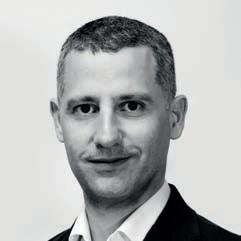

Virgin Media O2 Business switched on the hospital with South London and Maudsley NHS Foundation Trust , provider of the most extensive portfolio of mental health services in the UK. The switch-on is part of Maudsley Digital Lab ’s series of digital health and innovation trials funded by NHS Digital, with the private 5G network providing dedi-
cated connectivity for digital health use cases for both clinicians and patients.
Enabled across some of the wards in the Bethlem Royal Hospital are Maudsley Smart Hospital and Maudsley Smart Pharmacy trials; these include near realtime connectivity to power e-Observations, where clinicians use handheld devices to update patient records. 5G also allows link-up for smart devices and monitoring to reduce expensive medicine waste and monitor the air quality in wards. An AR tool allows hospital IT teams access to expert maintenance support in other hospitals, and similarly to MKUH, better spatial insights through AI-analyzed heat maps of crowd movement analysis using CCTV footage.
Budkin reveals to ERP Today that there are also plans to test use cases for robotics, tech which can operate thanks to the super low latency and high bandwidth offered by 5G. Again, that’s an impressive feat for one of the UK’s oldest hospitals.
“The beauty of this technology is that it’s designed so you don’t need to mess with the physical space. You only need to provide an antenna and connectivity to radiate the signal,” the director adds.
“We want to help the NHS do more with the same amount of current resources. We also want to make things
more accessible and easier to use for patients and clinicians, and use technology to prevent illness from developing.
“Finally, there’s the underlying topic of sustainability, because you reduce waste, do more with the same amount of resources, reduce energy consumption, and with remote health care, you reduce commuting time. All of that has an impact.”
HOSPITALS WITHOUT WALLS
Watchers of enterprise medtech may be familiar with Alder Hey Children’s Hospital. Microsoft has solid footing in the hospital’s Innovation Centre, with recent surgical uses of Redmond’s HoloLens 2 smartglasses, alongside AI algorithms designed by the company to predict bed space utilization.
2022 saw Microsoft UK, Alder Hey Children’s NHS Foundation Trust and tech startup Mindwave co-develop AlderHey@nywhere (AHAW), a digital health platform providing a hybrid point of access and patient care, with a particular focus on preventative healthcare. The solution is designed to create, in Alder Hey’s words, a “hospital without walls”. It echoes a view from Budkin that the smartest thing about smart healthcare is “you not needing to go to a hospital [and] staying there the least amount you need”. Anybody who’s waited overnight in an A&E waiting room will probably agree with this view (and perhaps wonder why the NHS App doesn’t allow one to check in upon arrival to a hospital, to be called back later when a doctor is available).
Away from this digression, and going back to AHAW, Umang Patel, chief clinical information officer, Microsoft UK, believes prevention is better than a cure,
82 ERP TODAY | UK / EMEA | Q1 2023
“WE WANT TO IMPROVE THE WAY THE NHS IS PROVIDING SERVICES TO THE POPULATION”
SERGIO BUDKIN, VIRGIN MEDIA 02 BUSINESS
“HOSPITALS HAVE BEEN OVERSPENDING ON REALLY COMPLEX PROJECTS OVER SO MANY YEARS”
| EXPERT OPINION | HEALTHCARE
GUNNAR HANSEN, HALTIAN
“and being at home is better for most people than being alone in a hospital bed when recovering from illness”.
“We won’t ever prevent all illness or injury, and at some point in every serious or chronic illness, the patient will have to stay in a hospital,” he continues. “Our sights have to be set on reducing the need where we can in the first place, but also on making sure that patients can flow in and out of different settings easily, safely and efficiently. This is where tech, especially co-created tech, can help in the here and now as we are seeing with AHAW.”
For Patel, in the context of healthcare, ‘smart’ needs to be “just a little better than today”, and, crucially, designed with scalability and future-proofing in mind.
“We don’t need hospitals to adapt to be fully AI controlled with robots on reception, but we do need to design them to have the right foundations for this next phase of healthcare. That means not only ensuring hospitals have simple things like a good network and enough power, but also credentials such as sustainable lighting and scalable computing assets.
“Smart hospitals also need to be part of new smart systems that are being born alongside greater integrated care. Being smart means being able to be a command center for the ICS, allowing safe virtual wards and having enough flexible space to use in an emergency.”
“To echo Umang,” says Jacob West, managing director, healthcare and life sciences at Microsoft UK, “for now, a smart hospital is one that is equipped with a good network with sustainable power and scalable resources. But the NHS’ work with tech firms has shown just what’s possible together.”

What enterprise tech needs to remember when entering the healthcare market, though, is that a different sort of approach is needed to the norm. Postpandemic, Patel argues, it’s vital for hospitals and technology partners to survey frontline workers in health on pragmatic solutions that resolve the most pressing situations for them and their patients.
“As we enter into a new stage of healthcare delivery, it’s vital that we canvass opinion from users of the tech from all sides,” says the CCO. “It’s also much harder in healthcare than in normal consumer product design to do this.
“In retail, for example, it’s usually a transaction that happens in a happy or at least neutral state. In healthcare, patients are often worried or concerned and professionals are often time-scarce, so the tech needs to be able to work for both - without adding stress or getting in the way of patient care.”

In West’s view, the pandemic, unsurprisingly, was a game changer for tech in healthcare. The MD points to the use of mixed reality (MR) headsets in Alder Hey and Imperial College NHS Healthcare Trust to enable remote monitoring, and live 3D capture which helped NHS Scotland bring specialized treatment to some of the most remote parts of Scotland, without the need for travel. Call it another plane of reality waiting for 5G to fully take off before this medical metaverse can manifest in the NHS.
“We’ve already seen how AI, MR and various other technologies can be used to help the NHS recover from the COVID-19 pandemic to free up hospital space and deliver more connected, integrated care for patients.
“The more we can do this,” West concludes, “the more we can aim to reduce the time people need to spend in a hospital through the use of technology, while also ensuring that when they are there, the right measures are in place so clinicians can effectively deliver the care they deserve.”
Perhaps, then, the smartest hospital you can visit is not a gleaming techtopia built out of bricks and mortar. Instead, if AlderHey@nywhere is anything to go by, it’s one which you don’t visit, an ethereal concept that instead comes to you, making your home the hospital.
That would certainly solve the NHS bed problem - hopefully in a matter of decades or, even better, years, as opposed to the passing of another century.
visit us ERP.TODAY 83
“BEING AT HOME IS BETTER FOR MOST PEOPLE THAN BEING ALONE IN A HOSPITAL BED WHEN RECOVERING FROM ILLNESS”
UMANG PATEL, MICROSOFT UK
“THE NHS’ WORK WITH TECH FIRMS HAS SHOWN JUST WHAT’S POSSIBLE TOGETHER”
JACOB WEST, MICROSOFT UK

84 ERP TODAY | UK / EMEA | Q1 2023
Consultancies eliminate a huge obstacle to recruitment
Ditching the degree
To meet huge demand from clients, consultancies are embarking on ambitious recruitment plansincluding doing away with a 2:1 degree requirement for new starters.
BY CHRISTINE HORTON
visit us ERP.TODAY 85
he UK consulting industry is currently experiencing one of its busiest periods in history, growing by a quarter in 2022 in response to increased client demand. To meet these requirements, firms of all sizes have embarked on ambitious recruitment plans.
Figures collected by the Management Consultancies Association (MCA) show the management consulting sector will create 10,000 new jobs as they invest in boosting their talent pipeline over the next three years. This, it says, will create record numbers of opportunities for school leavers, apprentices and graduates.
“The UK has one of the leading management consultancy centers in the world, and the strong demand globally and in the UK for our services from clients means firms are recruiting intensively to meet demand,” says Tamzen Isacsson, MCA chief executive.


The question is, from where is all this new talent emerging - especially in a competitive labor market where it is increasingly difficult to attract employees? The answer is that more consultancies are removing one of the biggest obstacles to recruitment by doing away with the mandatory 2:1 degree for new starters.
With that single move, consultancies are significantly widening the net when it comes to job applicants. More than 89,000 students graduated with lower second-class honors, third-class honors or a pass in the academic year 2021-2022, according to the Higher Education Statistics Agency - representing 21 percent of graduates.
Transforming recruitment policy
EY removed academic attainment from the entry criteria for its graduate, undergraduate and school leaver programs in 2015, the first of the Big Four firms to do so.
“We transformed our recruitment policy to help create a more even and fairer playing field for all candidates by focusing on their future potential,” explains Benoit Laclau, EY UK&I managing partner, consulting. “Since then, students have no longer been required to have a 2:1 degree classification to make an application.”
Last year PwC , too, removed the 2:1 degree criteria for new graduates.
“We believe that academic qualifications alone are not an indicator of workplace potential, so removing the 2:1 entry requirement has opened our roles to a greater pool of talent,” says Cathy Baxter, head of early careers at PwC.
“We were fortunate to have over 95,000 applications to our graduate and school programs last year, but this move isn’t primarily about attracting more applications. It enables us to open our roles to students from a broader range of backgrounds, including those from lower income households. It will allow us to continue our progress in driving the social mobility of PwC recruits.
86 ERP TODAY | UK / EMEA | Q1 2023 | EXPERT OPINION | TALENT
“it
ENABLES US TO OPEN OUR ROLES TO STUDENTS FROM A BROADER RANGE OF BACKGROUNDS, INCLUDING THOSE FROM LOWER INCOME HOUSEHOLDS” CATHY BAXTER, PWC
“we TRANSFORMED OUR RECRUITMENT POLICY TO HELP CREATE A MORE EVEN, FAIRER PLAYING FIELD FOR ALL CANDIDATES BY FOCUSING ON THEIR FUTURE POTENTIAL”
BENOIT LACLAU, EY
“When you consider the impact the pandemic has had on many students’ education, many students may be fearful about their futures. We want to show that academic achievement is not the only factor we look for when hiring, and that we want to identify those candidates who have the attributes and allround proven capabilities for a career within the firm.”
Passion over qualifications
The change is part of a current trend among global enterprises - for the first time, fewer than half of graduate employers now stipulate a 2:1 degree. The Institute of Student Employers (ISE) has found that the number of employers demanding a 2:1 degree as minimum entry criteria for graduate jobs fell to 48 percent in 2022, down from 57 percent in 2021.
“Employers are less concerned about the subject studied than students think, and even fewer look for a master’s qualification. A fifth of employers expect applicants to have a specific subject degree and only six percent require a postgraduate degree,” says the ISE.

Some commentators - from the usual places - have claimed that employers are “dumbing down” and giving in to so-called “wokeism” over the shift. But Laclau says it’s more important that future recruits demonstrate a passion for technology, rather than the relevant degree in technology consultancy.
“Our selection process is designed to identify students’ strengths where they can demonstrate their potential and motivation for the role, rather than just focusing heavily on their academic or prior experience,” he says.
Lending weight to the idea of enthusiasm over experience, IBM conducted some research in 2022 that highlighted how business leaders recognized ‘adaptability quotient’ as a better measure of their ability to thrive in any business environment than qualifications.
Says IBM’s UKI CEO Sreeram Visvanathan: “As the acceleration of enterprise technology continues to thrive, we risk falling behind if we do not find ways to encourage new talent. Today, every leader is a tech leader, and they will need to understand how best to leverage these capabilities to scale digital transformation at pace.”

Increase in apprenticeships
Work-based vocational learning programs that culminate in degree-level qualifications are also becoming increasingly popular. Apprenticeships in the consulting sector are expected to increase in record numbers this year as firms aim to bring in new and diverse talent.
In 2021, 1,200 trainees, apprentices or school leavers joined the sector, despite
ONSULTANCIES
NOWADAYS SEEK STUDENTS WHO ARE ABLE TO BE AGILE, ANALYTICAL MINDS WHO HAVE STRONG PROBLEM SOLVING SKILLS” DR ERAN PADUMADASA, QUEEN MARY
the pandemic, and a 2022 poll by the MCA of firms reveals that this figure is expected to increase by 25 percent. This is mainly driven by large firms who have on average 186 apprentices on program at any given time.
To that end, PwC also works with universities through its Flying Start degree apprenticeship program to broaden the opportunities available to students and help young people develop skills that are in demand from consultancies, but also across different industries and sectors.
“We understand that there isn’t a onesize-fits-all approach to a career, so employers must provide different routes to access the best talent. The Flying Start program enables us to reach and employ the most talented people. The program also creates a more affordable and alternative pathway to work which is key to improving social mobility - a priority for us. We believe that everybody should have opportunities to succeed regardless of their social background,” says Baxter.
The Flying Start program was set up 20 years ago in partnership with Newcastle University and Institute of Char-
visit us ERP.TODAY 87
RISK FALLING BEHIND IF WE DO NOT FIND WAYS TO ENCOURAGE NEW TALENT” SREERAM VISVANATHAN, IBM
“we “c
tered
Accountants
in
England and Wales (ICAEW). Since then, the program has been rolled out to a further four universities. Its newest program with Queen Mary University of London is at capacity.
“Consultancies nowadays seek students who are able to be agile, analytical minds who have strong problem-solving skills,” says Dr Eran Padumadasa, deputy dean for education (employer led education), faculty of science and engineering at Queen Mary and program director of the digital and technology solutions professional degree apprenticeship.
“A degree apprenticeship not only focuses on building knowledge but also develops real-life skills and behaviors allowing students to receive business experience while they continue their studies. [It also] helps them apply the knowledge at an early stage, helping them to build reflection on learning that will reinforce learning in the long term. With the program design we create opportunities for students to learn at the workplace by enabling work-based learning modules and allowing students
to apply the learning and build a reflective learning practice.”
Degrees not obsolete
These changes to the recruitment process in no way render degrees obsolete, says Lisa Rose, Accenture’s HR lead UK&I.

“In addition to technical knowledge, it’s important that new recruits come to us as critical thinkers and problem solvers - inspired by their knowledge and experiences at university and further education,” she explains.
“However, we recognize that degrees are not always a prerequisite, and that some people don’t always have the opportunity, or want, to go to university. We value having a diverse pool of talent from different backgrounds that better reflects the society we operate in. It’s having people with different perspectives that inspires innovative thinking. On that basis, we offer roles for graduates, and we are hiring more apprentices than ever.”
Rose says that Accenture broadened the criteria for new graduate recruits several years ago and have also been recruiting apprentices since 2013.
“We look to attract and develop people who are creative, technical, can solve problems and work well in a team.
“We use immersive assessments and contextualize applications, with the help of technology, in order to remove bias. We look for potential, rather than pedigree, and measure candidates on passion and motivation as well as hard skills. We are proud to open opportunities to all, regardless of background.”
Recruiting from a range of backgrounds, skills and experiences
The practical experience embedded on apprenticeship degree programs like Flying Start allows students to receive real-life experience and shape the behaviors valued by consultancies.
“Consultancies are nothing but a people business working with people to solve problems. Therefore, the biggest advantage of such programs is to equip students with real-life experience to ensure students understand behaviors and develop dispositions over their experience,” says Dr Padumadasa.
And with consultancies now looking further afield for candidates, they can more easily find the best candidates from a range of backgrounds, skills and experiences. This actually leads on to a much bigger conversation around companies realizing they need to be more socioeconomically inclusive. (McKinsey has announced a target for 50 percent of financial and professional services leaders to come from lower socioeconomic backgrounds by 2030, for example.) This diversity of voices helps organizations innovate and has a huge positive impact on the people who might apply for jobs at those organizations.
The ditching of the 2:1 degree requirement for candidates may prove positive for consultancies in more ways than they thought.
88 ERP TODAY | UK / EMEA | Q1 2023
| EXPERT OPINION | TALENT
IMPORTANT THAT NEW RECRUITS COME TO US AS CRITICAL THINKERS AND PROBLEM SOLVERS” LISA ROSE, ACCENTURE
“it’s
We help you understand the full economic cost of research to your Higher Education institution. Arribatec counts with two of original members from the Oxbridge project and we are unmatched globally as an RCP provider.

Implementation Managed service support Upgrades Reporting
UNIVERSITY CHALLENGED
With system delays, a tight deadline and even a cyber attack, one university needed to move fast with Unit4 and Arribatec.
Founded in 1828, the University of Central Lancashire (UCLan) is the 19th largest university in the United Kingdom, with plans to keep expanding its operation in the coming years. The organization is sizeable, with over 25,000 students, in addition to an almost 5000-strong workforce.

For any organization of this scale, not least of all, one in higher education, managing everyone’s data, payments and information cannot be an afterthought. In other words, an almost 200-year-old institution needed to be dragged into the 21st century - something easier said than done.
A catalyst for business delays and inefficiency
Sarah Woolford, deputy director of finance (business process improvement) at UCLan, was tasked to oversee the procurement and update all of the ERP systems, making them more suitable for the fast-paced work environment of a modern, growing university.

“We’d been using the same system for over 20 years,” she explains. “We had Unit4 Business World (Agresso) installed back in the year 2000, and at the time, it was quite the leading edge for our processes, but we’d not touched the system
since then. About three years ago, after a few changes and upgrading to Milestone 7, we decided we needed to improve and automate our whole process.”
The problem was clear for the UCLan team: “We definitely didn’t have a system for the twenty-first century,” as Woolford says. “The average time from submitting a requisition order to payment was ten days. That was the problem. All of our processes had to change, everything had to go out the window.”
In the fast-paced world of university financing and procurement, a ten-day bottleneck could cause potential havoc to delivery deadlines and the completion of critical projects, not to mention the impact that any extended delays of key resources could have on the student experience at UCLan.
Arriva Arribatec
With the priority being to automate the payment processes, the decision was made to bring Arribatec to rebuild eve-
rything from the ground up.
Implementation planning started towards the end of 2019, with the idea to upgrade UCLan to a modern Unit4 ERP procurement management module. This was chosen as it gave any university member of staff the ability to input information securely in their web browser while only being able to select budget codes which they are authorized to use. Further solving UCLan’s issues, authorization was automatically sent to relevant authorizers, reducing the number of clicks required to process purchase orders.
“UCLan wanted to achieve some
90 ERP TODAY | UK / EMEA | Q1 2023
| ERP TRANSFORMATION | EDUCATION
“WE DEFINITELY DIDN’T HAVE A SYSTEM FROM THE TWENTY-FIRST CENTURY.”
SARAH WOOLFORD, UCLAN
HOW A 200-YEAR-OLD INSTITUTION ENTERED THE 21ST CENTURY
significant business process changes across both the finance and procurement functions in a challenging timescale. The COVID-19 pandemic and subsequent lockdowns certainly made the achievement of these goals even tougher,” comments Allan Burrows, Arribatec UK operations director.
“However, both the UCLan and Arribatec project team members rose to the challenges posed by the new ways of remote working, and pulled together to ensure those process changes, efficiency gains and new ways of working were successfully introduced in line with the original deadlines.”
Rebuilding a system from the ground up was not something that could be completed overnight, particularly when impacted by the 2020 lockdowns caused by the pandemic. But after near constant coding, meetings, updating plans and hard work, the project was ready to go live by the end of June 2022.
A two-part project
But implementing Unit4 ERP software was only one of two significant projects that UCLan had Arribatec working on during this period.
“The second large project”, Woolford explains, “was smaller in scale but involved rebuilding all our coding structures”. This was within the payment systems, which for an organization the size of UCLan was no mean feat. Due to existing structures, the staff were still manually checking student finance data and physically sending post out, up to thousands at a time.
By Spring 2021, they’d produced the right structure and started working on implementing a test system, ensuring that no required features were missing and that the workflows were leading through properly.
From test environment to go-live deadline push
Once it had been built into the test system, the complex, high-pressure process of launching the coding structure on the live UCLan system came. Coming into
the launch date, pressure and stress was already high. A cyber-attack that UCLan was the victim of in March 2021, which took its internal services down for two months, didn’t help matters.

“It was like having to land a helicopter on a threepenny bit”, recalls Woolford. “The system had to go live in August 2021, the new financial year, or we’d have to roll back and wait for a year. It was the only time we could launch it. It was quite scary.”
Over a long weekend, Arribatec and the IT team at UCLan worked to get the new coding and payment systems live successfully, and the Arribatec crew were on hand every working day for another three weeks afterwards to make sure that everything was running as intended.

“Go-live weekend was intense. But it worked!” Woolford says, “post go-live, nothing happened that made us think for a second that we’d have to go back to the old system.”
Next on the wish list for UCLan and Arribatec
With the new coding structure in place, UCLan have been looking at the new tools they have at their disposal, including improving their reporting structures and how they can streamline their financial reporting across the university. They are also looking at using Microsoft PowerBI.
Woolford is looking forward to the continued training and knowledge transfer from Arribatec: “We have people in the management accounting team who are starting to talk about formal training from Arribatec and upskilling people in the team so we can stand on our own two feet going forwards.”
For Mark Bloomer, Arribatec UK managing director, the redesign project has delivered real benefits for UCLan across the board: “Arribatec were able to bring together a depth of higher education sector knowledge and experience with technical system integration skills, and our own developed software products, deploying the full range of our capabilities to create a highly effective solution.
“The project has been a real partnership with UCLan and has delivered significant benefits.”
visit us ERP.TODAY 91
“IT WAS LIKE HAVING TO LAND A HELICOPTER ON A THREEPENNY BIT.”
Mining within 3D and ESG
BY GIACOMO LEE
| SECTION | HEADLINE 92 ERP TODAY | UK / EMEA | Q1 2023
CELONIS ERP TODAY TALKS TO CELONIS CO-FOUNDER AND CO-CEO ALEX RINKE
I LIKE TO COMPARE IT TO GOOGLE MAPS, WHERE YOU CAN ZOOM IN AND LOOK AT THE GRANULAR DETAIL

program. By
Today Celonis boasts partners such as IBM , Accenture , ServiceNow , and Red Hat , and hosts an annual Celosphere event to showcase the latest updates to its execution management software. On the eve of Celosphere 2022 in Munich, Germany, Rinke exclusively talked with ERP Today about how one of the company’s latest platforms - Celonis Process Sphere - can aid with supply chain disruption. Last August saw Celonis secure $1bn at a $13bn valuation to tackle supply chain challenges, with Process Sphere doubling down on the company’s thesis. The business calls the solution the industry’s first ‘Process-MRI’, giving a visual, threedimensional overview of processes. The business calls the solution the industry’s first ‘Process-MRI’, giving a visual, threedimensional overview of processes.
In nice timing with COP27, Celosphere ‘22 also saw Celonis announce it was partnering with leading business sustainability ratings platform EcoVadis . Under the partnership, Celonis
Execution Management System will integrate EcoVadis ratings and offer tools such as a carbon calculator.
Supply chain and ESG - these topics as discussed by the co-chief exec remain hot as we go into 2023, a year which will likely see Celonis continue to chart an independent path in enterprise tech.
Giacomo Lee (GL): The big talk from Celonis, including through your partnership with IBM, is supply chain management. What do you predict for supply chains in 2023?
Alex Rinke (AR): I’m not a microeconomic expert, but I think this economic condition is going to sustain for some time. In this situation, businesses that can adapt quickly and run and execute well, [we] can separate from those that can’t. These crises usually weed out the businesses which aren’t innovative enough.
For a long time, supply chain was about getting everything cheaper and faster, usually from China, as long as the quality was OK. Now obviously, everyone is worried about what’s going to happen with China. So people are configuring their supply chains to be more local, to be more sustainable, to be more strategic. Plus companies need to reduce emissions within the supply chain. So there’s a confluence of factors that’ll make the supply chain topic very relevant for a sustained topic of time.
GL: How does the EcoVadis collaboration work with this platform? And what does this partnership offer the enterprise space in terms of ESG and sustainability?
AR: We can show you which of your suppliers don’t have great ratings (on EcoVadis), who work in risky product categories. We can surface that to you in the system, so there are infinite possibilities with the more data you add. That’s why we’ve partnered with EcoVadis and other companies to add sustainability data to this.
GL: How can your updates help with supply chain management?
AR: We’re basically launching a complete reinvention of the core technology. It’s going to increase the value and potential of process mining, so it’s a very meaningful step not just for the company but also the whole industry.
In reality, business is many organizations and processes interacting with each other. We want to be able to represent the entire event for the entire business and its multiple processes.
With Process Sphere, it’s a new way for customers to mine (and gain) an entirely new perspective on their businesses. It’s like moving from 2D to 3D.
GL: Yes, the Process Sphere UX reminds me of the New York subway map, design wise. How important is design in all this, especially as you aim to attract all kinds of enterprises with this release?
94 ERP TODAY | UK / EMEA | Q1 2023 | INTERVIEW |
Think process mining, and you’re likely to think of Celonis. Co-founded in 2011 by co-CEO Alex Rinke, alongside Bastian Nominacher and Martin Klenk, the startup began as a spin-off from the Technical University of Munich, and within one year joined the SAP Startup Focus
2015, Celonis was the first company from the program to sign a reseller agreement with SAP.
THESE CRISES USUALLY WEED OUT THE BUSINESSES WHICH AREN’T INNOVATIVE ENOUGH
RINKE
WE DON’T BUY INTO THE IDEA THAT RPA IS A GAMECHANGER FOR THE ENTERPRISE STACK. IT’S JUST TOO BRITTLE
ALEX
accelerate ambition

Change is happening, right now, and it’s faster than ever before. It brings opportunity, new markets, new revenue streams; new expectations for today’s new way of work. Accelerating time to value keeps you ahead of the competition and ahead of the curve. It’s time to transform vision into reality and transform change into opportunity. It’s time to accelerate your ambition.
Enterprise solutions with IFS Cloud
To learn more, visit
arcwide.com
AR: It offers an end-to-end view across the whole spectrum. If you think of the IT sprawl, this sits on top of everything and offers an integrated view of how all processes work together, where time is lost, where you’ve spent too much effort. It can drill down by supplier, material, regions. I like to compare it to Google Maps, where you can zoom in and look at (the granular detail).
GL: You started out in ERP, with SAP as one of your earlier customers. What would you say about the evolution of enterprise technology in the lifespan of Celonis? RPA seems to be in trend, for example.
AR: It’s really important to break down what’s happening to enterprise technology in general. We moved into integrated systems for finance, sales, marketing, supply chain, all these different processes running on one system. It was very successful in the 1990s and 2000s, until cloud came along and brought down cost and raised speed. So companies run cloud technology, with a sprawl of different applications.
The problem here is you don’t have an integrated view of your processes. That’s what we do. And we think that a huge part of the automation space is going to be contained by process mining with execution management on top of it.
When you think about RPA, this is a very brittle technology that’s only automating small tasks within individual processes. It’s a very old-school stack. So we don’t buy into the idea that RPA is a gamechanger for the enterprise stack. It’s just too brittle.
GL: Are there other hyped technologies you’d describe as brittle?
AR: There’s always hype in our industry. But I think RPA was an extreme case (laughs). You have tens of thousands of UI bots, and they’re automating away - it just doesn’t make a lot of sense.
GL: What can an independent com -
pany like yours offer in the enterprise space?
AR: We’re still building a company, firstly. And if you think of this IT sprawl of many different applications, you need a platform (as an overview).
ServiceNow is a very similar idea, but they are backbone. We’re focused on process data, enabling the ServiceNow platform to focus on enterprise workflow.
GL: How far have you come since inception, and what’s next?
AR: We started the company a little over 11 years ago in Germany. Our initial idea was to bring the concept of process mining from research in academia into the real business world. We sort of stumbled across this by accident while in college and immediately saw
the phenomenal potential it had for businesses everywhere.
Now we’re by far the market leaders in this industry, and still pioneering in this space. We have almost 3000 employees, with customers in the US, Europe and Asia.
Obviously I can’t talk about everything, but we want to maintain the very high speed of innovation, and we want to bring process mining to more customers and maintain the great partnerships we have with ServiceNow and others.
GL: Is such progress possible in this troubled market?
AR: We want to make the most of the opportunity in this inflection point where people are realizing that the way they used to run their business for the last 20 years, it’s not the way they’re gonna run it for the next 20 years. They have to be more data driven, they have to be more efficient, more sustainable. And they have to do it all with mounting pressure from supply chains and inflation.
Pressure usually makes us think outside of the box. The great ability we have is to change and adapt, and here Celonis can play a big role.
96 ERP TODAY | UK / EMEA | Q1 2023
PEOPLE ARE REALIZING THAT THE WAY THEY USED TO RUN THEIR BUSINESS FOR THE LAST 20 YEARS, IT’S NOT THE WAY THEY’RE GONNA RUN IT FOR THE NEXT 20
| INTERVIEW | ALEX RINKE
SERVICENOW IS A VERY SIMILAR IDEA, BUT THEY ARE BACKBONE. WE’RE FOCUSED ON PROCESS DATA
Find your SAP bearings

Discover new business value through SAP cloud transformation
For ESG e ectiveness, it’s time to step away from Walking Tech dependency






























































































































98 ERP TODAY | UK / EMEA | Q1 2023
Prodding “The Diverted” towards real sustainability















































































99 visit us ERP.TODAY
n the past 18 months, many of my colleagues have made the move to electric vehicles (EVs). The switch has been fueled by an EV-only company car scheme and generous UK tax breaks, alongside a bunch of gimmicks like iPads for dashboards and the ability to play La Cucaracha on the horn at traffic lights.
Pardon the electric pun, but I’m a resistor. I wasn’t super impressed with my first EV experience aged eight when I had a Scalextric slot car track, and I don’t seem to be able to get into the EV groove 40 years on.
Part of my issue is that much of the EV hype focuses on performance over utilitarianism. As I raced around my Scalextric set in the 1970s, I’d sometimes be distracted by a familiar early-morning clinking of glass outside the house. In the UK, we had electric milk floats as early as the late 1940s which delivered the white stuff and other produce doorto-door each morning. Think about that for a second - 80 years ago, we had a primitive form of sustainable, electricpowered Uber Eats. Silicon Valley would kill for that business model, right?
Milk floats were big, ugly, slow beasts with simple stab-and-steer controls. They were built for function over performance, and I can’t help thinking modern EV upstarts have missed the point by over-complicating matters.
My broader issue with EVs is a more rounded view on planetary impact. Much of the carbon cost of a new vehicle is in its original manufacture, and I’m not 100 percent confident that we yet know how to dispose of batteries safely, or manufacture them at scale given the scarce resources involved. I can’t help
BY STUART BROWNE
thinking that it’s all a little Betamax. My remaining friends and colleagues give me a hard time for running a small fleet of old German cars (aged eight, 27 and 40) which burn petrol and diesel. But I’m at rest with my choice as between them, they travel less than 7000 miles a year, and collectively they’d already covered 300,000 miles before I owned them. Plus, they’re good for at least another 100,000 miles in the next decade. As reliable as certain German software solutions, some might say.
The ‘walking tech’
Unfortunately, the embedded manufacturing carbon cost gets lost in the hype of flashy new EVs, as consumers yearn for the latest car with the latest cool
tech. But it isn’t just technology that’s needed to save the planet - it’s moderation. Stop doing stuff that uses energy; instead, cut the miles and cut down on the tech-dependency.
French philosopher and sociologist Jacques Ellul predicted our pending overreliance on technology in the early 1960s, saying: “Modern technology has become a total phenomenon for civilization, the defining force of a new social order in which efficiency is no longer an option but a necessity imposed on all human activity.”
Ellul posited that a proportion of the population walking amongst us are “The Diverted”. These folk are entertained and distracted by technology and find little time for independent rational thought. As technology evolves, “The Diverted” will become increasingly intertwined with technology and will lose their humanness.
In 1964, well before social media ruined society, Ellul spotted that we’d become slaves to technology, and that we’d try to combat our overdependence and addiction to technology with yet more technology. A modern-day example of this is screen time monitoring on smartphones - tech designed to curb the use of tech.
ERP’s role in sustainability

For businesses, the use of coal and natural gas to provide heat and electricity for production and transport is unavoidable. Maybe some of the sustainability answer is in technology to monitor and optimize, but maybe, too, a big part of the answer is looking away from technology and focusing on how we more viscerally measure and moderate the energy that we use.
At our consultancy, we’ve noticed in recent years that the subject of sustainability and environmental, social and governance (ESG) has shifted from a mere pinprick during our exec interviews into a deep seam of concern. Somebody senior is getting the “sustainability monkey” on their back and is haranguing CxO colleagues to do their bit.
100 ERP TODAY | UK / EMEA | Q1 2023 | GUEST CONTRIBUTOR | SUSTAINABILITY
Those of you with aging German software can find ways to move the needle on your sustainability
Where it happens, this is a good thing. ESG as part of strategy, and strategic deployment of ESG down into business functions, should be applauded.
But hit up the CIO and speak to most technologists about sustainability in IT and they default to the same lame diatribe on using green energy to power servers (or cloud computing), which totally misses the point.

Let’s not forget that all businesses run business processes, and most business processes run on ERP. So, if you want to influence how your business processes produce and consume carbon, ERP has a significant part to play - whether that’s making processes more efficient, influencing ESG supplier selection, measuring carbon output, optimizing delivery loads etc. There’s a lot to go at.
Sure, ERP vendors are making a start.





SAP has launched SAP Cloud for Sustainable Enterprises, Oracle ’s Fusion Cloud tools enable sustainable practices, Infor has integrations like Made2Flow for PLM in the fashion industry and IFS provides tools like their Cloud Sustainability hub.















Don’t double down on tech
But, taking heed of Ellul’s foresight of “The Diverted”, is more technology really the answer?









In early 2022, we conducted a research project at Resulting IT with around 100 SAP customers, canvassing their views on ERP’s role in sustainability. The large majority of respondents claimed that sustainability is important both to themselves and their employer. But close to half (46 percent) of businesses didn’t even have a carbon reduction plan, and 34 percent said that sustainability is not an important consideration in IT decision making.
In a previous ERP research project, held in 2021 with 450 respondents, we discovered that 70 percent of ERP customers don’t have a definitive, up-todate list of business processes.
The sustainability research took this finding a step further, asking whether businesses had defined which business
processes impact their carbon footprint, and whether KPIs had been established to measure this.
This time around 48 percent hadn’t documented their business processes or how they impact carbon footprint. Of the remaining 52 percent, just 18 percent had KPIs with targets to measure the carbon footprint of their business processes.
There was more positive news in the intent. Only seven percent of respondents felt that ERP didn’t have a role to play in driving sustainability, with the rest falling into four broadly equal camps, as below.
How can ERP influence sustainability within your organization?








• Informing decision makers to drive more sustainable ways of working (19 percent)
• Measuring the sustainability impacts of our business processes (22 percent)


• Enhancing data so that sustainability impacts can be better understood (23 percent)





• Optimizing business processes to be more sustainable (29 percent)













My plea to you is: don’t become one of “The Diverted”. Don’t jump straight to the latest technology in your quest
for being more sustainable. First, get a rounded understanding of the business processes across your organization. Next, categorize them through the lens of how they impact the environment. Think really hard about waste and opportunities to moderate your consumption. Work out how you might measure the things that lead to overconsumption, such as excess transport, energy usage, rework, over-production and waiting.
Then, think about how your existing ERP solution can be improved and adapted to support a shift in consumption. What can you do with your ERP today?
If there’s still another 100,000 miles left in my aging German cars, I’m sure those of you with aging German software can find ways to move the needle on your sustainability if you honestly think it’s important enough.
I’m not sure the planet can wait for another five-year global ERP transformation.

visit us ERP.TODAY 101
Stuart Browne is the founder and managing director of Resulting IT, a UK business-side ERP consultancy and advisory firm
80 years ago, we had a primitive form of sustainable, electric-powered Uber Eats. Silicon Valley would kill for that business model
BY ADRIAN BRIDGWATER
The big













Welcome to data clean rooms
Raw data, for your eyes only - and protecting consumer information


clean up





During the last half-decade in particular, we have witnessed the rise of data marketplaces, data exchanges and what we now call data clean rooms as mechanisms to collaborate with information resources, some of which will be monetized by their owners and originators, but some of which may be open and free.
it might reasonably want to see what type of sales cycle, supply chain and seasonal trend data others who have come beforehand have experienced. This doesn’t mean data owner A gives data consumer B the names and addresses of its customers or the value of their purchases. Instead, it means they
secure, governed and privacy-safe environment. A key additional benefit here is the fact that organizations can then keep up with the rapidly changing security, compliance and privacy landscape.
Databricks launched its own data clean rooms functionality as part of the company’s efforts to accelerate the

Although organizations today realize they can benefit from the sharing and exchange of corporate operational data, they will still want to protect sensitive consumer information and intellectual property. This means companies are sharing the ‘shape and form’ of their data, rather than the actual values and attributes in the traditional sense.



ANONYMIZED AND OBFUSCATED DATA SHAPES

If a clothing retailer is about to go to market in Eastern Europe or South East Asia in a new expansion drive, then

share the shape of the data topography they have experienced, typically in an anonymized or obfuscated form.
Data clean rooms can help make this happen by allowing multiple parties to combine and analyze their data in a protected environment, where participants are unable to see each other’s raw data.
Steve Sobel, global head for communications, media and entertainment GTM division at Databricks says that data clean rooms allow businesses to easily collaborate with their customers and partners on any cloud service in a

company’s vision for open and collaborative sharing. Its offering in this space enables what it calls collaboration in a fragmented ecosystem, i.e. multiple participants can share and join their existing data and run complex workloads based on them in a variety of programming languages - Python, R, SQL, Java and Scala - without risk of exposing data to other participants unintentionally.
OVERCOMING PRE-EXISTING CHALLENGES
In the development of his firm’s own solution in this space, Sobel also points to
104 ERP TODAY | UK / EMEA | Q1 2023 | EXPERT OPINION | DATA
Businesses are ensuring they reach audiences in the most e ective way possible
DAVID FISHER SNOWFLAKE
ata has been going through something of a democracy surge. Not just as a result of so-called citizen data scientists now springing up to engage with abstracted simplified data analytics tools, but also in the sense of its wider usage.
the issues that have existed with some pre-existing data cleanroom solutions, including the difficulties associated with data replication, a restriction to the use of SQL and challenges associated with scaling. Databricks says it has conquered those issues to now present what is a truly functional data clean room service.


Well known for championing this technology is data cloud company Snowflake . The company highlights the relevance and use of data clean rooms in the context of the marketing, media and advertising industries, which are today facing more regulation than ever - especially when it comes to how data can be used and processed. Data regulations, such as GDPR, matched by
solve this challenge by enabling multiple parties to combine, collaborate and analyze data in a protected environment, where participants are unable to see each other’s raw data.”
In the case of Snowflake’s approach, amongst others, sensitive data such as personally identifiable information (PII) can be matched, but is encrypted to each party. Adoption of data clean rooms has been pioneered within the media community for advertising use cases where collaborative data sets are used for ad targeting and measurement, driving yield and effectiveness.
However, as the prevalence of data clean rooms grows, any organization or industry handling PII data, will be effectively able to securely collaborate
text in terms of how the use case here actually executes.
OUTLIER IDENTIFIER
In the widest sense then, the act of using data in this collaborative manner can help identify high-value targets, pinpoint lapsed customers and uncover opportunities to win new business.
While it’s easy to start thinking of the data clean room as some kind of bustling marketplace with a number of contributing and consuming entities, it can simply be a way for two separate organizations to create a straddling interchange bond. Chief revenue officer at data management and identity solutions company Lotame is Chris Hogg. Explaining that data clean rooms are
increasing pressure from consumers to understand what data is being collected and processed, is making it increasingly difficult to give customers the experiences they expect.
“By offering the ability to analyze and share data in a data clean room, businesses aren’t just protecting themselves from being at the heart of the next headline data breach, they are also ensuring that they are reaching audiences in the most effective way possible,” explains David Fisher, Snowflake’s industry principal for media and entertainment. “Data clean rooms help
on data with other parties, using data clean rooms.
“Snowflake’s data clean rooms leverage our platform’s core architecture, enabling each organization to maintain full control of their data in their own secure Snowflake account. In other words, two (or more) organizations can use Snowflake data clean rooms to join and collaborate on data in near real-time, without copying, moving or sharing the underlying data. Crucially, they can also perform analysis on large amounts of data with high performance and scalability,” says Fisher, providing full con-
collaborative environments where two or more organizations can share and compare data sets, Hogg reminds us that all data is scrambled with cryptography so that each party can retain full ownership of their data, choose which data is visible and which is hidden - plus ensure they can remain compliant with privacy regulations.
Through this exchange, shared audiences and cross-platform customer journeys may be discovered, but only if the data being shared is in a usable state - as always, this is a case of garbage in, garbage out.
visit us ERP.TODAY 105
Clean rooms aren’t a panacea for the loss of third-party cookies
Data clean rooms allow businesses to easily collaborate with their customers and partners
CHRIS HOGG LOTAME
STEVE SOBEL DATABRICKS
NO COOKIE CRUMBLE PANACEA
“Clean rooms aren’t, however, a panacea for the loss of third-party cookies, despite what those marketing the technology might say,” says Hogg. “Unless all parties go in with a clear objective for what they want to get out of a clean room, everyone will leave confused as to what the use case is supposed to be. We’ve found publishers - who have much to gain from expanded audiences - have been early adopters of the tech, but are now questioning the ROI of their efforts, leading to high rates of retirement.”
Hogg also highlights how important it is to distinguish between third-party clean rooms that meet these open and shared understanding criteria, versus those increasingly being offered by media giants.
“There is the notion of a perhaps more commercially-pumped clean room, that uses the same technology, but operates more like a data marketplace, where users barter or pay to take a peek at the masses of profiles held within walled gardens,” said Hogg. “In this case, it is a tool for further consolidation and cen -
tralization of data rather than mutually beneficial collaboration.”
Starting to look ahead into the next five years (always the only sensible window within which to assess the development of ‘the next big thing’), the wider use of data exchange technologies appears likely to enjoy wider development and deployment. Senior solutions architect at analytics platform DoubleCloud Adam Jennings is logically backing the proliferation of data clean rooms; his firm specializes in technology designed to store, analyze and transfer data in an easy and “undeniably” fast way.
“Data clean rooms are going to be so important in 2023, as organizations look to preserve privacy by stripping out personal identifying information. Not just for the sake of laws such as GDPR and CCPA, but because it’s the right way to handle other people’s information. They will allow businesses to share anonymized information, meaning they can still leverage one of their best assets, data, to continue delivering a great customer experience,” says Jennings.
DoubleCloud is a newly developed data platform that helps a business

build an end-to-end modern data stack and sub-second data analytics functions with fully managed open source technologies, like ClickHouse (for analytical processing) and Apache Kafka (for data streaming).

NEUTRAL, SECURE AND PRIVACY-COMPLIANT


VP of product at customer data platform company BlueConic Michele Szabocsik agrees with many of the sentiments expressed here so far. She points out that a data clean room should provide a “neutral, secure and privacy-compliant environment” to facilitate customer data sharing between two or more parties without revealing PII data across parties.
“It’s especially valuable when two parties have a direct relationship with one another. For example a consumer goods manufacturer and a retailer that sells its products, a publisher and an advertiser that buys ads to target its audience, or a financial institution that offers a rewards credit card in partnership with an airline, hotel chain or retail company,” clarifies Szabocsik.
Even in a world without third-party
106 ERP TODAY | UK / EMEA | Q1 2023
| EXPERT OPINION | DATA
I’d urge brands and publishers investing in a clean room to do their due diligence
MICHELE SZABOCSIK BLUECONIC
cookies, data clean rooms enable privacy-compliant second party data sharing between multiple parties so they can:
• Uncover actionable insights about shared customers and audiences
• Measure marketing and advertising campaign impact on a shared audience
• Activate valuable audiences that would have otherwise been undiscoverable
“But it’s the ‘what’ and the ‘how’ in that last point about activation that may have privacy regulators raising their eyebrows and re-opening the books on GDPR, CCPA, and the like,” Szabocsik continues. “With privacy-related fines ramping up in the US and Europe over the last year, I’d urge brands and publishers investing in a clean room to do their due diligence.
“Questions start to arise when shared audiences are built inside a clean room by combining customer data sets from two different parties for the purposes of directly targeting those audiences with a marketing or advertising message, but in the absence of individual consent across both parties.”
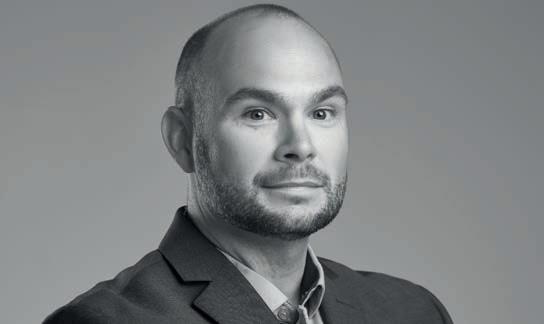


Even if the PII data is never revealed in the clean room or shared across parties, the BlueConic team advises that the shared audience output is still a product of matching unique customer IDs across parties - and Szabocsik highlights the fact that such practices raise questions like:
• Is shared audience activation directly from a data clean room just a data management platform by another name?
• Does it violate the intent of consumer privacy laws such as GDPR, CCPA and others that require explicit consent to target an individual based on their personal information?
• If you have consent to directly target the individuals that make up the shared audience, then why not just enrich the customer records in your first party data set and bypass the need for a data clean room altogether?
“A more privacy-compliant alternative is to use a model-based approach to activation. So for example, rather than directly targeting the shared audiences built in the clean room, brands and publishers could develop

rich lookalike models based on those shared audiences and then apply those models to their consented, first party data for targeted activation,” concludes Szabocsik.
CLEANING UP ON CLEAN ROOMS
Asking the tech industry at this precise point in time to detail its thoughts on data clean rooms appears to have been a very appropriate and pertinent discussion point. Not only do we have data marketplace specialists positively championing the use of this technology, we also have data-centric cloud players showcasing their data collaboration prowess. There is also an expansive universe of data management and data analytics vendors also making sure they have skin in the game.
We can expect the identity platform specialists to help further this discussion as we now lock down any cracks or fissures that might have developed in what is still version 1.0 of this technology’s total base of iteration. Data clean rooms are here and the cleaning staff are currently mop in hand - now, please wash your hands.
visit us ERP.TODAY 107
Data clean rooms are going to be so important in 2023. It’s the right way to handle other people’s information
ADAM JENNINGS DOUBLECLOUD
RATHER THAN A SEPARATE, ORGANIZATIONAL-WIDE CHALLENGE, ESG SHOULD BE BUILT INTO A DIGITAL STRATEGY
BY SOPHIE GRAHAM
LEVERAGING DIGITAL FOR ESG LEADERSHIP


visit us ERP.TODAY 109
Environmental, social and governance (ESG) measures have become undeniably mainstream when assessing business performance.
Aside from the moral imperative, the business case is clearer each year: this is about being fit for the future. Companies are facing unprecedented stakeholder interest with 90 percent of the world’s GDP now covered by net zero commitments; a tsunami of ESG-related regulation; soaring global energy prices; a talent war for human capital and increased consumer accountability.
Like digital transformation, this dynamic will create winners and losers. Across industries, winners will have something in common: effective use of technology to drive, measure and account for their ESG impact. Rather than a separate, organizational-wide challenge, ESG should be built into a digital strategy. Digital transformation is already having a significant impact on ESG in two important areas - data and disclosure, and resource efficiency.
Unprecedented demand for ESG disclosure
In recent years, ESG has shot up the agenda. A key driver is increasing awareness of the link to financial materiality. The release of the ‘Taskforce for Climate-related Financial Disclosures’ guidelines in 2017 by the Financial Stability Board sent a clear signal to the market: climate risk is investment risk. Evidence continues to show that organizations which consider ESG are more attractive companies to work for, with, and invest in. According to S&P Global Market Intelligence, during the pandemic, ESGfocused funds and companies outperformed peers, with factors such as better supplier management and employee engagement paying off.
New opportunities are emerging, especially around the energy transition. The largest reallocation of capital in history is needed to meet net zero, with an annual increase of $3.5tn towards low-emission assets, according to McKinsey Meanwhile, in Deloitte’s view, ESG-mandated assets will represent half of all assets under management by 2024 at the current growth rate. The interest is matched by consumers, with sustainability as a driver of consumer action and a powerful brand differentiator.
The rapid growth of ESG investing and
CLIMATE RISK IS INVESTMENT RISK
sustainability claims from companies has spawned a wave of ESG regulation, as legislators look to set common standards and reduce greenwashing. Much is focused on helping investors and financial market participants understand what is ‘green’ and what is not. This means driving consistency and comparability through mandatory reporting and audit, in a landscape that has been dominated by an ‘alphabet soup’ of overlapping voluntary standards. The incoming ‘European Sustainability Reporting Standards’ for example will introduce over 1,000 ESG data points to report and audit. The Securities and Exchange Commission (SEC) climate disclosure rule, a requirement from the SEC for companies to report climate risks to their operations when they file documents such as annual reports, aims to move climate reporting to the level of financial reporting.
Time is not on our side. The pace of change reflects the urgency of action on topics such as climate change, with standard practices developing in real time as companies grapple with the demand for ESG disclosure.

110 ERP TODAY | UK / EMEA | Q1 2023 | GUEST CONTRIBUTOR | ESG
Sophie Graham
From burden to opportunity
The good news is that ESG data is already starting to leverage digitalization. By nature, ESG sits across the entire business, and needs to bring together disparate data managed by different functions. The growing focus on value chain inclusion also means connecting to external sources, such as supplier sustainability data.




Once organizations understand what data they need and where this sits, they can connect and automate data collation and analysis, from existing sources like human capital management, centralizing disparate datasets. Moreover, they can also map against common ESG standards, frameworks and regulations and manage and analyze datasets to drive strategic decision-making.
One example of how this data can be used to drive a business’ ESG strategy is carbon footprint measurement. IFS hears from customers that emissions reporting is a top ESG priority. Track ing this not only meets reporting obligations, but also helps to prioritize energy reduction strate gies and save associated costs. That’s why our first step towards helping customers with ESG disclosures is through emissions calculation.
To do this, we are developing the IFS Cloud Emissions Tracker. It initially allows for Scope 1 and Scope 2 emissions calculations of a company’s carbon footprint, to help custom ers manage their climate impact. The primary differentiator is that our tool focuses on cus tomer data already in our cloud platform, making the data collection process simpler. Against a backdrop of complex ESG regulations, frame works and standards, this simplification will be key to effectively managing disclosure.
Lifecycle approach: efficient, effective use of resources is a ‘win win’

Another intersection of ESG and technology is around efficient use of resources. There’s an im perative to get smarter about how we use finite resources and raw materials, with both increas ing demand and decreasing availability and re liability of supply. The world’s energy needs are set to double by 2050. Carbon pricing is surg ing, with carbon trading seen as a one-way bet. Investors have begun trading in water futures, where demand already outstrips supply. Each year in Europe, €78bn of materials value is lost in the use of steel, plastics and aluminum. In creased competition and pricing of resources will drive out wasteful business models in favor of circular practices.
THE LANDSCAPE HAS BEEN DOMINATED BY AN ‘ALPHABET SOUP’ OF OVERLAPPING VOLUNTARY
Digital capabilities are crucial to this. Take Volvo Group Operations and Solutions, whose remanufacturing process, enabled by IFS, focuses on a circular economy through servicing, maintaining and repairing to increase the utilization rate of all materials. Servitization offers the potential to decouple growth from resource use. Changing the business model to one of service means long-term contracts, where the company is responsible for design, maintenance, outcome and efficiency for a decade or more. This changes the mindset from “take, make, waste” to one of sustainability, and incentivizes products which can be repaired and reused. This has an impact on the design, with service models enabling more expensive, longer-lasting designs. Ensuring such designs are commercially viable can also help to scale up adoption of innovative, sustainable technologies.
Rolls-Royce
from 2021, is a leader in servitization. In the 1990s, it made the revolutionary move from a manufacturer of equipment to a provider of long-term services, through a dollar-per-flying hour model. We play a vital role in realizing Rolls-Royce’s ‘Intelligent Engine’ vision, ena bling the ‘blue data thread’ of data connectivity between airlines and Rolls-Royce. This allows the business to improve the time between en gine overhauls by 45 percent and avoid the car bon associated with this process, having both a bottom line and ESG impact.
ESG leaders embrace digital to drive positive change

CHANGE
Technology is already transforming the sustain ability landscape, especially for data, disclosure and resource management. Companies can lev erage this by considering ESG as part of their digital transformation strategy. Effective use of technology is the only way to keep up with the pace of change, especially for data management and disclosures, where simplification and auto mation will be key.
The frontrunners will take it a step further to identify how their business model can evolve to be more sustainable through use of technology such as servitization and remanufacturing. Ulti mately, like all transformation, impactful change must be led from the top with close alignment to business priorities.
visit us ERP.TODAY 111
Sophie Graham is global sustainability (ESG) director, IFS

112 ERP TODAY | UK / EMEA | Q1 2023

visit us ERP.TODAY 113
Holger Mueller on how to ensure your sovereign cloud is safe from outside forces
ith enterprises moving to the cloud, legislation has caught up and now enterprises struggle with staying compliant. The trend has also given the rise to the term ‘Sovereign Cloud’ that crops up more and more in vendor marketing and offerings.
BY HOLGER MUELLER
Over in Europe, where there is a substantial percentage of cloud skeptics, privacy concerns used to rule; now, sovereign cloud is sometimes used as an argument that ‘the cloud is not ready’. That is a dangerous hold out position as competitionchanging adoption of IT only happens in the cloud. From lakehouses over IoT, to advanced machine learning, to the first artificial intelligence use cases, everything happens in the cloud. Moreover, SaaS vendors have either brought their offerings or are amid bringing their offerings to the cloud. So, the cloud is unavoidable, and we are nearing the stage where holding out will not only be detrimental to an enterprise’s success, but also coming close to affecting its wellbeing. When you hear the sovereign cloud argument to delay and/or challenge a move to the cloud, do not allow for that argument. In other words, do not bet against the cloud.

UNPACKING SOVEREIGN CLOUD
For a long time, legislation has stayed behind the cloud race, and only recently has it caught up and started to regulate cloud activities of enterprises. The key legislative pieces are Europe’s GDPR legislation from 2018 as well as the US CLOUD Act.
When looking at sovereignty in the cloud there are the following key aspects and variables:
Location. Obviously, location matters, as nations and combinations of nations (e.g. the EU) legislate where locations for certain workloads must reside. One obvious example is how government workloads need to stay inside their respective country.
Access control. The next is all about who has access to the system and the data. Can an enterprise control that 100 percent? The question to ask the cloud provider here is - can the workloads be set up in a way that the cloud provider has zero access and visibility?
Operators. When using third-party operators, the question is where do they reside, which passport(s) do they have, in order to understand potential pressure that can be used towards the operators who have access to the data, to get to the data from a foreign power.
Support. The same question needs to be posed to the same operators in regards to the personnel that are providing support. Where do these people reside, which passport(s) do they have and what access do they have? A cloud
NEFARIOUS GOVERNMENT AND NON-GOVERNMENT ACTORS ARE LIKELY TO TRY TO GET ACCESS TO SENSITIVE DATA VIA THE NETWORK
workload might be 100 percent sovereign requirements compatible, and as such fail in this regard.
Network security. Nefarious government and non-government actors are likely to try to get access to sensitive data via the network. Here the key aspect is how a cloud provider can separate the access; the capability to ask for in 2023 is the “air gap” between different network domains.
Code inspection. Even if all requirements above are met so far, an upgrade with malignant code/spyware may still leak the data to interested parties. Therefore enterprises need to question and ask for the cleanliness and safety of code used for their workloads. This area - the whole software supply chain control - is a nascent one in security and will get more attention in 2023.
Data storage. One of the key aspects of sovereign cloud is where the data is being stored exactly. Legislation has so far primarily focused on location. The challenges for enterprises that need to operate globally but must segregate their data are taxing ones.
Data processing. It is one thing in how data is being stored; it is another in how it is being processed. Legislation often leaves a hole when it comes to putting data into memory, as data
114 ERP TODAY | UK / EMEA | Q1 2023 | EXPERT OPINION | SOVEREIGN CLOUD
W
is not kept prolonged there. But technology has progressed in the memory stakes, and more data is kept for longer times in memory. Enterprises need to understand how and where data is processed, and may reside memory-wise in non-sovereign cloud compatible locations, leaving them open to potential data theft.
DON’T FORGET – INDUSTRIAL ESPIONAGE
The conversation around sovereign clouds typically only accounts for state actors. That comes as no surprise as states want to guard themselves against actions from other states - but the challenge for an enterprise is much more the not-so-ethical competitor who is going after data, intellectual property and trade secrets. When states support their enterprises in this effort, things can get bad quickly. So CxOs need to pay attention to the risk of data being subject to industrial espionage - and that is independent from the data being in the cloud - or on premise.
DON’T FORGET – SOCIAL ENGINEERING ET AL.
The most likely source of data breaches is through good old social engineering, where bad actors get access to systems using the credentials of (more or less) naïve employees. This is a risk to address both internally and with cloud vendors, as the best protection and compliance all fail when a social engineering approach breaches your data.
THE DIRTY SECRET
So far most large enterprises have operated out of either the US and the EU, making sure they are compliant with US and EU sovereign cloud requirementsand ignoring the rest of the world. The challenge for enterprises is that fragmenting data makes their cloud processing more expensive and at the same time reduces visibility and the ability for
YOU NEED A CHIEF DATA OFFICER. HAVE THE NEW ROLE TAKE CARE OF SOVEREIGN CLOUD COMPLIANCE OR CREATE AN ADDITIONAL WATCHDOG IN A CHIEF DATA PRIVACY OFFICER.
enterprises to take action on the data. Compliance with sovereign cloud requirements is effectively creating what I dub enterprise deceleration - something CxOs do not want in the era of enterprise acceleration being paramount for enterprise success.
A good example was the recent Schrems II judgment of the Court of Justice for the European Union that annihilated the EU-US Privacy Shield, but still allows standard contractual clauses (SCCs) between data exporters and importers. But these need to be vetted on a case-by-case basis. Did you update all SCCs with the new EU template by December 27th 2022, dear reader?
Also, as far as SaaS applications are concerned, the vendors pretty much punt the question to enterprises: decide if you want to deploy in either the US or the EU. Today’s SaaS architectures do not do well with disparate data sources, so for enterprises to keep global visibility and execution capabilities is a major challenge.
Here are my recommendations:
Understand your workloads. Understanding your workloads has always been important, but for sovereign cloud considerations it is critical. Some are more critical and need more attention; others are not. Categorize workloads into very critical, critical and non-critical.
You need a chief data officer. Legislation and court cases in this field move so fast, enterprises need someone who cares about data, so it is time to establish a chief data officer. Depending on the importance of data, have the new role take care of sovereign cloud compliance or create an additional watchdog with a chief data privacy officer.
Get the risk balance right. It is clear by now that achieving 100 percent compliance for enterprises is not possible. Not only is there an ongoing cost to compliance, but data fragmentation practically slows enterprises down. If the competition is not following the compliance, it may well get the upper hand. No state is going to bail out an enterprise that has gone under because of sovereign cloud compliance. Consider that potential fines might be painful, but a potentially necessary risk to incur.
Look for cloud vendors. The good news is that cloud vendors have woken up to the topic, providing more locations than ever in multiple key economies around the world, with a mixed set of operator, support and networking options to choose from.
THE TAKEAWAYS
Compliance is hard and expensive. The new extent of the regulation introduced by sovereign cloud requirements is that it may take a business out of business, as such. My local newspaper, The San Diego Union Tribune, decided not to be available inside of the EU, because of the burden of GDPR legislation. When a media company opts out from being global, leaving its subscribers stranded in certain regions, you can see that as the first warning regarding the cost of regulation.
For enterprises, it is all about striking the right balance between regulation and business agility, with an eye on the behavior of the competition. Staying and remaining competitive must be the foremost goal of all CxOs. In conclusion, when it comes to regulation, compliance and sovereign cloud, it’s time for a reality check to stay as ruler of your own world, and not end up a rube.
visit us ERP.TODAY 115
RIP ESG?
Reframing environmental, social and governance programs
As businesses of all sizes are once again reconsidering budgets in the light of tougher trading conditions and general uncertainty as to the future, there is a risk that boards and leaders will decide that there are more important things to invest in than an ESG program.
BY JACO VERMEULEN
This is forcing a moment of honesty within organizations as programs previously classified under the banner of ESG are being reassessed for what they are: strategies for operational efficiency.

The situation reminds me a great deal of previous attempts to position social media platforms as potential tools for the enterprise. There was great skepticism and reluctance to embrace ‘ Twitter -style messaging platforms’, especially amongst those industries with a strong history of manual processes that had faced enough of a challenge moving to computers in the first place. But once that discussion discarded the marketing speak and referred to the technology as simply ‘workflow tools’, the tone shifted and customers began to understand the potential benefits.
By removing the shiny wrapper, suppliers, be they vendors or integration partners, were

able to get at what really matters - the changes and improvements that the client can expect to realize.
Reframing ESG
The same is happening with ESG. By going beyond the hype and the greenwashing, an organization can reassess the changes that it might need to embrace. This review is through the more traditional lens of ‘if there is money to be saved, then investment will be made’, but it will be the same programs that are then embraced by business leadership.

This is not just a case of repackaging these programs - it is, rather, an important shift in emphasis. Rather than focusing on expectations of altruism and being led by external perception, the business can begin to undertake a program that looks at improving efficiency across the board, which all carry a substantial ESG dividend. In short, the dog wags the tail again.
There are, of course, many facets to this operational efficiency.
One of the most pressing for businesses is a reduction in energy use. This has an immediate impact on the bottom line and the strategies and technologies used in an energy reduction program are well established. And ‘energy’ itself is a nebulous term; it can cover electricity and gas at use in buildings or fuel in vehicles.

116 ERP TODAY | UK/EMEA | Q1 2023
Why it’s time for a dose of honesty around ESG and how it will be discussed and framed






also as equally applicable to HR as it is production. However, this does require sophisticated and comprehen sive data drawn from an array of sources spanning customer demands, production processes, the status of warehouses, logistics and supply chains, staffing capabilities and more. And the burden placed on analyzing this data to create
There are a pair of guiding principles that need to be em ployed. Firstly, data needs to be gathered from all sources, which necessitates not only the technology to collate and manage that information, but also the processes to make

Secondly, there needs to be assurances that the data collected is the ‘right’ data to inform both operational ef ficiency and ESG. This qualification may change - no or ganization can afford to rest on contemporary data. It must also have one eye on what is emergent as valuable, or what can be discovered and made available with new opera
The context for this moment of hon esty is unprecedented. Businesses are facing impacts such as Brexit, the postCOVID market, the supply chain impact of the war in Ukraine, increased fuel prices and the energy crisis. Inflation ary pressures and the potential loss of labor are also looming on the horizon.
In the face of this, operational effi ciency and the subsequent agility must be top of mind for business leaders. The good news is that during recent years, companies have set about col lecting and collating their data for ‘ESG reasons’, and this data is precisely what is needed to make a success of op erational efficiency programs. Indeed, it may have been the early dividends of this data, rather than regulatory compli ance, which has made ESG such a darling of the boardroom.
Looking to the future, businesses will have to get used to the demands of operational efficiency once again becom ing king. Operational savings will be diverted into further investment, but the overriding objective will be efficiency
This does not mean that ESG principles will be lost along the way. Far from it, in fact - just because metrics such as perfect order rates, first pass yield, changeover time or throughput do not explicitly state an ESG component, it does not mean that they lack an ESG benefit. But it is time for a dose of honesty around ESG and how it will be dis



118 ERP TODAY | UK / EMEA | Q1 2023 | GUEST CONTRIBUTOR | OPERATIONAL EFFICENCY
Until we get honest that ESG is a by-product, then these programs will remain at risk
THE BIRTH OF
HOW FUSION TEAMS SPEED UP BUSINESS TRANSFORMATION INITIATIVES AND REDUCE THE BARRIER BETWEEN IT AND THE REST OF THE BUSINESS.



































120 ERP TODAY | UK / EMEA | Q1 2023

There’s a variously told tale about the day Bill Gates met with IBM to discuss how Microsoft Windows would be licensed through the then-PC manufacturer. IBM failed to secure an exclusive licensing deal due to a number of bureaucratic holdbacks and a decision made by the well-pressed suits on its board at the time. History agrees that IBM made a mistake.

Business and technology futurist Peter Schwartz has used this story as part of his ‘what if’ style keynotes which he presents at conventions and conferences. To paraphrase his killer takeaway line, he ends with something along the lines of, “Now then, I’m not saying that IBM would have necessarily made a different decision if there had been at least ONE woman on that board…but, well, let me just leave that there for you.”
BEYOND DIVERSITY 1.0
But this discussion is not about diversity per se. It’s more about the way we are now looking to build software engineering teams with more than just a set of coders.
Beyond the engagement of so-called citizen developers and citizen data scientists – yes, we know no-code tools can empower businesspeople to use some abstracted tools that work on a drag-









and-drop basis – this is a story about fusion teams i.e. groups of individuals working to create enterprise software functionality.
Sometimes known as a blended team, analyst house defines a fusion team as a multidisciplinary group that is designed to blend technology and business expertise to improve the outcomes for both disciplines. On paper at least, these teams speed up business transformation initiatives and reduce the barrier between IT and the rest of the business. In practice, they may not always gel as perfectly as this perfect new world of
meritocracy might first suggest, so how do the mechanics play out?
LOST IN TRANSLATION
“Having your developers closer to the business can be both a blessing and a curse. As businesses get more and more specialized, the context of why we do what we do as developers or engineers becomes more and more important. This increased context means that the more steps between your engineers and your business, the more likely it is that critical information can be lost, in Jira [a project management issue tracking
122 ERP TODAY | UK / EMEA | Q1 2023 | EXPERT OPINION | TECH TALENT
ood teams are diverse. It’s a universal truth that we all accept and understand at every level. The challenge we now have is how do we define the measure of diversity that makes building the best teams possible and, further still, by what criteria do we measure diversity in the first place?
BY ADRIAN BRIDGWATER
ROB FARROW PROFUSION
HAVING YOUR DEVELOPERS CLOSER TO THE BUSINESS CAN BE BOTH A BLESSING AND A CURSE
tool] tickets, in human conversations, in Slack messages etc. It can all get lost in translation,” says Rob Farrow, head of engineering at data science company Profusion.
Farrow advises organizations looking to achieve blended team advantage to put their software engineers right next to the business problems in the first instance. Why take that direct move? Because he says, they may very well solve them - and if they don’t, then that initial proximity will almost inevitably serve as a compass reading for where to go next.
“But of course, putting even professional software engineers into the lion’s den like that had implications - as we know, with great power comes great responsibility. The business is then reliant on fewer people to make sure that the problem is not only solved, but also documented, audited and understood long term,” adds Farrow.
If Farrow’s approach is somewhat direct, developer-centric and only perhaps blended by virtue of the business-centricity it affords the software engineering function, should the scales be balanced more evenly - or at least just a bit more gently?
Jeroen Reizevoort, field CTO for EMEA region at MuleSoft points to his own firm’s research, which estimates that more than two-thirds of organizations have created or are in the process of rolling out fusion teams.
BLENDING DIFFERENT PERSONAS

“As organizations strive to become more agile, many are building composable enterprises using API-led integration,” says Reizevoort. “Fusion teams will be responsible for the complete lifecycle of the digital building blocks that are at the foundation of this revolution. These digital building blocks come in all shapes and sizes (APIs, events, bots etc.) and are created by different personas using different technologies and tools. The challenge many organizations face in enabling fusion teams is to build integrated user experiences with reusable building blocks,
but doing so in a way that mitigates security and governance risks.”
With a keen eye on system health, Reizevoort and team highlight the need for having the tools in place that allow IT to monitor the integrations and applications created by fusion teams. This, he says, can help organizations mitigate security and compliance concerns. In a world where fusion mechanics are created by (as he puts it) “different personas” and where some of those personas are now actually machines (smart IoT devices, virtual compute machines and more), the need for higher level system control is perhaps reasonably justified.
In the future, such capabilities will ensure business and IT operate more cohesively, with fusion teams compris-
ing members from both sides. All is well and good in theory so far then, but are organizations actually engaging in this fusion process to the degree that they can tell us what kinds of experiences they have had?
Multi-currency Fintech company, Conotoxia, has set its sights on a fusion teams operating model that, in its view, should be implemented in all high-tech companies seeking growth and competitive advantage. The company insists that it doesn’t even talk about cooperation between its separate departments, but rather, it works with an aim of uniting them.
“In practice, this business model may mean, among other things, that a company does not create different IT and
visit us ERP.TODAY 123
business units. Instead, product departments may be created, consisting of, for instance, product creation specialists, developers, UX designers, business analysts and anyone else who can bring success to a task, from the idea to the implementation of the product and delivering it to the target audience,” enthuses Andrzej Arendt, chief product officer at Conotoxia.
Arendt says that this type of collaboration eliminates situations where, for example, one team in-house creates a product and then turns to another team with guidelines for completing the task.
“In our organization, IT is not a separate island accepting and executing orders according to strictly defined needs and criteria. Instead, it is a model in which all specialists, at various stages of
the process, understand what they are doing and why they are doing it, and are involved in the idea as well as development of the product from the very start,” he adds.
A SEMANTIC EVOLUTION OF AGILE
But before we get carried away with this whole idea, let’s stop and question whether this is truly transformative, or perhaps just a form of new-age workplace workflow reinvention being spin doctored by some human resources bright spark.
Steve Wilcockson, data science lead for time-series database and analytics company KX, certainly isn’t convinced. He says that the term ‘fusion teams’ is not arising in any conversations with
his organization’s customers. His view is that this is simply a “semantic evolution” of the agile/lean approach to multi-disciplinary software application development teams.
“That being said, we agree with the fundamentals behind the term’s meaning. We absolutely see business stakeholders now working to drive or respond to developments and fully engage in software development cycles; for example, stakeholders outlining requirements of and testing predictive dashboards built by the data scientist leveraging data coordinated by the data engineer,” says Wilcockson.
Interestingly, the KX team says that it’s increasingly seeing ‘three-pack-hunt’ techniques and behavior playing out at tech industry conferences, with three visitors from the same company visiting the firm’s booth.
“One will drive change, for example, an engineering or product manager or perhaps a procurement buyer; a second will be an analyst or data scientist either in-house or contracted; and the third is the software developer or engineer who drives and leads the sustaining infrastructure,” clarifies Wilcockson.


Whether or not fusion teams are a sustainable workable concept for the long term remains to be seen. Certainly, there is a strong whiff of DevOps, a definite resonance with open source systems of meritocracy designed to break down monolithic bastions of hierarchy, and more than an occasional nod to Agile methodologies that we have known for several decades now.
Whatever name we give them, and however we agree that they have come to the fore, the presence of more equitable, increasingly mixed, and variously differentiated team structures should allow us to champion and facilitate wider diversity initiatives at all levels - and that can only be a good thing.
Does anybody want to buy a worldwide Windows licensing contract?
124 ERP TODAY | UK / EMEA | Q1 2023
IN OUR ORGANIZATION, IT IS NOT A SEPARATE ISLAND
| EXPERT OPINION | TECH TALENT
ANDRZEJ ARENDT CONOTOXIA
FUSION TEAMS WILL BE RESPONSIBLE FOR THE COMPLETE LIFECYCLE OF THE DIGITAL BUILDING BLOCKS [BEHIND THE] REVOLUTION
JEROEN REIZEVOORT MULESOFT

The ERP Today Young Professionals Awards
ERP TODAY is proud to recognise the talent and efforts of young professionals who will be creating the future of enterprise technology
We’re thrilled to be hosting an awards ceremony dedicated to celebrating exceptional under 30s in the enterprise tech sector, alongside the companies and mentors who are invested in their development. There is no cost to nominate a young professional, mentor or company and tickets for the event will be available by invitation only once the shortlisting process is complete.
NOMINATIONS OPEN SOON

Future Leader Award



Bright Spark Award
Sales & Marketing Hero Award

Techie Power Award

Young Consultant of the Year
Team Player Award
Mentor of the Year
YPN Employer of the Year

Today




award categories ypnawards.com The ERP
Young Professionals Awards
Reputation on the line? Tech redundancies
128 ERP TODAY | UK / EMEA | Q1 2023
and jostling for future business
BY MARC AMBASNA-JONES
These are the kinds of hard choices we have made throughout our 47-year history to remain a consequential company in this industry that is unforgiving to anyone who doesn’t adapt to platform shifts,” wrote Satya Nadella, Microsoft’s CEO in a recent blog explaining why the company was cutting around 10,000 jobs in the coming months. Microsoft, which claims that 2022 was a record year financially, is one of many tech firms that have committed to redundancies. Some are more eye-catching than others. For example, fast-growing payments firm Stripe announced at the end of last year that it was cutting 14 percent of its workforce, blaming overhiring. Salesforce , the poster child for the SaaS industry, is cutting around 10 percent of its employees, with CEO Marc Benioff claiming, “as our revenue accelerated through the pandemic, we hired too many people leading into this economic downturn we’re now facing, and I take responsibility for that.”
The numbers are stacking up, but as tech redundancy tracking site Layoffs.fyi shows, this is not just about the Big Tech players. The site claims that already this year, 122 tech businesses have laid off over 37,000 employees. While over-hiring during the pandemic may be one reason for cutting headcount, the breadth of the layoffs suggests something more seismic.

Redundancies
Amazon, Salesforce, Meta, Alphabet, Twitter, Stripe and now Microsoft - the list of axed technology workers is growing. While restructuring is not new, do big redundancies have an adverse effect on customers?
RICHARD SPEIGAL N BROWN GROUP visit us ERP.TODAY 129
dent my confidence
Maybe Nadella is right to say that this is more about a platform shift, perhaps with tech firms predetermining the challenges around AI and automation and using economic uncertainty as an additional reason to shed staff. We’ve seen it before. After the dot-com boom and bust in the early noughties and the banking meltdown in 2008, technology trends, such as cloud computing, business process management and virtualization were shaping the industry and creating new opportunities for growth.
As Jaco Vermeulen, CTO at tech consultancy BML Digital suggests, hiring and firing can be “competition tactics”, adding that “the Big Tech firms are actually more rightsizing than responding to macro-economic shifts, and this is linked to innovation projects and products not progressing”. Vermeulen adds that this is also “a reaction to stimulate profitability and share figures” and that by the end of 2023 “you will see this cycle complete”.

Redundancies and rep
While some see redundancies as a short-term solution to balance the books, others will see it as a long-term opportunity to consolidate and pivot. It feels like a leveling-of-the-playing-field moment, where companies are jostling for positions to take advantage of new technology trends. These are usually moments in tech history where new entrants emerge, or even new leaders.
Despite the redundancies, this is not an industry in recession. Gartner is forecasting a 2.4 percent increase in IT spending this year, to $4.5tn (down from a previous forecast of 5.1 percent but still in the plus column), with distinguished VP analyst John-David Lovelock claiming that “enterprises continue to increase spending on digital business initiatives despite the world economic slowdown”.
On the surface at least, the redundancies can paint an alternative picture, one where headline redundancy figures can impact brand perceptions.
“Redundancies can signal de-investment and a likely slowdown in feature releases, which ultimately influences our procurement decisions,” says Richard Speigal, head of data visualization at N Brown Group, an online retail business managing brands such as Simply Be and Jacomo. “If we’re already using this software, will competitors overtake
it and force us into a re-tooling decision later?”
Speigal adds that Salesforce’s recent redundancy round has “certainly shaken Tableau’s place on our list of potential strategic BI tools,” pointing to the likes of Qlik and ThoughtSpot as alternative contenders.
“We invest heavily in using this type of software, not least in recruiting and training people to use it, so I can’t fail to factor in feature trajectory as part of our decision,” adds Speigal. “Redundancies dent my confidence.”
Speigal is not alone in his reaction to sweeping tech redundancies. There is a reputational issue here, certainly if redundancies are mishandled or in large quantities. As recruitment firm LLH Recruitment Solutions writes, “significant damage can be done to a company’s reputation, including far-reaching consequences such as harm to the organizational culture and investor confidence”.
Lloyd Davey, a partner at the employment law firm Stevens & Bolton recently said, “Businesses should think about the long-term risks to their reputation of a rushed or flawed redundancy process. This is particularly the case for any business in the public eye as redundancy processes can significantly damage a brand and reduce customer engagement and loyalty.”
There is some truth here. Regardless of the reasons, these redundancies unsettle the market and could certainly influence buying decisions and even investment. In fast growing areas such as business intelligence tools where there is increasing competition, this could be a factor in longer-term buying decisions.
Small brands, big talent
However, there is a flip side to all of this. At a time when tech skills are in short supply, the market is being flooded with people with Big Tech experience. One company’s loss can be another’s gain.
“2023 will be a prime opportunity for smaller companies to snap up some of the best tech talent,” says Mark Chaffey, co-founder and CEO of technology recruitment firm hackajob. The company claims to have seen a recent 38 percent increase in candidates joining the platform from Big Tech businesses.
“It’s an amazing opportunity for smaller businesses - across retail, education, banking, fashion - to snap up some of the best talent in the UK,”
130 ERP TODAY | UK / EMEA | Q1 2023 | EXPERT OPINION |
It’s an amazing chance for SMEs to snap up some of the UK’s best talent
WORKFORCE
MARK CHAFFEY / HACKAJOB
adds Chaffey. “In previous years, there was no way these companies could compete - but 2023 marks a new era of tech recruitment.”
As Speigal hints, the upheavals we are seeing in tech employment can have a knock-on effect. While it may shake confidence in product updates and support, would it force a complete change of direction towards new entrants and disruptors?
“Rarely,” says Speigal. “If it’s for anything more than a Miro board, enterprise procurement is a long process. We need reliability, scale and genuine ease of integration with partners we trust. We’ve all been burned by hasty decisions to buy the latest cool thing and I’m happy to let others jump first.”
That’s the challenge for any enterprise software business looking to break into new sites. Reputation and trust are important and take time to build, something which new entrants struggle with by their very nature. But, as we know, reputation can also be harmed quickly.
As Speigal says, it comes down to “productivity” and whether or not a tool can make things go faster and people work better. But if businesses start shedding people and making noises that they are worried about the economy and how they are going to handle it, it’s not a good look. As Gartner’s numbers suggest, this is not a market in retreat. Businesses are looking for help, positive support and ideas about how to manage their own economic challenges.
All change in 2023
Certainly, there is concern among CEOs that they are not up to speed when it comes to technology and skills. As PwC’s global CEO survey of 4,410 CEOs recently found, there is widespread concern about the long-term viability of their organizations. Almost a quarter of UK CEOs believe their business will not be economically viable within 10 years, if they do not make significant interventions to change course.
“Businesses have already undergone massive change this decade, with hybrid working and cloud computing among the big shifts. But this is the tip of the iceberg - many CEOs believe their current business models are unsustainable and this means more change ahead,” says Kevin Ellis, chairman and senior partner, PwC UK.

In the UK alone, 40 percent of CEOs believe their company’s tech capabilities lag behind the demands of their strategic objectives. According to Ellis, this is going to trigger “fundamental changes” this year with “big investment in people, skills and technology”.
That should be an incentive, particularly for enterprise technology vendors. IDC claims that enterprise applications sales will have a five-year compound annual growth rate of eight percent through to 2026, supporting businesses with their objectives.
So, how does this fit with the image of tech redundancies? Out of all the major announcements, Nadella’s is the most intriguing. The recognition of how technology is evolving quickly, specifically in the cloud, through automation and even in the potential of the metaverse, can be seen in Microsoft’s Gartner report of top strategic tech trends for 2023. But it’s a balancing act. This year is not expected to see huge shifts in the sorts of technologies businesses want to buy. Digital transformations are expected to continue across all sectors - but customers are making different demands. They want outcomes delivered through ecosystems of partners. These changing relationships with customers are going to impact how vendors deliver products and services and the sorts of skills they will require to make it happen. Reputation counts.
As CompTIA warns in its IT Industry Outlook 2023, “In the year ahead, the expanding vendor landscape is going to prod both new and established players to up their game to stand out among the rest. Greater choice and the ubiquity of technology will also have an impact on established business practices across the digital economy.”
This has a knock-on effect, regardless of economic outlook. Redundancies to trim staff for short-term economic gain is one thing. To make redundancies citing industry change is another. As recruitment firm Hays suggested recently, recruitment in tech is as strong as ever, but demand for certain roles is changing. Skills gaps are not a thing of the past but how tech firms manage recruitment this year is critical. Not just to fuel change and realize opportunities but to also improve reputations. After all, shedding employees is never a good look, no matter how you spin it.
visit us ERP.TODAY 131
Many CEOs believe their current business models are unsustainable
KEVIN ELLIS / PWC






HOW FLEXIBLE WORKING MAKES FOR AN ESG

WONDERLAND



Putting people rst in sustainability
BY TANIA GARRETT
When we talk about ESG, most of the discussion is around the ‘E’ - but let’s talk about the ‘S’ and ‘G’ as they are equally important. In my experience, the people and governance aspects of ESG can have a direct impact on improving a company’s ability to fulfill its sustainability goals.

In the world of HR, a particular topic has become quite symbolic of how well a company is delivering against one of its key ESG goals, namely flexible working. This way of work is now an integral part of the HR policies of many organizations, not just because it allows employees to better balance home and work life, but because it opens up opportunities to create a workforce that is not just a reflection of the ‘local’ market but of a much wider and diverse com-

munity. By allowing remote and virtual working, people who need the support of families or friends for care provision can live closer to their support network. For those who have chosen to live outside of cities for cost, lifestyle or health reasons are no longer subject to long commutes or, worse, being excluded from hiring pools.
As such, a company’s approach to flexible working should be seen as integral to its diversity strategy and how it delivers against its ESG goals. My concern is that not every organization has embraced the importance of flexibility, not just as a way to keep employees happy, but to both achieve ESG goals and improve the overall organizational performance. In our annual Business Future Index there was a clear emphasis on flexible working: 92 percent said their organizations have now adopted some form of flexible working policy, but 76 percent said flexible working policies need improvement while 62 percent agreed the tools to support flexible working are not adequate.
The warning in the survey is that 39 percent of organizations said people left their businesses for more flexibility elsewhere over the past year. So if a company’s vision is to be more inclusive and to draw talent from all communities, it is critical that the approach to flexible working is done right. The benefits are very clear: in the Business Future Index organizations that outperformed their business targets for 2021 were more likely to be further ahead in planning changes to their diversity policies compared with organizations that had performed less well.
Off with their head(quarter)s
The improvement in meeting sustainability and ESG goals suggests that the acceleration of digitalization and flexible working has had a positive impact on sustainability. That makes sense in the context of the pandemic. Widespread adoption of remote working, less permanent office space, fewer geographical limitations affecting workforce diversity, less business travel and a greater reliance on data for business decision-making can all contribute to meeting sustainability goals.
However, it is not just flexible working that plays an important role in judging the impact and success of a company’s ESG strategy. Our survey identified other key ‘people-focused’ measures where organizations can make improvements. Respondents said the top challenges to attract and retain talent were the difficulty of attracting a diverse range of talent (36 percent) and being perceived
to have poor ESG credentials (20 percent), while only 25 percent are planning to improve diversity within the business. The fact that more than a third of those surveyed say they face challenges with recruiting and retaining diverse staff across multiple categories, and that three-quarters of companies have no plans in place to improve diversity, makes for troubling conclusions.
The bottom line is that a company’s ESG strategy and its commitment to delivering on it, particularly around people-focused measures, will have a fundamental impact on business success. At Unit4, this has been a priority even before the pandemic, given our foundation is a people-centric one. The pandemic did accelerate our focus bringing this vision to life, but we already had a number of initiatives in place, including the adoption of a ‘headquarterless’ model, so that the senior leadership team could move around our global organization, connect with staff locally and be accessible. We adopted unlimited paid time off plus a flexible working policy for all employees. This has also enabled us to expand where we are able to find talent, creating virtual teams and centers of excellence around the world in places afar as Lisbon and Jakarta.
Investing in people, particularly providing them with greater flexibility in how they work for an organization, has real benefits. In the Index, flexibility led to greater team collaboration and staff being more productive, as well as providing greater work/life balance. If employees are happy and engaged working remotely it will also have the added benefit of reducing reliance on office space and commuting, helping to lower an organization’s carbon footprint.
Of course, such initiatives must be implemented in a coherent, strategic manner underpinned by clear policies so there is no confusion about the expectations of employees. They also require access to the right tools to enable flexible working and collaboration between virtual teams. These tools will keep teams engaged through on-line engagement surveys, learning modules and performance management.
Ultimately, articulating a people-centric vision through initiatives such as flexible working will underline an organization’s cultural commitment to change and deliver on sustainability goals. This will lead to a happier, more diverse and committed workforce, which will help to improve the organization’s performance.

134 ERP TODAY | UK / EMEA | Q1 2023 | GUEST CONTRIBUTOR | SOCIAL GOVERNANCE
Tania Garrett is CPO, Unit4
Adopting a peoplecentric vision will lead to a happier, more diverse and committed workforce.


































































We build better organisations by empowering people at work to be their best www.agilyxgroup.com The only ERP solution that gives you a 360-degree view of your operations with all the tools you need to run your business with ease and efficiency.
Four independent vendor channels dedicated to Oracle, SAP,



Servicenow and UiPath are now live on ERP.Today
Each channel contains daily news, analysis and articles covering the key topics from each vendor with guest contributors and industry experts sharing their views and opinions.












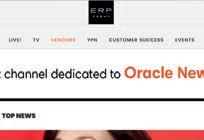

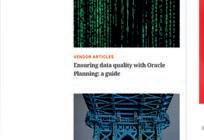
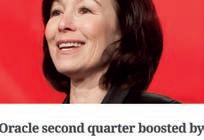






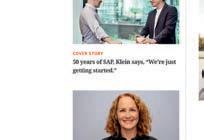





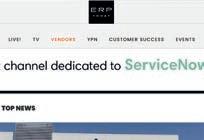

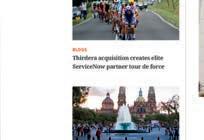
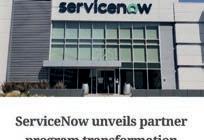
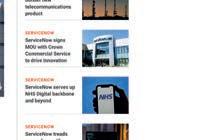



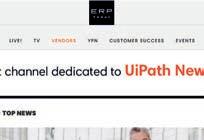


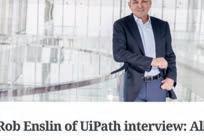



SUBSCRIBE FOR FREE WWW.ERP.TODAY
up to date with financial results, product updates and acquisitions plus regular exclusive Live! interviews with key executives at each vendor.
Stay
UP IN THE





























will it be the macro environment that redefines



We’re well into a new year, but one thing remains very much the same for
businesses in 2023: they need to change.
Let me be clear: that’s not because they’ve done anything wrong.
Rather, businesses are under immense pressure, and we’re all feeling that. What are you supposed to do as your gas bill doubles overnight, for example?
onto cash flow, because in this environment, no one wants to invest.
The thing is, holding onto cash right now doesn’t benefit anyone. 2023 is shift or die territory: we need to act, not stand still, and we need to act boldly. The status quo is not sustainable, and your business will be totally redefined by macroeconomic conditions - if you let it.
BY JESSICA CONSTANTINIDIS
Despite the pressure, driving the change required is an overwhelming prospect and many businesses are unsure about where and how exactly they’re supposed to transform. As a result, we’re seeing companies holding
What I mean by that is there’s clear opportunity for you to be the author of your business’ future, rather than just a victim of circumstance. But it requires you to pivot.

ing prospect and many businesses are If I were to summarize exactly what








If I were to summarize exactly what businesses need to be doing right now, it’s find value and amplify it.
It’s all about focusing on the essen-





Q1 2023
| UK/EMEA |
THE AIR






























your business this year - or you?
tials, economies of scale and doing more with less; identifying gaps in the market, challenging the norm and getting more bang for your buck. Those that take the time to identify their core business strength, work out how to do more of it, and let go of the rest will ultimately win out, even in challenging times.
So let me explain how to do just that.
Seek out the value-add
We all read the business press and see that in uncertain macroeconomic times, it’s the out-of-the-box thinkers who really thrive. But their secret isn’t really a secret. When margins are tight, they streamline, and they innovate. Every organization can do this, but it requires a
RATHER
proper, honest assessment of your business: what do we need? What don’t we need? What are we missing? Where is our true unique value?
YOUR






THERE’S CLEAR OPPORTUNITY FOR YOU TO BE THE AUTHOR OF YOUR BUSINESS’ FUTURE, RATHER THAN JUST A


plant: it needs cleansing, storing and it needs to be made available 24/7 for reporting. But are all of these measurable criteria necessary and do they add any value? We need to think critically about what we measure, how we do it, and where we put it.
for the sake of it rather than necessarily
For many businesses, honest assessment isn’t as easy as it sounds. The sheer amount of data flowing around in businesses is extensive, often collected for the sake of it rather than necessarily doing anything with it.
Take manufacturing. There’s endless data stemming from your average
Imagine you have a good that needs to be kept at a stable temperature, for example. Keeping track of the temperature at all times creates a lot of data, but it doesn’t actually tell you anything. All

to be kept at a stable temperature, for

VICTIM OF CIRCUMSTANCE
ERP.TODAY
you really need to know is when the temperature exceeds or goes below maximum and minimum. That’s the key essential ‘trigger’.
Starting to identify what is and what is not essential will make a big difference in your business. But you also need to ensure it’s then stored properly so it can actually be used and compared. It’s no use keeping it in well organized but ultimately useless piles, files or siloes.
Reassuringly, you don’t need to rebuild all of your systems and business architecture. What you need is a tool that brings everything together, commonly a single data layer that will push and pull to all the relevant sources and tools you already have.
If you get these steps right across your business, you’ve successfully found your value. Now, you just need to amplify it.
Proposing value at scale

What is amplifying value, you might ask?
Put simply: taking calculated risks about which revenue streams will deliver returns and prioritizing the resources that will ensure these thrive. It’s all well and good knowing what’s going on in your business, but that’s just the founda-
tion to actually improving it. Amplifying value is putting the right data to work.
The good news is, having reliable data that’s easily accessible and all in one place is a goldmine for technologies like automation and AI, which can take this data and turn it into real value, be it clear insights, smarter workflows or even predictions.
This automation layer is where businesses can really drive savings: first of all, it may reveal insights into current operations or strategies you may not have considered before. Secondly, if machines are doing these calculations and joining up the dots, the people we use to sift through data manually now can do something else far more valuable. Finally, these speed and efficiency savings also allow you to be far more agile and quickly spin up or wind down your activities, depending on your needs, drastically reducing your time-to-market. That’s four benefits in one for businesses: better intelligence, saved time, saved costs and more agility.
What we’re doing is enhancing human capability to interpret large sets of data in a different way. Humans still play a vital role in training, improving
and sense-checking - as well as validating the data AI provides to secure new insights.
What this looks like in reality
I’ll give you an example of what this could all look like for a business.
Imagine you’re running an airport dealing with massive queues at customs… which is leading to missed flights and many complaints.
Sounds bad. But on the plus side, you have plentiful data at your fingertips: you know who is in the airport terminal and roughly where they are; you can measure the lines at customs and the average waiting time; you know the capacity of all the flights on offer and which flights are missed.



If you join this data together - and then automate it - you can start to trigger solutions: alerts when queues are too long and passengers are missing flights, alerts to the necessary teams to create more capacity, and you could even communicate directly with passengers to keep them informed about the situation and apologize for any delaysall without human intervention.
We’re already seeing this in action at scale in real life - from Manchester Airport Group to BT Group - and there are potential similar use cases in every industry imaginable.
What this example shows is: the piles of data your business already has are just two steps away from becoming functioning workflows and businesscritical insights that will cut costs and unlock capacity in your workforce.
What you choose to do with those benefits - well, that’s up to you.
Break it down
Once you have the data, it’s connectable and can provide the insight you need to pivot and create true value that can carry you through this crisis and into future growth.
The question remains: are you going to hope this little crisis just passes you by, or are you going to get the data insight that defines your value and be bold enough to pivot your business for future success?
Jessica Constantinidis is field innovation officer EMEA, ServiceNow
UK / EMEA | EXPERT OPINION | ECONOMICS
THE PILES OF DATA YOUR BUSINESS ALREADY HAS ARE JUST TWO STEPS AWAY FROM BECOMING FUNCTIONING WORKFLOWS AND BUSINESS-CRITICAL INSIGHTS
| | Q1 2023
HOLDING ONTO CASH RIGHT NOW DOESN’T BENEFIT ANYONE. 2023 IS SHIFT OR DIE TERRITORY

















Where the biggest names in enterprise tech tell you what they really think, Live!

Live!
erp.today/live Candid conversation. Compelling content. Live!
Workday Rising Europe 2022
 BY STEPHANIE BALL
BY STEPHANIE BALL
This year’s Workday Rising Europe brought ERP Today to chilly Stockholm with a warm välkommen.
Home to the HR software of most of the world’s largest companies, including more than 40 percent of the FTSE100 and DAX40, and over 30 percent of the CAC40, Rising Europe was bound to reel in an impressive crowd. With everyone from Jimmy Choo and Just Eat to ABBA’s very own Björn Ulvaeus in attendance - the beardy one - it certainly didn’t disappoint.
Keynotes kicked off on a high, as

Workday celebrated 2000 EMEA customer wins and an expansion of the first wave of its key accelerator program in EMEA.

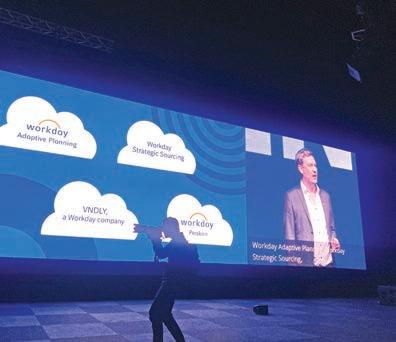

Workday is renowned for its customer-centric approach and, perhaps expectantly for a HR software provider, placing employees first. But what really shone through was the 97 percent customer satisfaction rating. When asked to raise a phone torch if identifying as a happy Workday user, the keynote theater audience - several thousand strong - lit up like a concert hall.
A peak at Peakon and Workday treats. New announcements around Peakon, a Workday company aiding amplification of the employee voice with employee surveys, certainly went down well with tool-hungry attendees. Chatting aside with several Workday customers, it was described as something of an extra tempting treat jar on the list of new Workday tools to try. Enabling confidential two-way conversations, Peakon will hand a smörgåsbord of data on a plate to managers wanting to check in with their teams and rapidly address concerns.
| PHOTODIARY |
STOCKHOLM
144 ERP TODAY | UK / EMEA | Q1 2023
A glimpse behind the scenes. A busload of journalists and analysts were present at Rising, with media dinners, gatherings and traditional Swedish fish dishes aplenty.
In a media-only c-suite panel, Workday chiefs shared their plans for the coming years. Having already won a hefty share of the biggest enterprises, new specific industry accelerators were announced by Pete Schlampp, chief strategy officer at Workday, who mentioned banking, capital markets and insurance organizations in the UK as key expansion areas.
A new focus for the previously VIPonly vendor was also announced, as deal-hungry hands will be extended to win over increasing numbers of SMEs. Currently reaping 30 percent of its revenue from overseas, Workday chiefs hope that further EMEA growth can aid in bringing in a target $10bn revenue by 2025.
Elsewhere at Rising, Workday was, unsurprisingly, rather protective of its A-list crowd. After a strict set of bookings were locked in place, we were eventually granted a chance to talk to some very select customers using the



software, namely Puma, Designit and PZ Cussons.
Rising Europe revealed once again that Workday is leading the way with HR innovations. But old Stella Artois advert references aside - one client cheekily described Workday to us as “reassuringly expensive” - in a world where software implementations can go wrong more than right, something about a hefty price tag and a VIP customer list remains a great selling point. What remains unknown is how Workday plans to change this lofty reputation to target SMEs.
visit us ERP.TODAY 145
ERP Today YPN Social
BY GRACE BARRINGTON
It’s a hugely exciting year ahead for ERP Today’s Young Professionals Network (YPN), the only independent network for young professionals in enterprise technology. Last year, we spent time in close relationship with a council of rising tech stars to find out what under 35s need in order to thrive better in the sector. Hence, this year, expect quarterly events, young voices being regularly platformed on ERP Today and, most excitingly, the Young Professionals Awards.
After our first YPN social last No -
vember, ERP Today felt affirmed by the need for - and value of - the network. Together, young professionals spoke about the impact of COVID-19 on their career experiences, as many had spent years stuck behind Zoom calls and had never experienced working full-time in a busy office. Themes of isolation came up often, and the excellent turnout confirmed the appetite for a network of this kind, as attendees had traveled from across London, Rugby, Reading, Oxford and further afield. As one young professional commented: “[It was]
an excellent event… Really positive to meet other like minded professionals in a relaxed setting.”





From the social, it became clear that the network needs to be both an opportunity for this generation to build a stronger community in enterprise tech whilst also being a significant resource which gives YPs access to career advice and support. ERP Today has worked hard to select speakers who will set our young professionals’ sights as high as they can go. Our first event of the year is taking place in London, on Thursday

| PHOTODIARY |
LONDON
146 ERP TODAY | UK / EMEA | Q1 2023
13th April, where we’ll be joined by the brilliant Lindsey Rowe, head of purpose programmes and sustainability at SAP. We’ll be announcing more throughout the year, and we have some incredible speakers lined up, so watch this space.
Most of all, we’re incredibly excited for our Young Professionals Awards, a first-of-its-kind awards ceremony dedicated to celebrating exceptional new stars in enterprise technology, alongside the companies and mentors who nurture their talent. Taking place on 23rd November
at The Cutty Sark, London, we’ll be recognizing the best and brightest young professionals across eight different categories. Nominations open on 1st May, so spread the word now!



We’re furthermore thrilled to announce that these events will be led by our YPN 2023 co-chairs, Adam Stewart ( Microsoft) and Yassy Shayesteh ( Accenture), who are both winners of ERP Today’s Young Professional of the Year Award 2022 and 2021 respectively. They’ll be working together to refine the network into its
best possible version: interviewing senior execs about what YPs should be doing to further their careers; setting up buddy systems; and working with the YPN council to create as many opportunities as possible for the network and its sign-ups.


If you would like to hear more about future events, please sign-up for the YPN at erp.today, and we’ll be in touch with information about how to get involved. This is going to be a very significant year for young professionals in enterprise tech - and we’re only just getting started.

visit us ERP.TODAY 147
NEXT ISSUE LAKEHOUSES DIGITAL TWINS EVOLVING AI HOW TO BOX IN YOUR BIG DATA?

www.erp.today
THE MAGAZINE FOR ENTERPRISE APPLICATIONS AND ASSOCIATED TECHNOLOGIES



UKISUG Connect 2022
BY STEPHANIE BALL
Birmingham was aglow with Christmas market festivities as I navigated the city to reach the ICC for UKISUG Connect 2022. Ushered into the darkened keynotes hall, smoke machines pumped atmosphere around glowing UKISUG ‘lettering’ and a crowd was settling. Marking SAP’s 50th birthday, this year was set to be a packed-out show and tell.
Hosted by the UK and Ireland
SAP user group, UKISUG Connect tends to bring a refreshing take on an industry often overly glitzed with marketing speel.
Kicking off talks were UKISUG chairman Paul Cooper and chief executive Craig Dale, announcing the results from the UK and Ireland SAP user survey. Perhaps predictably, UKISUG seemed undecided whether SAP had been naughty or nice, bringing a mixed bag of feedback for the vendor.


User survey spells mixed news for SAP. In an aside, Paul Cooper praised the SAP UKI MD’s work, but gave SAP HQ an improvement-lacking B+, making it clear that the vendor still has work to do for its UK and Ireland
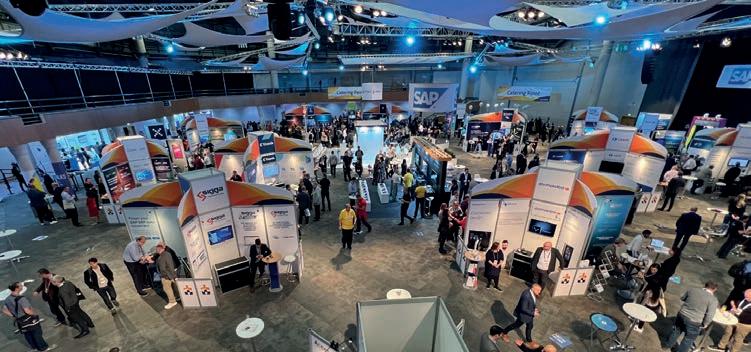

users. With business case reasons for S/4HANA lagging behind the ECC 6.0 maintenance deadline, he marked 2023 as a line in the sand on whether enough time is remaining.

The good news for SAP is that more organizations (89 percent) are using or planning to use S/4HANA. Of this figure, almost three-quarters plan to shift to S/4HANA before the ECC 6.0 deadline – surely a relief for SAP chiefs after pushing back the deadline by two years due to lack of uptake.
The bad news is that a third of respondents said S/4HANA migrations
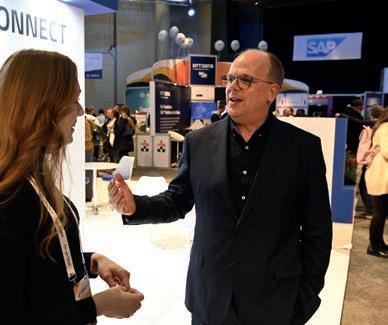
| PHOTODIARY |
BIRMINGHAM
150 ERP TODAY | UK / EMEA | Q1 2023
needed more change management than expected. 92 percent were concerned a lack of available skills will slow their migration. Additionally, a third rated partner’s training and technical resources as poor or very poor.
Unabashed, then SAP UKI MD Michiel Verhoeven took to the stage with a welcome open mind, and highlighted S/4HANA’s growing momentum and the dedicated upskilling programs for support. He later told ERP Today that 2022 saw SAP win 600 new UK customers, with upgrading existing customers and welcoming new partners for the small-medium
change management space being a main push for 2023.

A changing UKI customer approach? Exploring the exhibition stands and talks, ESG was a big theme, in line with the survey revealing 70 percent were confident in SAP ESG support. SAP’s Lindsay Rowe, UKI head of purpose programmes and sustainability, led ESG technology talks. SAP Business Technology Platform experts were also available after the recent no-code announcement.
Talking with SAP customer Tra-

vis Perkins illustrated how big tech implementations are changing to a piecemeal approach. Out with rip and replace and in with gradual, bitty transformations, the easiest wins are being picked off with smaller solutions around older core systems. An approach that perhaps cements another dilemma for big tech vendors around the corner.
As a final signoff from a conference day-tripper, I’m putting in a polite request that evening drag karaoke performances are compulsory for Connect 2023 attendees. That, and take-home birthday cake.


visit us ERP.TODAY 151
SIGNING OFF
SMALL STEPS TOWARDS BIG SUSTAINABILITY GOALS
BY ROBERT CHURCHYARD

Sometimes we get so bombarded by countless statistics that we just feel numb. This is especially true in the sustainability space, where there are so many forecasts it’s hard for any one thing to change your baseline awareness. Despite all that, I recently caught two data points that made me pause.
• Every year, over 21 million people are displaced due to climate-change-driven events. That’s over 30x the population of Las Vegas.
• By 2050 there could be more plastics, by weight, than fish in the ocean.
Did your jaw drop? Mine did. While it’s great that 86 percent of organizations have a sustainability strategy, only 35 percent have, according to IBM research, executed it. How do we accelerate? In my opinion, we need small and fast initiatives that organizations can realistically launch. Speed is everything; we simply don’t have time for the alternative.
This is why the Oracle team at IBM Consulting is investing in solutions that can drive incremental progress on the 17 Sustainable Development Goals laid down by the UN. Let’s first look at supply chains, which hold the key to sustainable, circular, and measurable change. From designing better distribution networks to biodegradable packaging, initiatives in this space provide the triple whammy of lowering the carbon footprint, decreasing costs and helping improve customer satisfaction. Supply chains outside of the direct organization are just as important to measure: every link in the chain contributes. To make this measurement possible, we built a solution centered in Oracle SCM Cloud to evaluate suppliers not just by financial performance, but also ESG performance. When integrated with external agencies such as Ecovadis, we can pull data and translate it into a configurable scoring model.
And this matters. Sustainability isn’t seen as a ‘luxury good’. In a recent global poll by IBM, 80 percent of consumers said they would pay a price premium to buy from sustainability-
focused organizations. And it’s not a small premium: 43 percent of consumers are willing to pay a 100 percent premium to support brands with a purpose; that’s 5x higher than in 2019. So now to the triple whammy we can add two more benefits: brand and profit. Some might even call it an existential reason to act.
Let’s look at a second example. The traumatic events of the past two-three years have had many people rethinking their priorities and redefining responsibility. More than ever, consumers now see that sustainability and wellness go hand-in -hand. Before COVID-19, sustainability strategies were largely centered on environmental issues: pollution and climate change. Now, faced with a global health crisis, environmental sustainability has become fused with issues of personal safety and well-being. For the organization this poses a big challenge. When surveyed, less than 40 percent of employees had a positive view of their employer’s support for physical and emotional health.
This is why we introduced a complete employee sustainability journey that educates, inspires and rewards people to work together and achieve sustainability goals. Integrated into Oracle HCM Cloud, the GreenHR platform enables employees to earn ‘green points’ for making choices that support health, well-being and more. For example, these could include choosing sustainable transport to work or using a reusable drinks container. And better still, you can spend your points on sustainable initiatives. The solution also establishes a terrific upside in talent acquisition and retention since 80 percent of millennials demonstrate greater loyalty to employers that encourage social and environmental initiatives.
The bottom line? It’s not so difficult to get started on sustainability. Small, meaningful initiatives can get people and organizations engaged and accountable - and even affect the bottom line.
Robert Churchyard is global Oracle practice leader, IBM
152 ERP TODAY | UK / EMEA | Q1 2023
Some might call it an existential reason to act
Is your technology moving fast enough to realize your ambitions?




Learn more at ey.com/ryf





























ifs.com Orchestrate your customers, people and assets with composable enterprise software from IFS. Deliver your Moment of Service™.






















































































































































































































 CEO
CEO









 BY STEPHANIE BALL
BY STEPHANIE BALL













 Stephen Edginton, chief innovation officer, SVP engineering at Epicor:
Stephen Edginton, chief innovation officer, SVP engineering at Epicor:



















 BY GIACOMO LEE
BY GIACOMO LEE













































































































































































































































































































































































































































































































































































































 BY STEPHANIE BALL
BY STEPHANIE BALL
























































